Quick filters:
Reddish spiders Stock Photos and Images
 One Argiope bruennichi (wasp spider)sitting on a dry reddish plant Stock Photohttps://www.alamy.com/image-license-details/?v=1https://www.alamy.com/one-argiope-bruennichi-wasp-spidersitting-on-a-dry-reddish-plant-image645119437.html
One Argiope bruennichi (wasp spider)sitting on a dry reddish plant Stock Photohttps://www.alamy.com/image-license-details/?v=1https://www.alamy.com/one-argiope-bruennichi-wasp-spidersitting-on-a-dry-reddish-plant-image645119437.htmlRM2SDFMBW–One Argiope bruennichi (wasp spider)sitting on a dry reddish plant
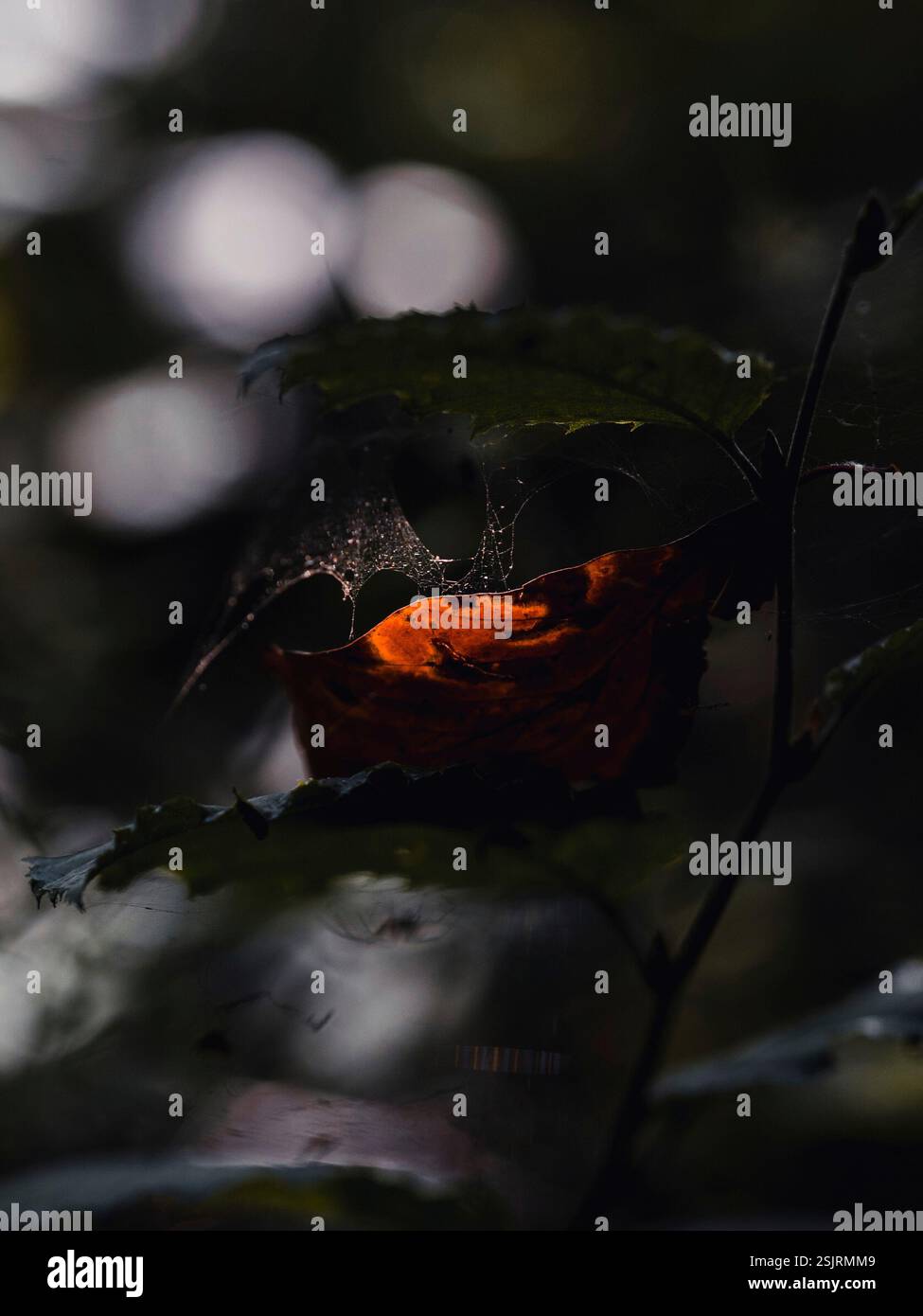 A ray of sunlight lights up a spider's web and a reddish leaf, close-up in the forest Stock Photohttps://www.alamy.com/image-license-details/?v=1https://www.alamy.com/a-ray-of-sunlight-lights-up-a-spiders-web-and-a-reddish-leaf-close-up-in-the-forest-image648368569.html
A ray of sunlight lights up a spider's web and a reddish leaf, close-up in the forest Stock Photohttps://www.alamy.com/image-license-details/?v=1https://www.alamy.com/a-ray-of-sunlight-lights-up-a-spiders-web-and-a-reddish-leaf-close-up-in-the-forest-image648368569.htmlRM2SJRMM9–A ray of sunlight lights up a spider's web and a reddish leaf, close-up in the forest
 Reddish parachute spider, Poecilotheria rufilata, Theraphosidae, Pepper wildlife sanctuary, Kerala. India Stock Photohttps://www.alamy.com/image-license-details/?v=1https://www.alamy.com/stock-photo-reddish-parachute-spider-poecilotheria-rufilata-theraphosidae-pepper-80532013.html
Reddish parachute spider, Poecilotheria rufilata, Theraphosidae, Pepper wildlife sanctuary, Kerala. India Stock Photohttps://www.alamy.com/image-license-details/?v=1https://www.alamy.com/stock-photo-reddish-parachute-spider-poecilotheria-rufilata-theraphosidae-pepper-80532013.htmlRFEK0FB9–Reddish parachute spider, Poecilotheria rufilata, Theraphosidae, Pepper wildlife sanctuary, Kerala. India
 Halloween holiday background with pumpkins and black spiders on a dark wooden table. Close-up natural reddish pumpkins on vintage boards for Halloween Stock Photohttps://www.alamy.com/image-license-details/?v=1https://www.alamy.com/halloween-holiday-background-with-pumpkins-and-black-spiders-on-a-dark-wooden-table-close-up-natural-reddish-pumpkins-on-vintage-boards-for-halloween-image364801730.html
Halloween holiday background with pumpkins and black spiders on a dark wooden table. Close-up natural reddish pumpkins on vintage boards for Halloween Stock Photohttps://www.alamy.com/image-license-details/?v=1https://www.alamy.com/halloween-holiday-background-with-pumpkins-and-black-spiders-on-a-dark-wooden-table-close-up-natural-reddish-pumpkins-on-vintage-boards-for-halloween-image364801730.htmlRF2C5E496–Halloween holiday background with pumpkins and black spiders on a dark wooden table. Close-up natural reddish pumpkins on vintage boards for Halloween
 Close up of large reddish brown female huntsman spider, with row of eyes on brown head, lying on white silken egg sac Stock Photohttps://www.alamy.com/image-license-details/?v=1https://www.alamy.com/stock-photo-close-up-of-large-reddish-brown-female-huntsman-spider-with-row-of-76228325.html
Close up of large reddish brown female huntsman spider, with row of eyes on brown head, lying on white silken egg sac Stock Photohttps://www.alamy.com/image-license-details/?v=1https://www.alamy.com/stock-photo-close-up-of-large-reddish-brown-female-huntsman-spider-with-row-of-76228325.htmlRMEC0E05–Close up of large reddish brown female huntsman spider, with row of eyes on brown head, lying on white silken egg sac
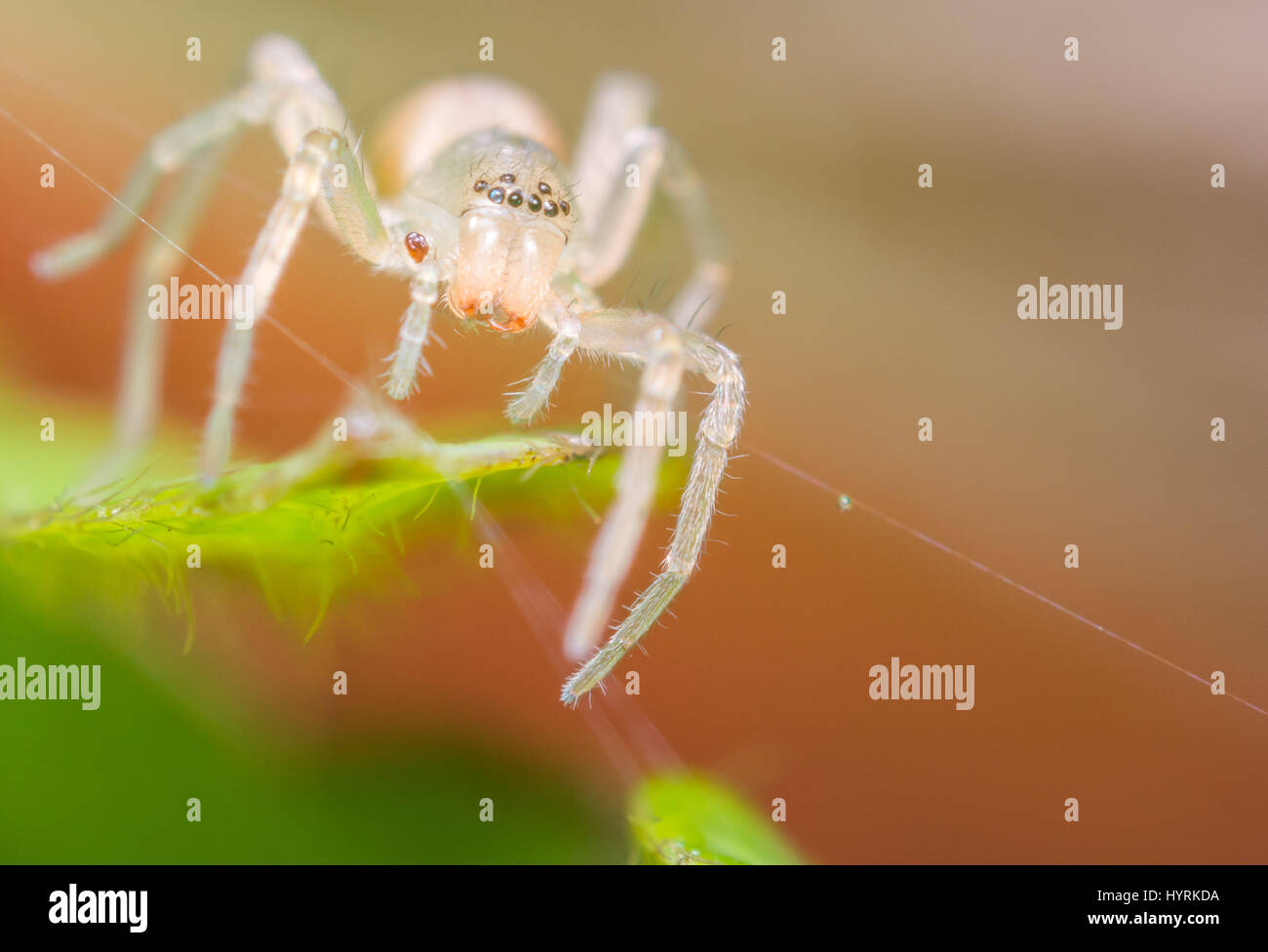 The white walker - sac spider Stock Photohttps://www.alamy.com/image-license-details/?v=1https://www.alamy.com/stock-photo-the-white-walker-sac-spider-137588454.html
The white walker - sac spider Stock Photohttps://www.alamy.com/image-license-details/?v=1https://www.alamy.com/stock-photo-the-white-walker-sac-spider-137588454.htmlRFHYRKDA–The white walker - sac spider
 crab spider (Thomisidae sp.) in the thorns of a milk thistle Photographed in the Lower Galilee, Israel in March Stock Photohttps://www.alamy.com/image-license-details/?v=1https://www.alamy.com/crab-spider-thomisidae-sp-in-the-thorns-of-a-milk-thistle-photographed-in-the-lower-galilee-israel-in-march-image609808567.html
crab spider (Thomisidae sp.) in the thorns of a milk thistle Photographed in the Lower Galilee, Israel in March Stock Photohttps://www.alamy.com/image-license-details/?v=1https://www.alamy.com/crab-spider-thomisidae-sp-in-the-thorns-of-a-milk-thistle-photographed-in-the-lower-galilee-israel-in-march-image609808567.htmlRF2XC351B–crab spider (Thomisidae sp.) in the thorns of a milk thistle Photographed in the Lower Galilee, Israel in March
 variety legged Red Spider on Green Leafs Stock Photohttps://www.alamy.com/image-license-details/?v=1https://www.alamy.com/stock-photo-variety-legged-red-spider-on-green-leafs-50964727.html
variety legged Red Spider on Green Leafs Stock Photohttps://www.alamy.com/image-license-details/?v=1https://www.alamy.com/stock-photo-variety-legged-red-spider-on-green-leafs-50964727.htmlRFCXWJ0R–variety legged Red Spider on Green Leafs
 Reddish egret fishing Stock Photohttps://www.alamy.com/image-license-details/?v=1https://www.alamy.com/reddish-egret-fishing-image69649071.html
Reddish egret fishing Stock Photohttps://www.alamy.com/image-license-details/?v=1https://www.alamy.com/reddish-egret-fishing-image69649071.htmlRME18P2R–Reddish egret fishing
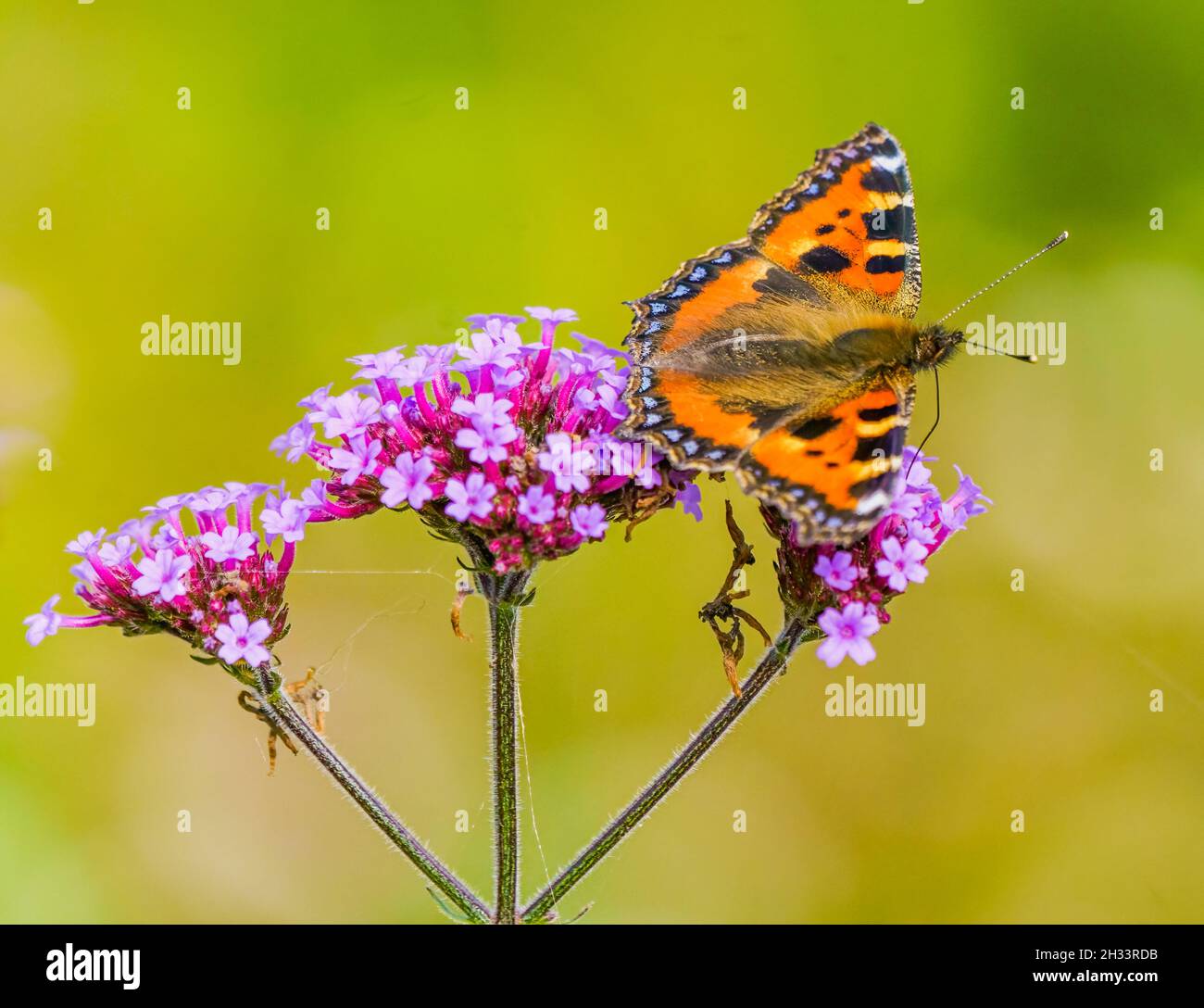 Small Tortoiseshell Butterfly Feeding on Wild Flower Stock Photohttps://www.alamy.com/image-license-details/?v=1https://www.alamy.com/small-tortoiseshell-butterfly-feeding-on-wild-flower-image449397799.html
Small Tortoiseshell Butterfly Feeding on Wild Flower Stock Photohttps://www.alamy.com/image-license-details/?v=1https://www.alamy.com/small-tortoiseshell-butterfly-feeding-on-wild-flower-image449397799.htmlRF2H33RDB–Small Tortoiseshell Butterfly Feeding on Wild Flower
 Black grapes on the vine Stock Photohttps://www.alamy.com/image-license-details/?v=1https://www.alamy.com/black-grapes-on-the-vine-image209414058.html
Black grapes on the vine Stock Photohttps://www.alamy.com/image-license-details/?v=1https://www.alamy.com/black-grapes-on-the-vine-image209414058.htmlRFP4KHNE–Black grapes on the vine
 Male red cardinal in early spring Stock Photohttps://www.alamy.com/image-license-details/?v=1https://www.alamy.com/male-red-cardinal-in-early-spring-image364055040.html
Male red cardinal in early spring Stock Photohttps://www.alamy.com/image-license-details/?v=1https://www.alamy.com/male-red-cardinal-in-early-spring-image364055040.htmlRF2C483WM–Male red cardinal in early spring
 Giant Golden Orb-web Spider (Nephila pilipes) waiting for prey Stock Photohttps://www.alamy.com/image-license-details/?v=1https://www.alamy.com/giant-golden-orb-web-spider-nephila-pilipes-waiting-for-prey-image414477121.html
Giant Golden Orb-web Spider (Nephila pilipes) waiting for prey Stock Photohttps://www.alamy.com/image-license-details/?v=1https://www.alamy.com/giant-golden-orb-web-spider-nephila-pilipes-waiting-for-prey-image414477121.htmlRF2F291P9–Giant Golden Orb-web Spider (Nephila pilipes) waiting for prey
 A side view of a female Scorpion Fly, Panorpa Communis, retie on a leaf whilst eating something. Closeup with good details against a leaf. Natural. Stock Photohttps://www.alamy.com/image-license-details/?v=1https://www.alamy.com/a-side-view-of-a-female-scorpion-fly-panorpa-communis-retie-on-a-leaf-whilst-eating-something-closeup-with-good-details-against-a-leaf-natural-image628141136.html
A side view of a female Scorpion Fly, Panorpa Communis, retie on a leaf whilst eating something. Closeup with good details against a leaf. Natural. Stock Photohttps://www.alamy.com/image-license-details/?v=1https://www.alamy.com/a-side-view-of-a-female-scorpion-fly-panorpa-communis-retie-on-a-leaf-whilst-eating-something-closeup-with-good-details-against-a-leaf-natural-image628141136.htmlRF2YDX8C0–A side view of a female Scorpion Fly, Panorpa Communis, retie on a leaf whilst eating something. Closeup with good details against a leaf. Natural.
 drop in net Stock Photohttps://www.alamy.com/image-license-details/?v=1https://www.alamy.com/stock-photo-drop-in-net-114681398.html
drop in net Stock Photohttps://www.alamy.com/image-license-details/?v=1https://www.alamy.com/stock-photo-drop-in-net-114681398.htmlRFGJG586–drop in net
 A well focussed female Scorpion Fly, Panorpa Communis resting on a leaf. Closeup with good details against a natural green background. Stock Photohttps://www.alamy.com/image-license-details/?v=1https://www.alamy.com/a-well-focussed-female-scorpion-fly-panorpa-communis-resting-on-a-leaf-closeup-with-good-details-against-a-natural-green-background-image628141143.html
A well focussed female Scorpion Fly, Panorpa Communis resting on a leaf. Closeup with good details against a natural green background. Stock Photohttps://www.alamy.com/image-license-details/?v=1https://www.alamy.com/a-well-focussed-female-scorpion-fly-panorpa-communis-resting-on-a-leaf-closeup-with-good-details-against-a-natural-green-background-image628141143.htmlRF2YDX8C7–A well focussed female Scorpion Fly, Panorpa Communis resting on a leaf. Closeup with good details against a natural green background.
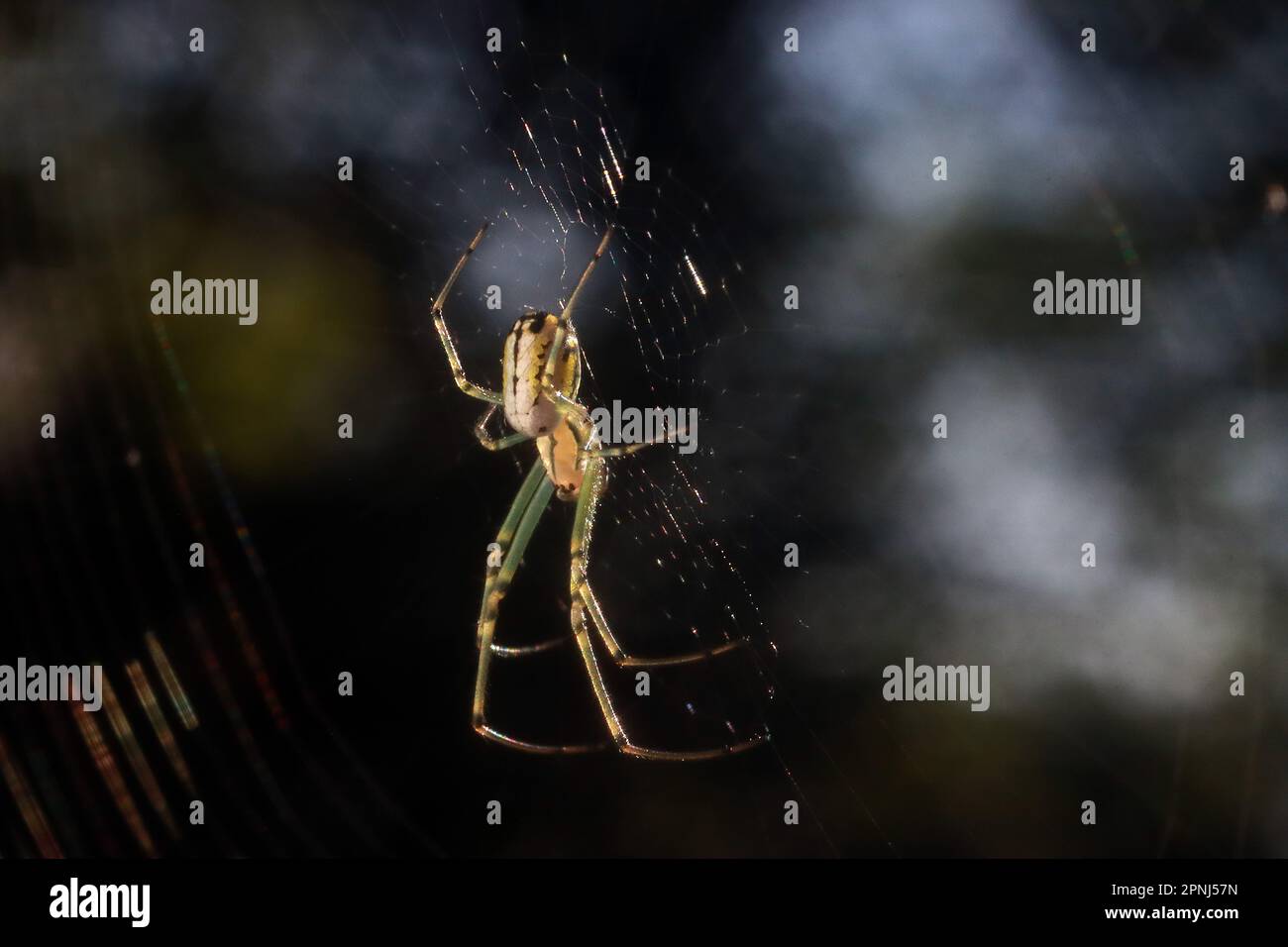 Cary, North Carolina, USA. 19th Apr, 2023. An orchard orbweaver, one of the most common spiders in the eastern United States. They are occasionally mistaken for black widow spiders because of the reddish-orange spots. (Credit Image: © Bob Karp/ZUMA Press Wire) EDITORIAL USAGE ONLY! Not for Commercial USAGE! Stock Photohttps://www.alamy.com/image-license-details/?v=1https://www.alamy.com/cary-north-carolina-usa-19th-apr-2023-an-orchard-orbweaver-one-of-the-most-common-spiders-in-the-eastern-united-states-they-are-occasionally-mistaken-for-black-widow-spiders-because-of-the-reddish-orange-spots-credit-image-bob-karpzuma-press-wire-editorial-usage-only!-not-for-commercial-usage!-image546828457.html
Cary, North Carolina, USA. 19th Apr, 2023. An orchard orbweaver, one of the most common spiders in the eastern United States. They are occasionally mistaken for black widow spiders because of the reddish-orange spots. (Credit Image: © Bob Karp/ZUMA Press Wire) EDITORIAL USAGE ONLY! Not for Commercial USAGE! Stock Photohttps://www.alamy.com/image-license-details/?v=1https://www.alamy.com/cary-north-carolina-usa-19th-apr-2023-an-orchard-orbweaver-one-of-the-most-common-spiders-in-the-eastern-united-states-they-are-occasionally-mistaken-for-black-widow-spiders-because-of-the-reddish-orange-spots-credit-image-bob-karpzuma-press-wire-editorial-usage-only!-not-for-commercial-usage!-image546828457.htmlRM2PNJ57N–Cary, North Carolina, USA. 19th Apr, 2023. An orchard orbweaver, one of the most common spiders in the eastern United States. They are occasionally mistaken for black widow spiders because of the reddish-orange spots. (Credit Image: © Bob Karp/ZUMA Press Wire) EDITORIAL USAGE ONLY! Not for Commercial USAGE!
 A Scorpion Fly, Panorpa Communis resting on a bullrush. A well focussed closeup with good details of this adult male fly. A natural green background. Stock Photohttps://www.alamy.com/image-license-details/?v=1https://www.alamy.com/a-scorpion-fly-panorpa-communis-resting-on-a-bullrush-a-well-focussed-closeup-with-good-details-of-this-adult-male-fly-a-natural-green-background-image628141140.html
A Scorpion Fly, Panorpa Communis resting on a bullrush. A well focussed closeup with good details of this adult male fly. A natural green background. Stock Photohttps://www.alamy.com/image-license-details/?v=1https://www.alamy.com/a-scorpion-fly-panorpa-communis-resting-on-a-bullrush-a-well-focussed-closeup-with-good-details-of-this-adult-male-fly-a-natural-green-background-image628141140.htmlRF2YDX8C4–A Scorpion Fly, Panorpa Communis resting on a bullrush. A well focussed closeup with good details of this adult male fly. A natural green background.
 spider Stock Photohttps://www.alamy.com/image-license-details/?v=1https://www.alamy.com/spider-image225448745.html
spider Stock Photohttps://www.alamy.com/image-license-details/?v=1https://www.alamy.com/spider-image225448745.htmlRFR2P24W–spider
 One Argiope bruennichi (wasp spider)sitting on a dry reddish plant Stock Photohttps://www.alamy.com/image-license-details/?v=1https://www.alamy.com/one-argiope-bruennichi-wasp-spidersitting-on-a-dry-reddish-plant-image645122917.html
One Argiope bruennichi (wasp spider)sitting on a dry reddish plant Stock Photohttps://www.alamy.com/image-license-details/?v=1https://www.alamy.com/one-argiope-bruennichi-wasp-spidersitting-on-a-dry-reddish-plant-image645122917.htmlRM2SDFTT5–One Argiope bruennichi (wasp spider)sitting on a dry reddish plant
 A side view of a male Scorpion Fly, Panorpa Communis, standing on a leaf and eating something. Close-up, well focussed with a natural green background. Stock Photohttps://www.alamy.com/image-license-details/?v=1https://www.alamy.com/a-side-view-of-a-male-scorpion-fly-panorpa-communis-standing-on-a-leaf-and-eating-something-close-up-well-focussed-with-a-natural-green-background-image628141138.html
A side view of a male Scorpion Fly, Panorpa Communis, standing on a leaf and eating something. Close-up, well focussed with a natural green background. Stock Photohttps://www.alamy.com/image-license-details/?v=1https://www.alamy.com/a-side-view-of-a-male-scorpion-fly-panorpa-communis-standing-on-a-leaf-and-eating-something-close-up-well-focussed-with-a-natural-green-background-image628141138.htmlRF2YDX8C2–A side view of a male Scorpion Fly, Panorpa Communis, standing on a leaf and eating something. Close-up, well focussed with a natural green background.
 Reddish parachute spider, Poecilotheria rufilata, Theraphosidae, Pepper wildlife sanctuary, Kerala. India Stock Photohttps://www.alamy.com/image-license-details/?v=1https://www.alamy.com/stock-photo-reddish-parachute-spider-poecilotheria-rufilata-theraphosidae-pepper-80532009.html
Reddish parachute spider, Poecilotheria rufilata, Theraphosidae, Pepper wildlife sanctuary, Kerala. India Stock Photohttps://www.alamy.com/image-license-details/?v=1https://www.alamy.com/stock-photo-reddish-parachute-spider-poecilotheria-rufilata-theraphosidae-pepper-80532009.htmlRFEK0FB5–Reddish parachute spider, Poecilotheria rufilata, Theraphosidae, Pepper wildlife sanctuary, Kerala. India
 Sarracenia Purpurea (Purple Pitcher) plant leaves on an abstract composition. Stock Photohttps://www.alamy.com/image-license-details/?v=1https://www.alamy.com/sarracenia-purpurea-purple-pitcher-plant-leaves-on-an-abstract-composition-image397108016.html
Sarracenia Purpurea (Purple Pitcher) plant leaves on an abstract composition. Stock Photohttps://www.alamy.com/image-license-details/?v=1https://www.alamy.com/sarracenia-purpurea-purple-pitcher-plant-leaves-on-an-abstract-composition-image397108016.htmlRF2E21R94–Sarracenia Purpurea (Purple Pitcher) plant leaves on an abstract composition.
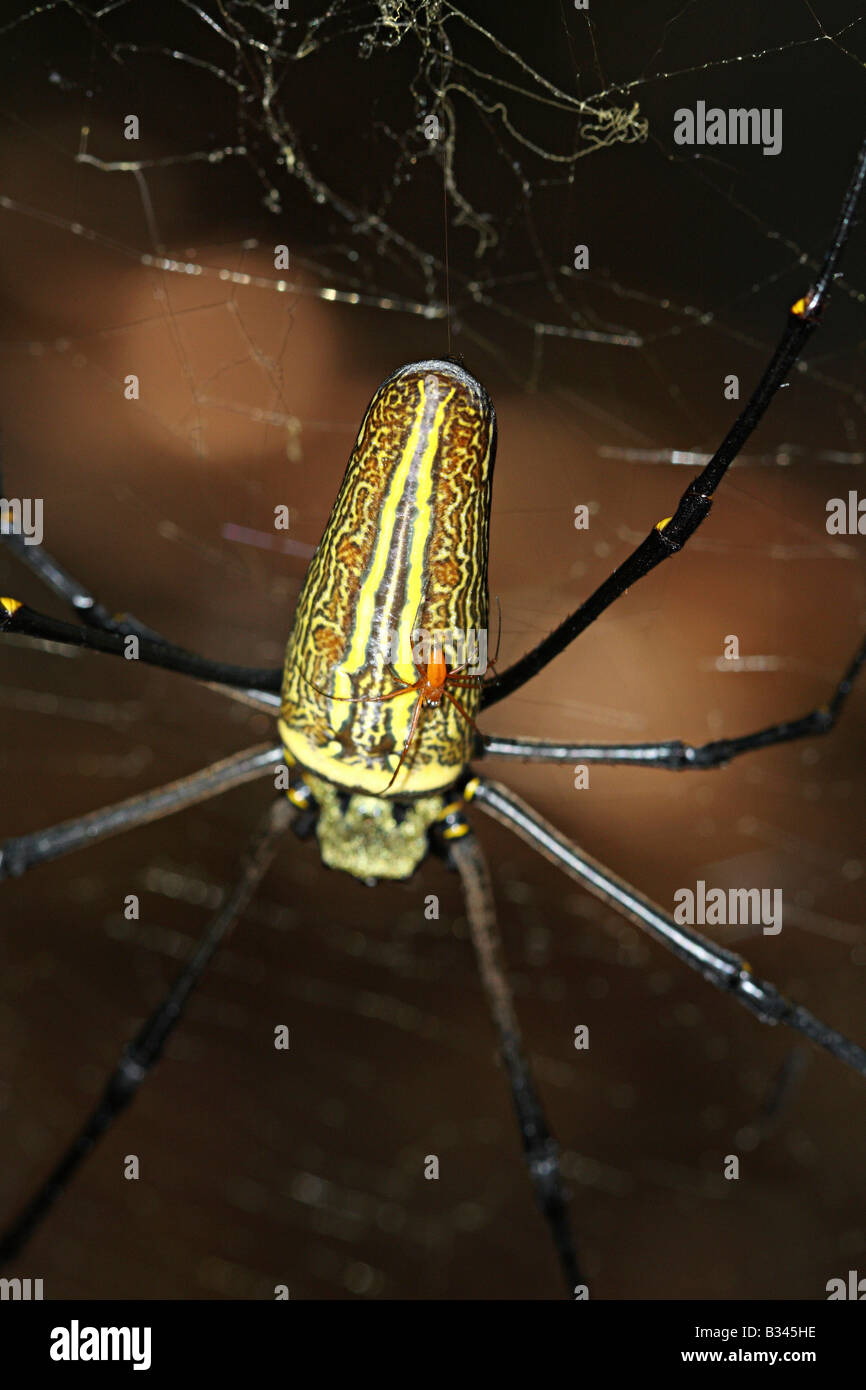 GIANT WOOD SPIDER Nephila philipes. Mating. Adult female is about 2-4 inches. Male grows to 10 mm and is reddish brown color Stock Photohttps://www.alamy.com/image-license-details/?v=1https://www.alamy.com/stock-photo-giant-wood-spider-nephila-philipes-mating-adult-female-is-about-2-19146554.html
GIANT WOOD SPIDER Nephila philipes. Mating. Adult female is about 2-4 inches. Male grows to 10 mm and is reddish brown color Stock Photohttps://www.alamy.com/image-license-details/?v=1https://www.alamy.com/stock-photo-giant-wood-spider-nephila-philipes-mating-adult-female-is-about-2-19146554.htmlRFB345HE–GIANT WOOD SPIDER Nephila philipes. Mating. Adult female is about 2-4 inches. Male grows to 10 mm and is reddish brown color
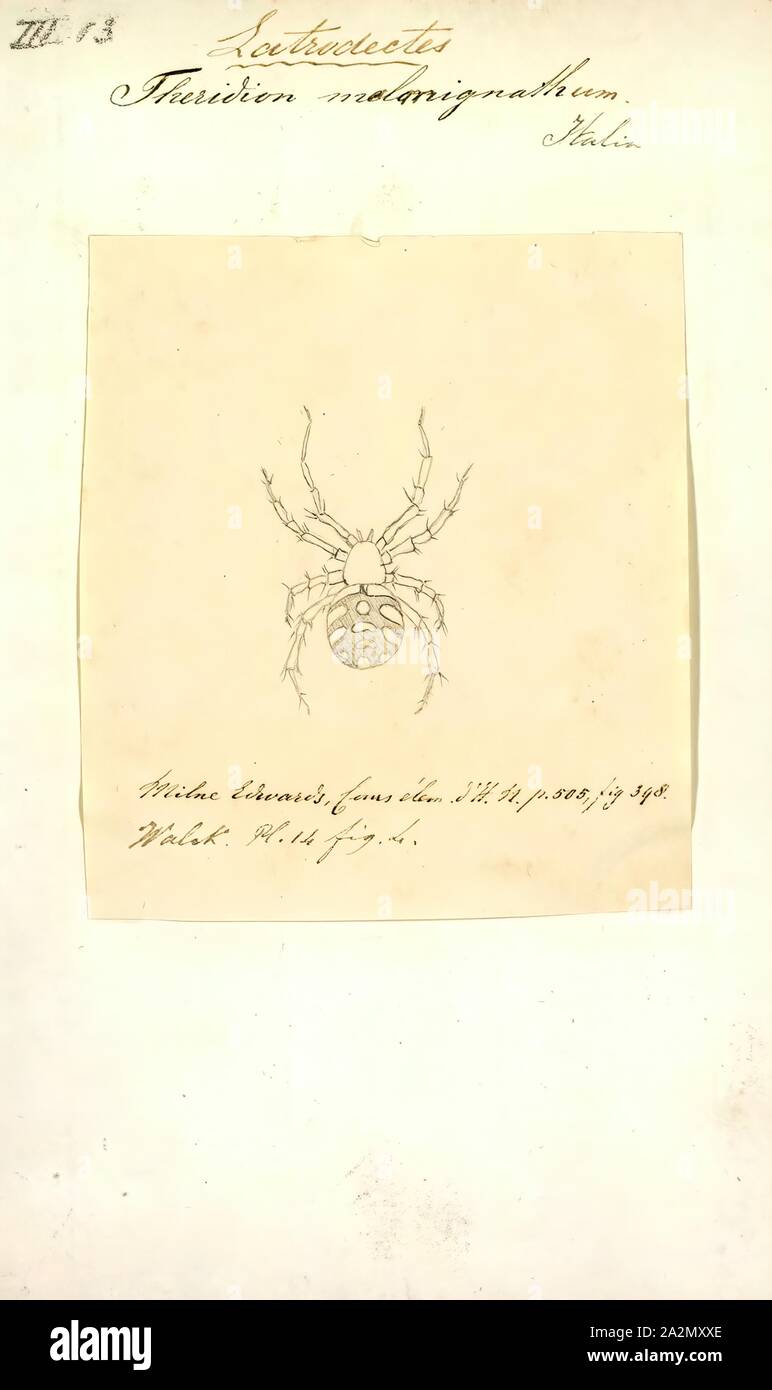 Latrodectus, Print, Latrodectus is a broadly distributed genus of spiders, which is composed of both black widow spiders and brown widow spiders. A member of the Theridiidae family, this genus contains 31 species, including the North American black widows (L. mactans, L. hesperus, and L. variolus), the European black widow (L. tredecimguttatus), the Australian redback black widow (L. hasseltii) and the button spiders of Southern Africa. Species vary widely in size. In most cases, the females are dark-coloured and readily identifiable by reddish markings on the abdomen, which are often Stock Photohttps://www.alamy.com/image-license-details/?v=1https://www.alamy.com/latrodectus-print-latrodectus-is-a-broadly-distributed-genus-of-spiders-which-is-composed-of-both-black-widow-spiders-and-brown-widow-spiders-a-member-of-the-theridiidae-family-this-genus-contains-31-species-including-the-north-american-black-widows-l-mactans-l-hesperus-and-l-variolus-the-european-black-widow-l-tredecimguttatus-the-australian-redback-black-widow-l-hasseltii-and-the-button-spiders-of-southern-africa-species-vary-widely-in-size-in-most-cases-the-females-are-dark-coloured-and-readily-identifiable-by-reddish-markings-on-the-abdomen-which-are-often-image328686470.html
Latrodectus, Print, Latrodectus is a broadly distributed genus of spiders, which is composed of both black widow spiders and brown widow spiders. A member of the Theridiidae family, this genus contains 31 species, including the North American black widows (L. mactans, L. hesperus, and L. variolus), the European black widow (L. tredecimguttatus), the Australian redback black widow (L. hasseltii) and the button spiders of Southern Africa. Species vary widely in size. In most cases, the females are dark-coloured and readily identifiable by reddish markings on the abdomen, which are often Stock Photohttps://www.alamy.com/image-license-details/?v=1https://www.alamy.com/latrodectus-print-latrodectus-is-a-broadly-distributed-genus-of-spiders-which-is-composed-of-both-black-widow-spiders-and-brown-widow-spiders-a-member-of-the-theridiidae-family-this-genus-contains-31-species-including-the-north-american-black-widows-l-mactans-l-hesperus-and-l-variolus-the-european-black-widow-l-tredecimguttatus-the-australian-redback-black-widow-l-hasseltii-and-the-button-spiders-of-southern-africa-species-vary-widely-in-size-in-most-cases-the-females-are-dark-coloured-and-readily-identifiable-by-reddish-markings-on-the-abdomen-which-are-often-image328686470.htmlRM2A2MXXE–Latrodectus, Print, Latrodectus is a broadly distributed genus of spiders, which is composed of both black widow spiders and brown widow spiders. A member of the Theridiidae family, this genus contains 31 species, including the North American black widows (L. mactans, L. hesperus, and L. variolus), the European black widow (L. tredecimguttatus), the Australian redback black widow (L. hasseltii) and the button spiders of Southern Africa. Species vary widely in size. In most cases, the females are dark-coloured and readily identifiable by reddish markings on the abdomen, which are often
 Small red vascular dilatation on the skin of the thorax from which capillaries radiate, caused by cirrhosis of the liver Stock Photohttps://www.alamy.com/image-license-details/?v=1https://www.alamy.com/stock-photo-small-red-vascular-dilatation-on-the-skin-of-the-thorax-from-which-31079826.html
Small red vascular dilatation on the skin of the thorax from which capillaries radiate, caused by cirrhosis of the liver Stock Photohttps://www.alamy.com/image-license-details/?v=1https://www.alamy.com/stock-photo-small-red-vascular-dilatation-on-the-skin-of-the-thorax-from-which-31079826.htmlRMBPFPHP–Small red vascular dilatation on the skin of the thorax from which capillaries radiate, caused by cirrhosis of the liver
 This is a photograph of the Loxosceles laeta, the ?, 1962. Chilean recluse?. spider of Central South America. The ?. Chilean recluse?, Loxosceles laeta, is the most toxic species of Loxosceles spiders. This recluse can grow to 25 mm in length, and is pale yellow to reddish-brown. Image courtesy CDC/Harold G. Scott. Stock Photohttps://www.alamy.com/image-license-details/?v=1https://www.alamy.com/stock-image-this-is-a-photograph-of-the-loxosceles-laeta-the-1962-chilean-recluse-169017862.html
This is a photograph of the Loxosceles laeta, the ?, 1962. Chilean recluse?. spider of Central South America. The ?. Chilean recluse?, Loxosceles laeta, is the most toxic species of Loxosceles spiders. This recluse can grow to 25 mm in length, and is pale yellow to reddish-brown. Image courtesy CDC/Harold G. Scott. Stock Photohttps://www.alamy.com/image-license-details/?v=1https://www.alamy.com/stock-image-this-is-a-photograph-of-the-loxosceles-laeta-the-1962-chilean-recluse-169017862.htmlRMKPYC06–This is a photograph of the Loxosceles laeta, the ?, 1962. Chilean recluse?. spider of Central South America. The ?. Chilean recluse?, Loxosceles laeta, is the most toxic species of Loxosceles spiders. This recluse can grow to 25 mm in length, and is pale yellow to reddish-brown. Image courtesy CDC/Harold G. Scott.
 Typical Spiders (Araneomorphae), Arachnida, Oakwell Farms Pkwy, San Antonio, TX, US, Tiny reddish brown spider on my wall, maybe 1 mm long Stock Photohttps://www.alamy.com/image-license-details/?v=1https://www.alamy.com/typical-spiders-araneomorphae-arachnida-oakwell-farms-pkwy-san-antonio-tx-us-tiny-reddish-brown-spider-on-my-wall-maybe-1-mm-long-image646428711.html
Typical Spiders (Araneomorphae), Arachnida, Oakwell Farms Pkwy, San Antonio, TX, US, Tiny reddish brown spider on my wall, maybe 1 mm long Stock Photohttps://www.alamy.com/image-license-details/?v=1https://www.alamy.com/typical-spiders-araneomorphae-arachnida-oakwell-farms-pkwy-san-antonio-tx-us-tiny-reddish-brown-spider-on-my-wall-maybe-1-mm-long-image646428711.htmlRM2SFKABK–Typical Spiders (Araneomorphae), Arachnida, Oakwell Farms Pkwy, San Antonio, TX, US, Tiny reddish brown spider on my wall, maybe 1 mm long
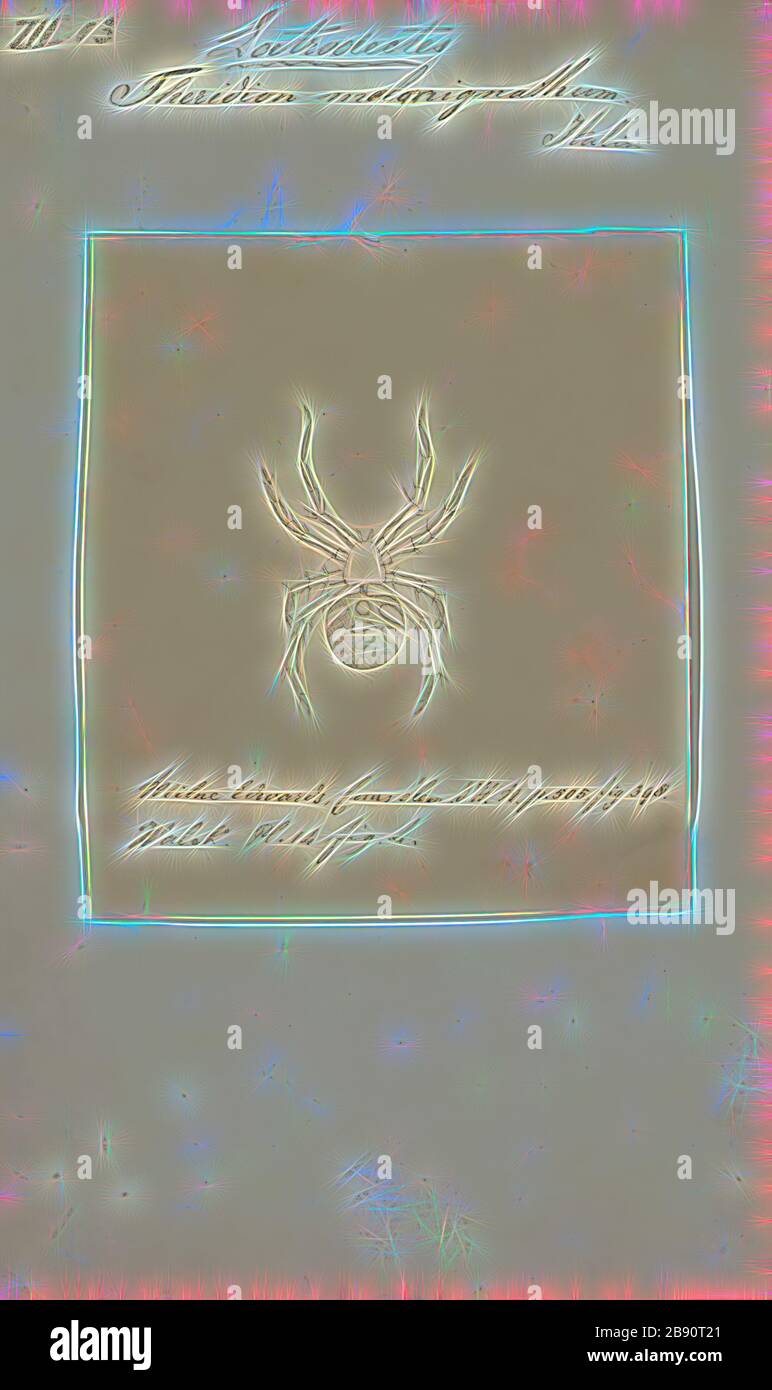 Latrodectus, Print, Latrodectus is a broadly distributed genus of spiders, which is composed of both black widow spiders and brown widow spiders. A member of the Theridiidae family, this genus contains 31 species, including the North American black widows (L. mactans, L. hesperus, and L. variolus), the European black widow (L. tredecimguttatus), the Australian redback black widow (L. hasseltii) and the button spiders of Southern Africa. Species vary widely in size. In most cases, the females are dark-coloured and readily identifiable by reddish markings on the abdomen, which are often hourglas Stock Photohttps://www.alamy.com/image-license-details/?v=1https://www.alamy.com/latrodectus-print-latrodectus-is-a-broadly-distributed-genus-of-spiders-which-is-composed-of-both-black-widow-spiders-and-brown-widow-spiders-a-member-of-the-theridiidae-family-this-genus-contains-31-species-including-the-north-american-black-widows-l-mactans-l-hesperus-and-l-variolus-the-european-black-widow-l-tredecimguttatus-the-australian-redback-black-widow-l-hasseltii-and-the-button-spiders-of-southern-africa-species-vary-widely-in-size-in-most-cases-the-females-are-dark-coloured-and-readily-identifiable-by-reddish-markings-on-the-abdomen-which-are-often-hourglas-image349758137.html
Latrodectus, Print, Latrodectus is a broadly distributed genus of spiders, which is composed of both black widow spiders and brown widow spiders. A member of the Theridiidae family, this genus contains 31 species, including the North American black widows (L. mactans, L. hesperus, and L. variolus), the European black widow (L. tredecimguttatus), the Australian redback black widow (L. hasseltii) and the button spiders of Southern Africa. Species vary widely in size. In most cases, the females are dark-coloured and readily identifiable by reddish markings on the abdomen, which are often hourglas Stock Photohttps://www.alamy.com/image-license-details/?v=1https://www.alamy.com/latrodectus-print-latrodectus-is-a-broadly-distributed-genus-of-spiders-which-is-composed-of-both-black-widow-spiders-and-brown-widow-spiders-a-member-of-the-theridiidae-family-this-genus-contains-31-species-including-the-north-american-black-widows-l-mactans-l-hesperus-and-l-variolus-the-european-black-widow-l-tredecimguttatus-the-australian-redback-black-widow-l-hasseltii-and-the-button-spiders-of-southern-africa-species-vary-widely-in-size-in-most-cases-the-females-are-dark-coloured-and-readily-identifiable-by-reddish-markings-on-the-abdomen-which-are-often-hourglas-image349758137.htmlRF2B90T21–Latrodectus, Print, Latrodectus is a broadly distributed genus of spiders, which is composed of both black widow spiders and brown widow spiders. A member of the Theridiidae family, this genus contains 31 species, including the North American black widows (L. mactans, L. hesperus, and L. variolus), the European black widow (L. tredecimguttatus), the Australian redback black widow (L. hasseltii) and the button spiders of Southern Africa. Species vary widely in size. In most cases, the females are dark-coloured and readily identifiable by reddish markings on the abdomen, which are often hourglas
 Black grapes on the vine Stock Photohttps://www.alamy.com/image-license-details/?v=1https://www.alamy.com/black-grapes-on-the-vine-image552713573.html
Black grapes on the vine Stock Photohttps://www.alamy.com/image-license-details/?v=1https://www.alamy.com/black-grapes-on-the-vine-image552713573.htmlRF2R367PD–Black grapes on the vine
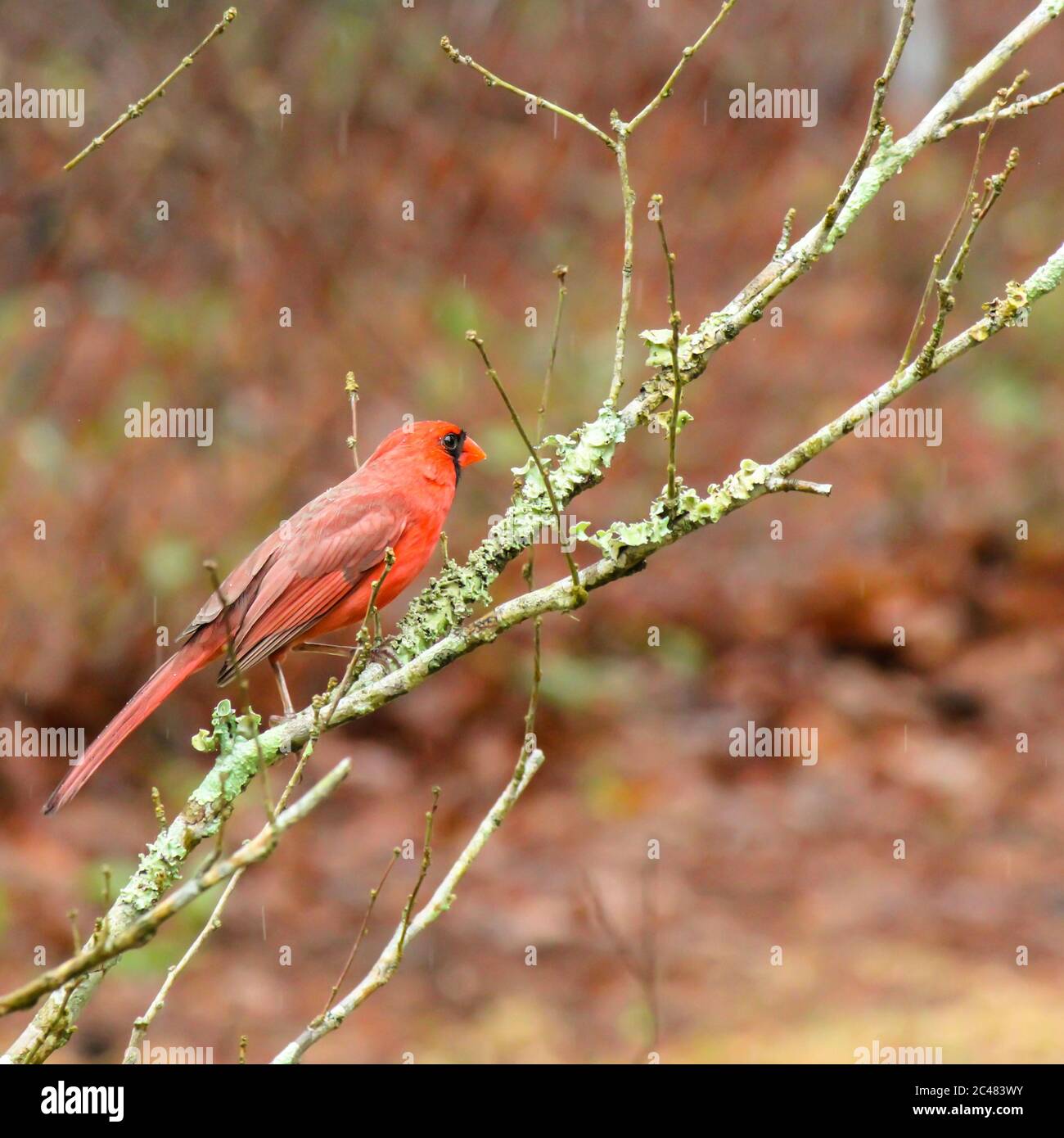 Male cardinal perched on lichen covered stems in spring Stock Photohttps://www.alamy.com/image-license-details/?v=1https://www.alamy.com/male-cardinal-perched-on-lichen-covered-stems-in-spring-image364055047.html
Male cardinal perched on lichen covered stems in spring Stock Photohttps://www.alamy.com/image-license-details/?v=1https://www.alamy.com/male-cardinal-perched-on-lichen-covered-stems-in-spring-image364055047.htmlRF2C483WY–Male cardinal perched on lichen covered stems in spring
 Archive image from page 183 of The culture and diseases of. The culture and diseases of the sweet pea culturediseasespea0taub Year: 1917 ( 132 DISEASES OF THE SWEET PEA FIG. 21. THE RED SPIDER, ENLARGED. (aFTER BANKS.) tack both leaves and stems, the method of attack and the resulting injury somewhat resembling that of mites. However, the spots caused by red spiders are reddish in- stead of a pale white. Life History. The adult female is usu- ally brick red in color and the male is red- dish amber. Frequently, however, the color of the red spider changes according to locality and food plan Stock Photohttps://www.alamy.com/image-license-details/?v=1https://www.alamy.com/archive-image-from-page-183-of-the-culture-and-diseases-of-the-culture-and-diseases-of-the-sweet-pea-culturediseasespea0taub-year-1917-132-diseases-of-the-sweet-pea-fig-21-the-red-spider-enlarged-after-banks-tack-both-leaves-and-stems-the-method-of-attack-and-the-resulting-injury-somewhat-resembling-that-of-mites-however-the-spots-caused-by-red-spiders-are-reddish-in-stead-of-a-pale-white-life-history-the-adult-female-is-usu-ally-brick-red-in-color-and-the-male-is-red-dish-amber-frequently-however-the-color-of-the-red-spider-changes-according-to-locality-and-food-plan-image264048829.html
Archive image from page 183 of The culture and diseases of. The culture and diseases of the sweet pea culturediseasespea0taub Year: 1917 ( 132 DISEASES OF THE SWEET PEA FIG. 21. THE RED SPIDER, ENLARGED. (aFTER BANKS.) tack both leaves and stems, the method of attack and the resulting injury somewhat resembling that of mites. However, the spots caused by red spiders are reddish in- stead of a pale white. Life History. The adult female is usu- ally brick red in color and the male is red- dish amber. Frequently, however, the color of the red spider changes according to locality and food plan Stock Photohttps://www.alamy.com/image-license-details/?v=1https://www.alamy.com/archive-image-from-page-183-of-the-culture-and-diseases-of-the-culture-and-diseases-of-the-sweet-pea-culturediseasespea0taub-year-1917-132-diseases-of-the-sweet-pea-fig-21-the-red-spider-enlarged-after-banks-tack-both-leaves-and-stems-the-method-of-attack-and-the-resulting-injury-somewhat-resembling-that-of-mites-however-the-spots-caused-by-red-spiders-are-reddish-in-stead-of-a-pale-white-life-history-the-adult-female-is-usu-ally-brick-red-in-color-and-the-male-is-red-dish-amber-frequently-however-the-color-of-the-red-spider-changes-according-to-locality-and-food-plan-image264048829.htmlRMW9GCY9–Archive image from page 183 of The culture and diseases of. The culture and diseases of the sweet pea culturediseasespea0taub Year: 1917 ( 132 DISEASES OF THE SWEET PEA FIG. 21. THE RED SPIDER, ENLARGED. (aFTER BANKS.) tack both leaves and stems, the method of attack and the resulting injury somewhat resembling that of mites. However, the spots caused by red spiders are reddish in- stead of a pale white. Life History. The adult female is usu- ally brick red in color and the male is red- dish amber. Frequently, however, the color of the red spider changes according to locality and food plan
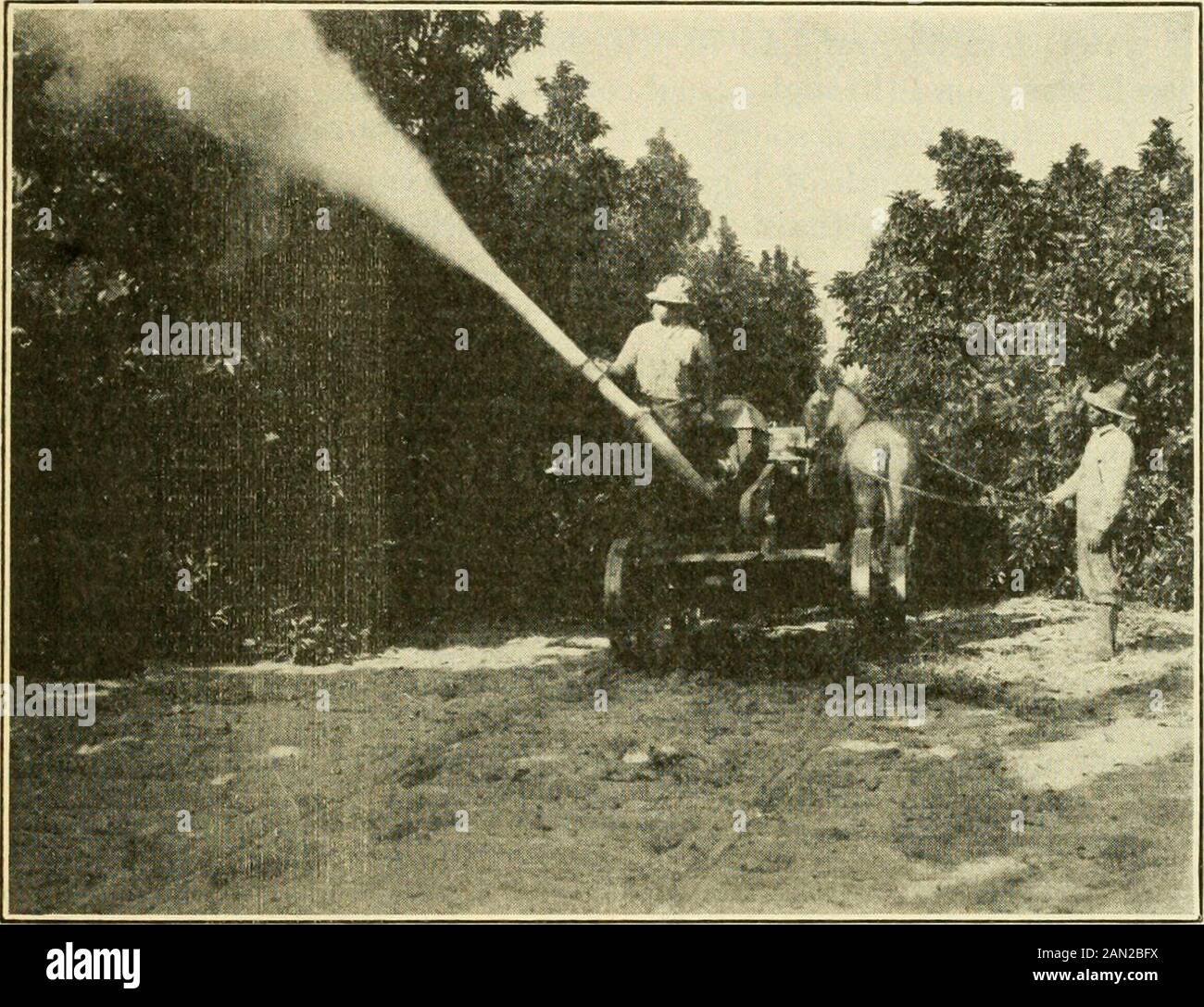 The red spider (Tetranychus yothersi McG.) on the avocado . Fir -Lcptothrips mali: Adult thrips. Cieatl.v enlarged. the former, the abdomen is black, and the head reddish. It is not a very abundant species and is not as beneficial as the former beetle. Leptothrips mali Hinds is a large black thrips (fig. 7) predatory in both the larva and adult stages, and when present is very acti^-e THE RED SPIDER. ON THE AVOCADO, 11 on the foliage in searc-li of red spiders. It is not very abundant atany time. SPRAYING EXPERIMENTS. A number of insecticides have been tried out to ascertain their rela-tive me Stock Photohttps://www.alamy.com/image-license-details/?v=1https://www.alamy.com/the-red-spider-tetranychus-yothersi-mcg-on-the-avocado-fir-lcptothrips-mali-adult-thrips-cieatlv-enlarged-the-former-the-abdomen-is-black-and-the-head-reddish-it-is-not-a-very-abundant-species-and-is-not-as-beneficial-as-the-former-beetle-leptothrips-mali-hinds-is-a-large-black-thrips-fig-7-predatory-in-both-the-larva-and-adult-stages-and-when-present-is-very-acti-e-the-red-spider-on-the-avocado-11-on-the-foliage-in-searc-li-of-red-spiders-it-is-not-very-abundant-atany-time-spraying-experiments-a-number-of-insecticides-have-been-tried-out-to-ascertain-their-rela-tive-me-image339957742.html
The red spider (Tetranychus yothersi McG.) on the avocado . Fir -Lcptothrips mali: Adult thrips. Cieatl.v enlarged. the former, the abdomen is black, and the head reddish. It is not a very abundant species and is not as beneficial as the former beetle. Leptothrips mali Hinds is a large black thrips (fig. 7) predatory in both the larva and adult stages, and when present is very acti^-e THE RED SPIDER. ON THE AVOCADO, 11 on the foliage in searc-li of red spiders. It is not very abundant atany time. SPRAYING EXPERIMENTS. A number of insecticides have been tried out to ascertain their rela-tive me Stock Photohttps://www.alamy.com/image-license-details/?v=1https://www.alamy.com/the-red-spider-tetranychus-yothersi-mcg-on-the-avocado-fir-lcptothrips-mali-adult-thrips-cieatlv-enlarged-the-former-the-abdomen-is-black-and-the-head-reddish-it-is-not-a-very-abundant-species-and-is-not-as-beneficial-as-the-former-beetle-leptothrips-mali-hinds-is-a-large-black-thrips-fig-7-predatory-in-both-the-larva-and-adult-stages-and-when-present-is-very-acti-e-the-red-spider-on-the-avocado-11-on-the-foliage-in-searc-li-of-red-spiders-it-is-not-very-abundant-atany-time-spraying-experiments-a-number-of-insecticides-have-been-tried-out-to-ascertain-their-rela-tive-me-image339957742.htmlRM2AN2BFX–The red spider (Tetranychus yothersi McG.) on the avocado . Fir -Lcptothrips mali: Adult thrips. Cieatl.v enlarged. the former, the abdomen is black, and the head reddish. It is not a very abundant species and is not as beneficial as the former beetle. Leptothrips mali Hinds is a large black thrips (fig. 7) predatory in both the larva and adult stages, and when present is very acti^-e THE RED SPIDER. ON THE AVOCADO, 11 on the foliage in searc-li of red spiders. It is not very abundant atany time. SPRAYING EXPERIMENTS. A number of insecticides have been tried out to ascertain their rela-tive me
 universe spider reddish celestial bodies globe planet earth world astronomy red Stock Photohttps://www.alamy.com/image-license-details/?v=1https://www.alamy.com/stock-photo-universe-spider-reddish-celestial-bodies-globe-planet-earth-world-140994491.html
universe spider reddish celestial bodies globe planet earth world astronomy red Stock Photohttps://www.alamy.com/image-license-details/?v=1https://www.alamy.com/stock-photo-universe-spider-reddish-celestial-bodies-globe-planet-earth-world-140994491.htmlRFJ5ARWF–universe spider reddish celestial bodies globe planet earth world astronomy red
 Halloween starry night on cemetery red card Stock Photohttps://www.alamy.com/image-license-details/?v=1https://www.alamy.com/stock-photo-halloween-starry-night-on-cemetery-red-card-32068131.html
Halloween starry night on cemetery red card Stock Photohttps://www.alamy.com/image-license-details/?v=1https://www.alamy.com/stock-photo-halloween-starry-night-on-cemetery-red-card-32068131.htmlRFBT4R6B–Halloween starry night on cemetery red card
 Cary, North Carolina, USA. 19th Apr, 2023. An orchard orbweaver, one of the most common spiders in the eastern United States. They are occasionally mistaken for black widow spiders because of the reddish-orange spots. (Credit Image: © Bob Karp/ZUMA Press Wire) EDITORIAL USAGE ONLY! Not for Commercial USAGE! Stock Photohttps://www.alamy.com/image-license-details/?v=1https://www.alamy.com/cary-north-carolina-usa-19th-apr-2023-an-orchard-orbweaver-one-of-the-most-common-spiders-in-the-eastern-united-states-they-are-occasionally-mistaken-for-black-widow-spiders-because-of-the-reddish-orange-spots-credit-image-bob-karpzuma-press-wire-editorial-usage-only!-not-for-commercial-usage!-image546828404.html
Cary, North Carolina, USA. 19th Apr, 2023. An orchard orbweaver, one of the most common spiders in the eastern United States. They are occasionally mistaken for black widow spiders because of the reddish-orange spots. (Credit Image: © Bob Karp/ZUMA Press Wire) EDITORIAL USAGE ONLY! Not for Commercial USAGE! Stock Photohttps://www.alamy.com/image-license-details/?v=1https://www.alamy.com/cary-north-carolina-usa-19th-apr-2023-an-orchard-orbweaver-one-of-the-most-common-spiders-in-the-eastern-united-states-they-are-occasionally-mistaken-for-black-widow-spiders-because-of-the-reddish-orange-spots-credit-image-bob-karpzuma-press-wire-editorial-usage-only!-not-for-commercial-usage!-image546828404.htmlRM2PNJ55T–Cary, North Carolina, USA. 19th Apr, 2023. An orchard orbweaver, one of the most common spiders in the eastern United States. They are occasionally mistaken for black widow spiders because of the reddish-orange spots. (Credit Image: © Bob Karp/ZUMA Press Wire) EDITORIAL USAGE ONLY! Not for Commercial USAGE!
 . A manual for the study of insects. Insects. 650 THE STUD V OF INSECTS. Family POMPILID^ (Pom-piri-dae). The Spider-wasps. The spider-wasps are so called because they provision their nests with spiders. They are slender in form, with long^ legs (Fig. 771), and are usually black with dusky reddish or black wings; sometimes they are variegated with red or orange. The . peduncle is short, so that the abdomen is very closely united to the thorax. Many of the YiG. jjx.— Fofnpilus, . .. . species are of medium size, but some are very large. In fact, the largest of all known Hymenoptera belong to th Stock Photohttps://www.alamy.com/image-license-details/?v=1https://www.alamy.com/a-manual-for-the-study-of-insects-insects-650-the-stud-v-of-insects-family-pompilid-pom-piri-dae-the-spider-wasps-the-spider-wasps-are-so-called-because-they-provision-their-nests-with-spiders-they-are-slender-in-form-with-long-legs-fig-771-and-are-usually-black-with-dusky-reddish-or-black-wings-sometimes-they-are-variegated-with-red-or-orange-the-peduncle-is-short-so-that-the-abdomen-is-very-closely-united-to-the-thorax-many-of-the-yig-jjx-fofnpilus-species-are-of-medium-size-but-some-are-very-large-in-fact-the-largest-of-all-known-hymenoptera-belong-to-th-image216321666.html
. A manual for the study of insects. Insects. 650 THE STUD V OF INSECTS. Family POMPILID^ (Pom-piri-dae). The Spider-wasps. The spider-wasps are so called because they provision their nests with spiders. They are slender in form, with long^ legs (Fig. 771), and are usually black with dusky reddish or black wings; sometimes they are variegated with red or orange. The . peduncle is short, so that the abdomen is very closely united to the thorax. Many of the YiG. jjx.— Fofnpilus, . .. . species are of medium size, but some are very large. In fact, the largest of all known Hymenoptera belong to th Stock Photohttps://www.alamy.com/image-license-details/?v=1https://www.alamy.com/a-manual-for-the-study-of-insects-insects-650-the-stud-v-of-insects-family-pompilid-pom-piri-dae-the-spider-wasps-the-spider-wasps-are-so-called-because-they-provision-their-nests-with-spiders-they-are-slender-in-form-with-long-legs-fig-771-and-are-usually-black-with-dusky-reddish-or-black-wings-sometimes-they-are-variegated-with-red-or-orange-the-peduncle-is-short-so-that-the-abdomen-is-very-closely-united-to-the-thorax-many-of-the-yig-jjx-fofnpilus-species-are-of-medium-size-but-some-are-very-large-in-fact-the-largest-of-all-known-hymenoptera-belong-to-th-image216321666.htmlRMPFX8DP–. A manual for the study of insects. Insects. 650 THE STUD V OF INSECTS. Family POMPILID^ (Pom-piri-dae). The Spider-wasps. The spider-wasps are so called because they provision their nests with spiders. They are slender in form, with long^ legs (Fig. 771), and are usually black with dusky reddish or black wings; sometimes they are variegated with red or orange. The . peduncle is short, so that the abdomen is very closely united to the thorax. Many of the YiG. jjx.— Fofnpilus, . .. . species are of medium size, but some are very large. In fact, the largest of all known Hymenoptera belong to th
 One Argiope bruennichi (wasp spider)sitting on a dry reddish plant Stock Photohttps://www.alamy.com/image-license-details/?v=1https://www.alamy.com/one-argiope-bruennichi-wasp-spidersitting-on-a-dry-reddish-plant-image645128232.html
One Argiope bruennichi (wasp spider)sitting on a dry reddish plant Stock Photohttps://www.alamy.com/image-license-details/?v=1https://www.alamy.com/one-argiope-bruennichi-wasp-spidersitting-on-a-dry-reddish-plant-image645128232.htmlRM2SDG3J0–One Argiope bruennichi (wasp spider)sitting on a dry reddish plant
 Sarracenia Purpurea (Purple Pitcher) flower on a natural green background. Stock Photohttps://www.alamy.com/image-license-details/?v=1https://www.alamy.com/sarracenia-purpurea-purple-pitcher-flower-on-a-natural-green-background-image397108058.html
Sarracenia Purpurea (Purple Pitcher) flower on a natural green background. Stock Photohttps://www.alamy.com/image-license-details/?v=1https://www.alamy.com/sarracenia-purpurea-purple-pitcher-flower-on-a-natural-green-background-image397108058.htmlRF2E21RAJ–Sarracenia Purpurea (Purple Pitcher) flower on a natural green background.
 GIANT WOOD SPIDER Nephila philipes Female is about 2-4 inches. Male 10 mm and is reddish brown color. Both sen in photo Stock Photohttps://www.alamy.com/image-license-details/?v=1https://www.alamy.com/stock-photo-giant-wood-spider-nephila-philipes-female-is-about-2-4-inches-male-19156254.html
GIANT WOOD SPIDER Nephila philipes Female is about 2-4 inches. Male 10 mm and is reddish brown color. Both sen in photo Stock Photohttps://www.alamy.com/image-license-details/?v=1https://www.alamy.com/stock-photo-giant-wood-spider-nephila-philipes-female-is-about-2-4-inches-male-19156254.htmlRFB34HYX–GIANT WOOD SPIDER Nephila philipes Female is about 2-4 inches. Male 10 mm and is reddish brown color. Both sen in photo
 Die Arachniden, Nürnberg, In der C. H. Zeh'schen Buchhandlung, 1831-1848, arachnida, A detailed illustration of a spider showcasing its intricate features. The creature is depicted with prominent, reddish-brown markings on its body, including a distinct reddish area on the abdomen. Long, hairy legs extend outward, each adorned with fine details that highlight the texture. The spider's cephalothorax is robust, and its eyes are clearly visible, contributing to its fierce appearance. Below the illustration, there is a bold artistic rendering of the scientific name, emphasizing its classification. Stock Photohttps://www.alamy.com/image-license-details/?v=1https://www.alamy.com/die-arachniden-nrnberg-in-der-c-h-zehschen-buchhandlung-1831-1848-arachnida-a-detailed-illustration-of-a-spider-showcasing-its-intricate-features-the-creature-is-depicted-with-prominent-reddish-brown-markings-on-its-body-including-a-distinct-reddish-area-on-the-abdomen-long-hairy-legs-extend-outward-each-adorned-with-fine-details-that-highlight-the-texture-the-spiders-cephalothorax-is-robust-and-its-eyes-are-clearly-visible-contributing-to-its-fierce-appearance-below-the-illustration-there-is-a-bold-artistic-rendering-of-the-scientific-name-emphasizing-its-classification-image643576123.html
Die Arachniden, Nürnberg, In der C. H. Zeh'schen Buchhandlung, 1831-1848, arachnida, A detailed illustration of a spider showcasing its intricate features. The creature is depicted with prominent, reddish-brown markings on its body, including a distinct reddish area on the abdomen. Long, hairy legs extend outward, each adorned with fine details that highlight the texture. The spider's cephalothorax is robust, and its eyes are clearly visible, contributing to its fierce appearance. Below the illustration, there is a bold artistic rendering of the scientific name, emphasizing its classification. Stock Photohttps://www.alamy.com/image-license-details/?v=1https://www.alamy.com/die-arachniden-nrnberg-in-der-c-h-zehschen-buchhandlung-1831-1848-arachnida-a-detailed-illustration-of-a-spider-showcasing-its-intricate-features-the-creature-is-depicted-with-prominent-reddish-brown-markings-on-its-body-including-a-distinct-reddish-area-on-the-abdomen-long-hairy-legs-extend-outward-each-adorned-with-fine-details-that-highlight-the-texture-the-spiders-cephalothorax-is-robust-and-its-eyes-are-clearly-visible-contributing-to-its-fierce-appearance-below-the-illustration-there-is-a-bold-artistic-rendering-of-the-scientific-name-emphasizing-its-classification-image643576123.htmlRM2SB1BWF–Die Arachniden, Nürnberg, In der C. H. Zeh'schen Buchhandlung, 1831-1848, arachnida, A detailed illustration of a spider showcasing its intricate features. The creature is depicted with prominent, reddish-brown markings on its body, including a distinct reddish area on the abdomen. Long, hairy legs extend outward, each adorned with fine details that highlight the texture. The spider's cephalothorax is robust, and its eyes are clearly visible, contributing to its fierce appearance. Below the illustration, there is a bold artistic rendering of the scientific name, emphasizing its classification.
 Reddish parachute tarantula, Poecilotheriaÿrufilata, Rare, Peppara Wildlife Sanctuary, Kerala Stock Photohttps://www.alamy.com/image-license-details/?v=1https://www.alamy.com/stock-photo-reddish-parachute-tarantula-poecilotheriarufilata-rare-peppara-wildlife-71437849.html
Reddish parachute tarantula, Poecilotheriaÿrufilata, Rare, Peppara Wildlife Sanctuary, Kerala Stock Photohttps://www.alamy.com/image-license-details/?v=1https://www.alamy.com/stock-photo-reddish-parachute-tarantula-poecilotheriarufilata-rare-peppara-wildlife-71437849.htmlRFE467KN–Reddish parachute tarantula, Poecilotheriaÿrufilata, Rare, Peppara Wildlife Sanctuary, Kerala
 Typical Spiders (Araneomorphae), Arachnida, Oakwell Farms Pkwy, San Antonio, TX, US, Tiny reddish brown spider on my wall, maybe 1 mm long Stock Photohttps://www.alamy.com/image-license-details/?v=1https://www.alamy.com/typical-spiders-araneomorphae-arachnida-oakwell-farms-pkwy-san-antonio-tx-us-tiny-reddish-brown-spider-on-my-wall-maybe-1-mm-long-image646414627.html
Typical Spiders (Araneomorphae), Arachnida, Oakwell Farms Pkwy, San Antonio, TX, US, Tiny reddish brown spider on my wall, maybe 1 mm long Stock Photohttps://www.alamy.com/image-license-details/?v=1https://www.alamy.com/typical-spiders-araneomorphae-arachnida-oakwell-farms-pkwy-san-antonio-tx-us-tiny-reddish-brown-spider-on-my-wall-maybe-1-mm-long-image646414627.htmlRM2SFJMCK–Typical Spiders (Araneomorphae), Arachnida, Oakwell Farms Pkwy, San Antonio, TX, US, Tiny reddish brown spider on my wall, maybe 1 mm long
 Archive image from page 183 of The culture and diseases of. The culture and diseases of the sweet pea culturediseaseso01taub Year: 1917 ( 132 DISEASES OF THE SWEET PEA FIG. 21. THE RED SPIDER, ENLARGED. (AFTER BANKS.) tack both leaves and stems, the method of attack and the resulting injury somewhat resembling that of mites. However, the spots caused by red spiders are reddish in- stead of a pale white. Life History. The adult female is usu- ally brick red in color and the male is red- dish amber. Frequently, however, the color of the red spider changes according to locality and food plant Stock Photohttps://www.alamy.com/image-license-details/?v=1https://www.alamy.com/archive-image-from-page-183-of-the-culture-and-diseases-of-the-culture-and-diseases-of-the-sweet-pea-culturediseaseso01taub-year-1917-132-diseases-of-the-sweet-pea-fig-21-the-red-spider-enlarged-after-banks-tack-both-leaves-and-stems-the-method-of-attack-and-the-resulting-injury-somewhat-resembling-that-of-mites-however-the-spots-caused-by-red-spiders-are-reddish-in-stead-of-a-pale-white-life-history-the-adult-female-is-usu-ally-brick-red-in-color-and-the-male-is-red-dish-amber-frequently-however-the-color-of-the-red-spider-changes-according-to-locality-and-food-plant-image264048788.html
Archive image from page 183 of The culture and diseases of. The culture and diseases of the sweet pea culturediseaseso01taub Year: 1917 ( 132 DISEASES OF THE SWEET PEA FIG. 21. THE RED SPIDER, ENLARGED. (AFTER BANKS.) tack both leaves and stems, the method of attack and the resulting injury somewhat resembling that of mites. However, the spots caused by red spiders are reddish in- stead of a pale white. Life History. The adult female is usu- ally brick red in color and the male is red- dish amber. Frequently, however, the color of the red spider changes according to locality and food plant Stock Photohttps://www.alamy.com/image-license-details/?v=1https://www.alamy.com/archive-image-from-page-183-of-the-culture-and-diseases-of-the-culture-and-diseases-of-the-sweet-pea-culturediseaseso01taub-year-1917-132-diseases-of-the-sweet-pea-fig-21-the-red-spider-enlarged-after-banks-tack-both-leaves-and-stems-the-method-of-attack-and-the-resulting-injury-somewhat-resembling-that-of-mites-however-the-spots-caused-by-red-spiders-are-reddish-in-stead-of-a-pale-white-life-history-the-adult-female-is-usu-ally-brick-red-in-color-and-the-male-is-red-dish-amber-frequently-however-the-color-of-the-red-spider-changes-according-to-locality-and-food-plant-image264048788.htmlRMW9GCWT–Archive image from page 183 of The culture and diseases of. The culture and diseases of the sweet pea culturediseaseso01taub Year: 1917 ( 132 DISEASES OF THE SWEET PEA FIG. 21. THE RED SPIDER, ENLARGED. (AFTER BANKS.) tack both leaves and stems, the method of attack and the resulting injury somewhat resembling that of mites. However, the spots caused by red spiders are reddish in- stead of a pale white. Life History. The adult female is usu- ally brick red in color and the male is red- dish amber. Frequently, however, the color of the red spider changes according to locality and food plant
![Half hours with insects . ic and black,a dark species of the same genus was sure to be met with.(Wallace.) The black or reddish ants are protected from observationby their dark colors in climbing the trunks of trees, while 4 IACKAitD.] INSECTS AS MIMICS. 261 the smaller, lighter species frequent the sandy light pathsabout our dwellings. Within doors the Reduvius (Figs. 56,57) covers itself with dust, a good disguise in approachingits prey and escaping its enemies. Ground spiders by theirhues simulate the inequalities of the dark soil over whichthey run. The trap door spiders (Mygale, Fig. 62) Stock Photo Half hours with insects . ic and black,a dark species of the same genus was sure to be met with.(Wallace.) The black or reddish ants are protected from observationby their dark colors in climbing the trunks of trees, while 4 IACKAitD.] INSECTS AS MIMICS. 261 the smaller, lighter species frequent the sandy light pathsabout our dwellings. Within doors the Reduvius (Figs. 56,57) covers itself with dust, a good disguise in approachingits prey and escaping its enemies. Ground spiders by theirhues simulate the inequalities of the dark soil over whichthey run. The trap door spiders (Mygale, Fig. 62) Stock Photo](https://c8.alamy.com/comp/2AJCEHF/half-hours-with-insects-ic-and-blacka-dark-species-of-the-same-genus-was-sure-to-be-met-withwallace-the-black-or-reddish-ants-are-protected-from-observationby-their-dark-colors-in-climbing-the-trunks-of-trees-while-4-iackaitd-insects-as-mimics-261-the-smaller-lighter-species-frequent-the-sandy-light-pathsabout-our-dwellings-within-doors-the-reduvius-figs-5657-covers-itself-with-dust-a-good-disguise-in-approachingits-prey-and-escaping-its-enemies-ground-spiders-by-theirhues-simulate-the-inequalities-of-the-dark-soil-over-whichthey-run-the-trap-door-spiders-mygale-fig-62-2AJCEHF.jpg) Half hours with insects . ic and black,a dark species of the same genus was sure to be met with.(Wallace.) The black or reddish ants are protected from observationby their dark colors in climbing the trunks of trees, while 4 IACKAitD.] INSECTS AS MIMICS. 261 the smaller, lighter species frequent the sandy light pathsabout our dwellings. Within doors the Reduvius (Figs. 56,57) covers itself with dust, a good disguise in approachingits prey and escaping its enemies. Ground spiders by theirhues simulate the inequalities of the dark soil over whichthey run. The trap door spiders (Mygale, Fig. 62) Stock Photohttps://www.alamy.com/image-license-details/?v=1https://www.alamy.com/half-hours-with-insects-ic-and-blacka-dark-species-of-the-same-genus-was-sure-to-be-met-withwallace-the-black-or-reddish-ants-are-protected-from-observationby-their-dark-colors-in-climbing-the-trunks-of-trees-while-4-iackaitd-insects-as-mimics-261-the-smaller-lighter-species-frequent-the-sandy-light-pathsabout-our-dwellings-within-doors-the-reduvius-figs-5657-covers-itself-with-dust-a-good-disguise-in-approachingits-prey-and-escaping-its-enemies-ground-spiders-by-theirhues-simulate-the-inequalities-of-the-dark-soil-over-whichthey-run-the-trap-door-spiders-mygale-fig-62-image338335691.html
Half hours with insects . ic and black,a dark species of the same genus was sure to be met with.(Wallace.) The black or reddish ants are protected from observationby their dark colors in climbing the trunks of trees, while 4 IACKAitD.] INSECTS AS MIMICS. 261 the smaller, lighter species frequent the sandy light pathsabout our dwellings. Within doors the Reduvius (Figs. 56,57) covers itself with dust, a good disguise in approachingits prey and escaping its enemies. Ground spiders by theirhues simulate the inequalities of the dark soil over whichthey run. The trap door spiders (Mygale, Fig. 62) Stock Photohttps://www.alamy.com/image-license-details/?v=1https://www.alamy.com/half-hours-with-insects-ic-and-blacka-dark-species-of-the-same-genus-was-sure-to-be-met-withwallace-the-black-or-reddish-ants-are-protected-from-observationby-their-dark-colors-in-climbing-the-trunks-of-trees-while-4-iackaitd-insects-as-mimics-261-the-smaller-lighter-species-frequent-the-sandy-light-pathsabout-our-dwellings-within-doors-the-reduvius-figs-5657-covers-itself-with-dust-a-good-disguise-in-approachingits-prey-and-escaping-its-enemies-ground-spiders-by-theirhues-simulate-the-inequalities-of-the-dark-soil-over-whichthey-run-the-trap-door-spiders-mygale-fig-62-image338335691.htmlRM2AJCEHF–Half hours with insects . ic and black,a dark species of the same genus was sure to be met with.(Wallace.) The black or reddish ants are protected from observationby their dark colors in climbing the trunks of trees, while 4 IACKAitD.] INSECTS AS MIMICS. 261 the smaller, lighter species frequent the sandy light pathsabout our dwellings. Within doors the Reduvius (Figs. 56,57) covers itself with dust, a good disguise in approachingits prey and escaping its enemies. Ground spiders by theirhues simulate the inequalities of the dark soil over whichthey run. The trap door spiders (Mygale, Fig. 62)
 Cary, North Carolina, USA. 19th Apr, 2023. An orchard orbweaver, one of the most common spiders in the eastern United States. They are occasionally mistaken for black widow spiders because of the reddish-orange spots. (Credit Image: © Bob Karp/ZUMA Press Wire) EDITORIAL USAGE ONLY! Not for Commercial USAGE! Stock Photohttps://www.alamy.com/image-license-details/?v=1https://www.alamy.com/cary-north-carolina-usa-19th-apr-2023-an-orchard-orbweaver-one-of-the-most-common-spiders-in-the-eastern-united-states-they-are-occasionally-mistaken-for-black-widow-spiders-because-of-the-reddish-orange-spots-credit-image-bob-karpzuma-press-wire-editorial-usage-only!-not-for-commercial-usage!-image546828401.html
Cary, North Carolina, USA. 19th Apr, 2023. An orchard orbweaver, one of the most common spiders in the eastern United States. They are occasionally mistaken for black widow spiders because of the reddish-orange spots. (Credit Image: © Bob Karp/ZUMA Press Wire) EDITORIAL USAGE ONLY! Not for Commercial USAGE! Stock Photohttps://www.alamy.com/image-license-details/?v=1https://www.alamy.com/cary-north-carolina-usa-19th-apr-2023-an-orchard-orbweaver-one-of-the-most-common-spiders-in-the-eastern-united-states-they-are-occasionally-mistaken-for-black-widow-spiders-because-of-the-reddish-orange-spots-credit-image-bob-karpzuma-press-wire-editorial-usage-only!-not-for-commercial-usage!-image546828401.htmlRM2PNJ55N–Cary, North Carolina, USA. 19th Apr, 2023. An orchard orbweaver, one of the most common spiders in the eastern United States. They are occasionally mistaken for black widow spiders because of the reddish-orange spots. (Credit Image: © Bob Karp/ZUMA Press Wire) EDITORIAL USAGE ONLY! Not for Commercial USAGE!
 . The culture and diseases of the sweet pea. 132 DISEASES OF THE SWEET PEA. FIG. 21. THE RED SPIDER, ENLARGED. (aFTER BANKS.) tack both leaves and stems, the method of attack and the resulting injury somewhat resembling that of mites. However, the spots caused by red spiders are reddish in- stead of a pale white. Life History. The adult female is usu- ally brick red in color and the male is red- dish amber. Frequently, however, the color of the red spider changes according to locality and food plants. The female lays. Please note that these images are extracted from scanned page images that ma Stock Photohttps://www.alamy.com/image-license-details/?v=1https://www.alamy.com/the-culture-and-diseases-of-the-sweet-pea-132-diseases-of-the-sweet-pea-fig-21-the-red-spider-enlarged-after-banks-tack-both-leaves-and-stems-the-method-of-attack-and-the-resulting-injury-somewhat-resembling-that-of-mites-however-the-spots-caused-by-red-spiders-are-reddish-in-stead-of-a-pale-white-life-history-the-adult-female-is-usu-ally-brick-red-in-color-and-the-male-is-red-dish-amber-frequently-however-the-color-of-the-red-spider-changes-according-to-locality-and-food-plants-the-female-lays-please-note-that-these-images-are-extracted-from-scanned-page-images-that-ma-image216318291.html
. The culture and diseases of the sweet pea. 132 DISEASES OF THE SWEET PEA. FIG. 21. THE RED SPIDER, ENLARGED. (aFTER BANKS.) tack both leaves and stems, the method of attack and the resulting injury somewhat resembling that of mites. However, the spots caused by red spiders are reddish in- stead of a pale white. Life History. The adult female is usu- ally brick red in color and the male is red- dish amber. Frequently, however, the color of the red spider changes according to locality and food plants. The female lays. Please note that these images are extracted from scanned page images that ma Stock Photohttps://www.alamy.com/image-license-details/?v=1https://www.alamy.com/the-culture-and-diseases-of-the-sweet-pea-132-diseases-of-the-sweet-pea-fig-21-the-red-spider-enlarged-after-banks-tack-both-leaves-and-stems-the-method-of-attack-and-the-resulting-injury-somewhat-resembling-that-of-mites-however-the-spots-caused-by-red-spiders-are-reddish-in-stead-of-a-pale-white-life-history-the-adult-female-is-usu-ally-brick-red-in-color-and-the-male-is-red-dish-amber-frequently-however-the-color-of-the-red-spider-changes-according-to-locality-and-food-plants-the-female-lays-please-note-that-these-images-are-extracted-from-scanned-page-images-that-ma-image216318291.htmlRMPFX457–. The culture and diseases of the sweet pea. 132 DISEASES OF THE SWEET PEA. FIG. 21. THE RED SPIDER, ENLARGED. (aFTER BANKS.) tack both leaves and stems, the method of attack and the resulting injury somewhat resembling that of mites. However, the spots caused by red spiders are reddish in- stead of a pale white. Life History. The adult female is usu- ally brick red in color and the male is red- dish amber. Frequently, however, the color of the red spider changes according to locality and food plants. The female lays. Please note that these images are extracted from scanned page images that ma
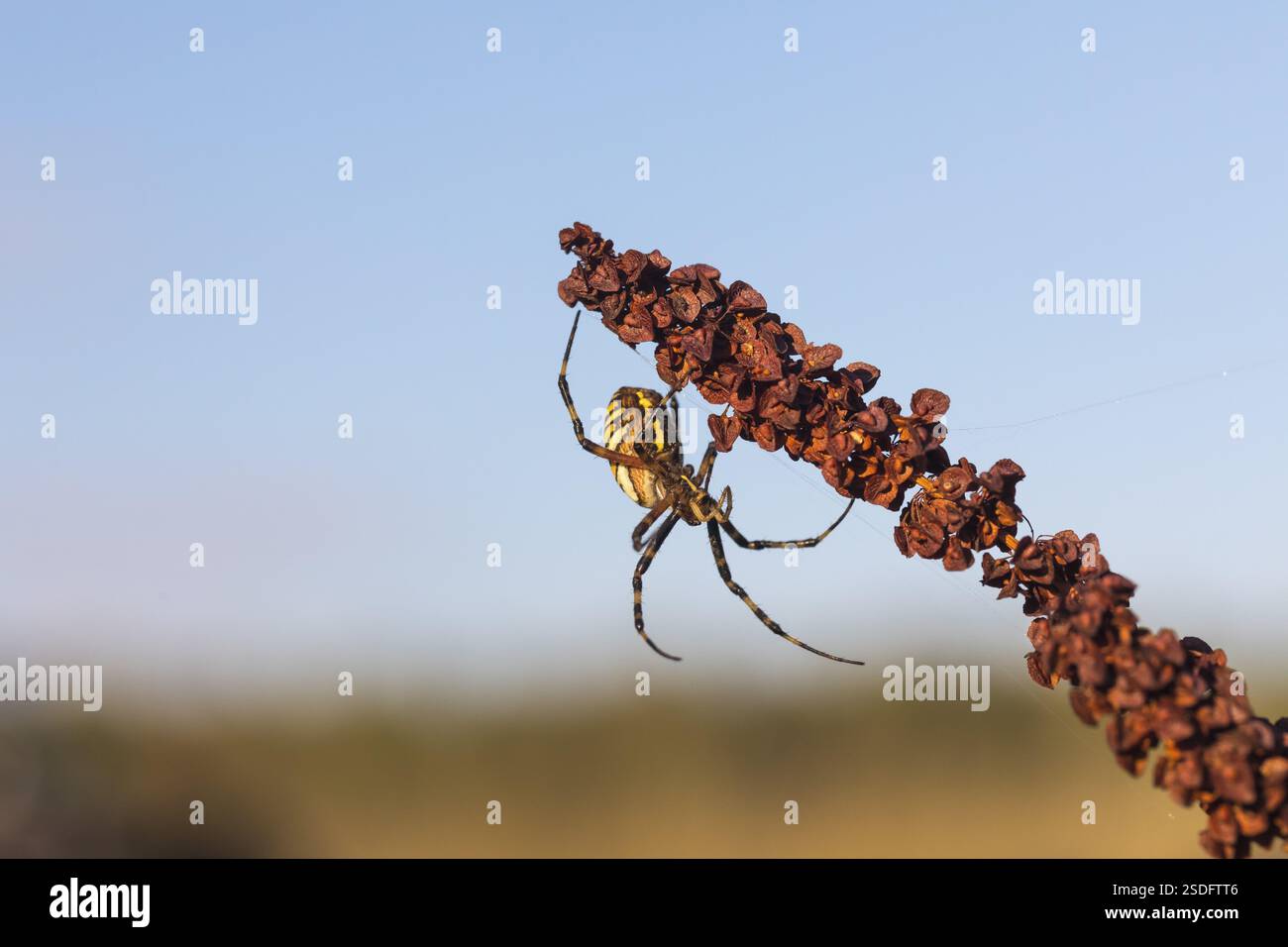 One Argiope bruennichi (wasp spider)sitting on a dry reddish plant Stock Photohttps://www.alamy.com/image-license-details/?v=1https://www.alamy.com/one-argiope-bruennichi-wasp-spidersitting-on-a-dry-reddish-plant-image645122918.html
One Argiope bruennichi (wasp spider)sitting on a dry reddish plant Stock Photohttps://www.alamy.com/image-license-details/?v=1https://www.alamy.com/one-argiope-bruennichi-wasp-spidersitting-on-a-dry-reddish-plant-image645122918.htmlRM2SDFTT6–One Argiope bruennichi (wasp spider)sitting on a dry reddish plant
 Die, Arachniden, Nürnberg, In, der, C. H. Zeh'schen, Buchhandlung, 1831-1848, Arachnida, This illustration features two distinct species of spiders, showcasing their detailed anatomy and features. The upper spider is depicted with a striking reddish-brown coloration, emphasizing its prominent legs and the intricate patterns on its body. The lower spider, possibly of a different species, exhibits a more vibrant orange hue, with similarly well-defined legs and body structure. Both specimens are labeled with numbers to indicate their classification, and the artist's meticulous attention to detail Stock Photohttps://www.alamy.com/image-license-details/?v=1https://www.alamy.com/die-arachniden-nrnberg-in-der-c-h-zehschen-buchhandlung-1831-1848-arachnida-this-illustration-features-two-distinct-species-of-spiders-showcasing-their-detailed-anatomy-and-features-the-upper-spider-is-depicted-with-a-striking-reddish-brown-coloration-emphasizing-its-prominent-legs-and-the-intricate-patterns-on-its-body-the-lower-spider-possibly-of-a-different-species-exhibits-a-more-vibrant-orange-hue-with-similarly-well-defined-legs-and-body-structure-both-specimens-are-labeled-with-numbers-to-indicate-their-classification-and-the-artists-meticulous-attention-to-detail-image643572083.html
Die, Arachniden, Nürnberg, In, der, C. H. Zeh'schen, Buchhandlung, 1831-1848, Arachnida, This illustration features two distinct species of spiders, showcasing their detailed anatomy and features. The upper spider is depicted with a striking reddish-brown coloration, emphasizing its prominent legs and the intricate patterns on its body. The lower spider, possibly of a different species, exhibits a more vibrant orange hue, with similarly well-defined legs and body structure. Both specimens are labeled with numbers to indicate their classification, and the artist's meticulous attention to detail Stock Photohttps://www.alamy.com/image-license-details/?v=1https://www.alamy.com/die-arachniden-nrnberg-in-der-c-h-zehschen-buchhandlung-1831-1848-arachnida-this-illustration-features-two-distinct-species-of-spiders-showcasing-their-detailed-anatomy-and-features-the-upper-spider-is-depicted-with-a-striking-reddish-brown-coloration-emphasizing-its-prominent-legs-and-the-intricate-patterns-on-its-body-the-lower-spider-possibly-of-a-different-species-exhibits-a-more-vibrant-orange-hue-with-similarly-well-defined-legs-and-body-structure-both-specimens-are-labeled-with-numbers-to-indicate-their-classification-and-the-artists-meticulous-attention-to-detail-image643572083.htmlRM2SB16N7–Die, Arachniden, Nürnberg, In, der, C. H. Zeh'schen, Buchhandlung, 1831-1848, Arachnida, This illustration features two distinct species of spiders, showcasing their detailed anatomy and features. The upper spider is depicted with a striking reddish-brown coloration, emphasizing its prominent legs and the intricate patterns on its body. The lower spider, possibly of a different species, exhibits a more vibrant orange hue, with similarly well-defined legs and body structure. Both specimens are labeled with numbers to indicate their classification, and the artist's meticulous attention to detail
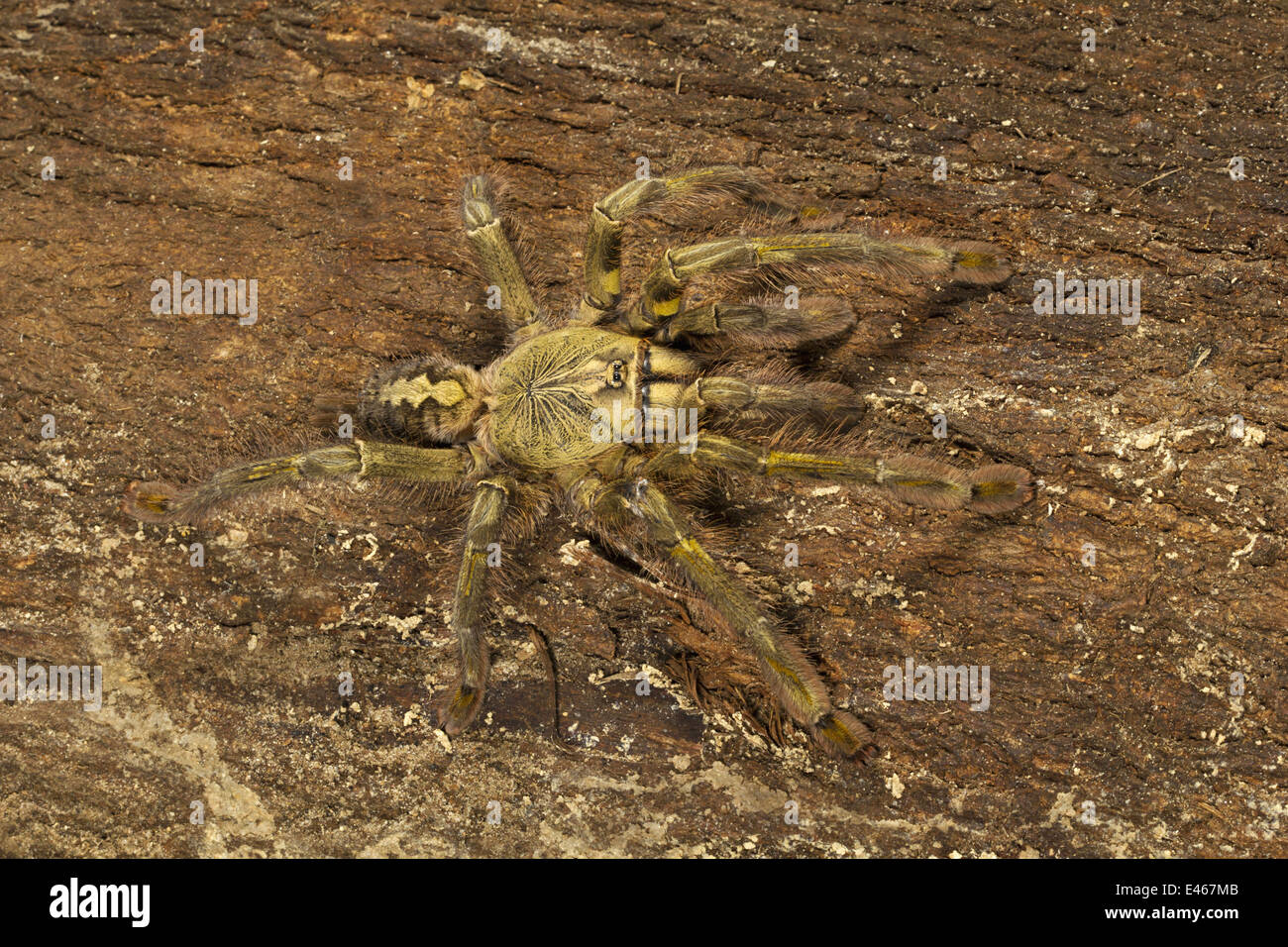 Reddish parachute tarantula, Poecilotheriaÿrufilata, Rare, Peppara Wildlife Sanctuary, Kerala Stock Photohttps://www.alamy.com/image-license-details/?v=1https://www.alamy.com/stock-photo-reddish-parachute-tarantula-poecilotheriarufilata-rare-peppara-wildlife-71437867.html
Reddish parachute tarantula, Poecilotheriaÿrufilata, Rare, Peppara Wildlife Sanctuary, Kerala Stock Photohttps://www.alamy.com/image-license-details/?v=1https://www.alamy.com/stock-photo-reddish-parachute-tarantula-poecilotheriarufilata-rare-peppara-wildlife-71437867.htmlRFE467MB–Reddish parachute tarantula, Poecilotheriaÿrufilata, Rare, Peppara Wildlife Sanctuary, Kerala
 Transactions and proceedings of the New Zealand Institute . f^:i -.,,, %. /l^fA^ ZEALAND SPIDERS. Urquhart.—On New Species of Araneidea. 113 end, 1 short basal tooth; claw-tuft sparse, long, slenderplumose hairs. Palpi humeral and cubital joints green, former exceedscubital and radial in length, latter articles equal; base ofcubital slender; radial, yellowish-brown, somewhat linear,short bi-cornute apophysis on outer side; digital joint sametints, small, oviform, tapering, convex and sparsely hairedexternally; oval concavity on inferior surface, margins glossy-brown, reddish bulb in centre. Fa Stock Photohttps://www.alamy.com/image-license-details/?v=1https://www.alamy.com/transactions-and-proceedings-of-the-new-zealand-institute-fi-lfa-zealand-spiders-urquharton-new-species-of-araneidea-113-end-1-short-basal-tooth-claw-tuft-sparse-long-slenderplumose-hairs-palpi-humeral-and-cubital-joints-green-former-exceedscubital-and-radial-in-length-latter-articles-equal-base-ofcubital-slender-radial-yellowish-brown-somewhat-linearshort-bi-cornute-apophysis-on-outer-side-digital-joint-sametints-small-oviform-tapering-convex-and-sparsely-hairedexternally-oval-concavity-on-inferior-surface-margins-glossy-brown-reddish-bulb-in-centre-fa-image339304191.html
Transactions and proceedings of the New Zealand Institute . f^:i -.,,, %. /l^fA^ ZEALAND SPIDERS. Urquhart.—On New Species of Araneidea. 113 end, 1 short basal tooth; claw-tuft sparse, long, slenderplumose hairs. Palpi humeral and cubital joints green, former exceedscubital and radial in length, latter articles equal; base ofcubital slender; radial, yellowish-brown, somewhat linear,short bi-cornute apophysis on outer side; digital joint sametints, small, oviform, tapering, convex and sparsely hairedexternally; oval concavity on inferior surface, margins glossy-brown, reddish bulb in centre. Fa Stock Photohttps://www.alamy.com/image-license-details/?v=1https://www.alamy.com/transactions-and-proceedings-of-the-new-zealand-institute-fi-lfa-zealand-spiders-urquharton-new-species-of-araneidea-113-end-1-short-basal-tooth-claw-tuft-sparse-long-slenderplumose-hairs-palpi-humeral-and-cubital-joints-green-former-exceedscubital-and-radial-in-length-latter-articles-equal-base-ofcubital-slender-radial-yellowish-brown-somewhat-linearshort-bi-cornute-apophysis-on-outer-side-digital-joint-sametints-small-oviform-tapering-convex-and-sparsely-hairedexternally-oval-concavity-on-inferior-surface-margins-glossy-brown-reddish-bulb-in-centre-fa-image339304191.htmlRM2AM0HXR–Transactions and proceedings of the New Zealand Institute . f^:i -.,,, %. /l^fA^ ZEALAND SPIDERS. Urquhart.—On New Species of Araneidea. 113 end, 1 short basal tooth; claw-tuft sparse, long, slenderplumose hairs. Palpi humeral and cubital joints green, former exceedscubital and radial in length, latter articles equal; base ofcubital slender; radial, yellowish-brown, somewhat linear,short bi-cornute apophysis on outer side; digital joint sametints, small, oviform, tapering, convex and sparsely hairedexternally; oval concavity on inferior surface, margins glossy-brown, reddish bulb in centre. Fa
 Cary, North Carolina, USA. 19th Apr, 2023. An orchard orbweaver, one of the most common spiders in the eastern United States. They are occasionally mistaken for black widow spiders because of the reddish-orange spots. (Credit Image: © Bob Karp/ZUMA Press Wire) EDITORIAL USAGE ONLY! Not for Commercial USAGE! Stock Photohttps://www.alamy.com/image-license-details/?v=1https://www.alamy.com/cary-north-carolina-usa-19th-apr-2023-an-orchard-orbweaver-one-of-the-most-common-spiders-in-the-eastern-united-states-they-are-occasionally-mistaken-for-black-widow-spiders-because-of-the-reddish-orange-spots-credit-image-bob-karpzuma-press-wire-editorial-usage-only!-not-for-commercial-usage!-image546828451.html
Cary, North Carolina, USA. 19th Apr, 2023. An orchard orbweaver, one of the most common spiders in the eastern United States. They are occasionally mistaken for black widow spiders because of the reddish-orange spots. (Credit Image: © Bob Karp/ZUMA Press Wire) EDITORIAL USAGE ONLY! Not for Commercial USAGE! Stock Photohttps://www.alamy.com/image-license-details/?v=1https://www.alamy.com/cary-north-carolina-usa-19th-apr-2023-an-orchard-orbweaver-one-of-the-most-common-spiders-in-the-eastern-united-states-they-are-occasionally-mistaken-for-black-widow-spiders-because-of-the-reddish-orange-spots-credit-image-bob-karpzuma-press-wire-editorial-usage-only!-not-for-commercial-usage!-image546828451.htmlRM2PNJ57F–Cary, North Carolina, USA. 19th Apr, 2023. An orchard orbweaver, one of the most common spiders in the eastern United States. They are occasionally mistaken for black widow spiders because of the reddish-orange spots. (Credit Image: © Bob Karp/ZUMA Press Wire) EDITORIAL USAGE ONLY! Not for Commercial USAGE!
 . The culture and diseases of the sweet pea. Sweet peas; Sweet peas. 132 DISEASES OF THE SWEET PEA. FIG. 21. THE RED SPIDER, ENLARGED. (AFTER BANKS.) tack both leaves and stems, the method of attack and the resulting injury somewhat resembling that of mites. However, the spots caused by red spiders are reddish in- stead of a pale white. Life History. The adult female is usu- ally brick red in color and the male is red- dish amber. Frequently, however, the color of the red spider changes according to locality and food plants. The female lays. Please note that these images are extracted from sca Stock Photohttps://www.alamy.com/image-license-details/?v=1https://www.alamy.com/the-culture-and-diseases-of-the-sweet-pea-sweet-peas-sweet-peas-132-diseases-of-the-sweet-pea-fig-21-the-red-spider-enlarged-after-banks-tack-both-leaves-and-stems-the-method-of-attack-and-the-resulting-injury-somewhat-resembling-that-of-mites-however-the-spots-caused-by-red-spiders-are-reddish-in-stead-of-a-pale-white-life-history-the-adult-female-is-usu-ally-brick-red-in-color-and-the-male-is-red-dish-amber-frequently-however-the-color-of-the-red-spider-changes-according-to-locality-and-food-plants-the-female-lays-please-note-that-these-images-are-extracted-from-sca-image216318287.html
. The culture and diseases of the sweet pea. Sweet peas; Sweet peas. 132 DISEASES OF THE SWEET PEA. FIG. 21. THE RED SPIDER, ENLARGED. (AFTER BANKS.) tack both leaves and stems, the method of attack and the resulting injury somewhat resembling that of mites. However, the spots caused by red spiders are reddish in- stead of a pale white. Life History. The adult female is usu- ally brick red in color and the male is red- dish amber. Frequently, however, the color of the red spider changes according to locality and food plants. The female lays. Please note that these images are extracted from sca Stock Photohttps://www.alamy.com/image-license-details/?v=1https://www.alamy.com/the-culture-and-diseases-of-the-sweet-pea-sweet-peas-sweet-peas-132-diseases-of-the-sweet-pea-fig-21-the-red-spider-enlarged-after-banks-tack-both-leaves-and-stems-the-method-of-attack-and-the-resulting-injury-somewhat-resembling-that-of-mites-however-the-spots-caused-by-red-spiders-are-reddish-in-stead-of-a-pale-white-life-history-the-adult-female-is-usu-ally-brick-red-in-color-and-the-male-is-red-dish-amber-frequently-however-the-color-of-the-red-spider-changes-according-to-locality-and-food-plants-the-female-lays-please-note-that-these-images-are-extracted-from-sca-image216318287.htmlRMPFX453–. The culture and diseases of the sweet pea. Sweet peas; Sweet peas. 132 DISEASES OF THE SWEET PEA. FIG. 21. THE RED SPIDER, ENLARGED. (AFTER BANKS.) tack both leaves and stems, the method of attack and the resulting injury somewhat resembling that of mites. However, the spots caused by red spiders are reddish in- stead of a pale white. Life History. The adult female is usu- ally brick red in color and the male is red- dish amber. Frequently, however, the color of the red spider changes according to locality and food plants. The female lays. Please note that these images are extracted from sca
 One Argiope bruennichi (wasp spider) hanging on its silk down off a dry reddish plant Stock Photohttps://www.alamy.com/image-license-details/?v=1https://www.alamy.com/one-argiope-bruennichi-wasp-spider-hanging-on-its-silk-down-off-a-dry-reddish-plant-image645135893.html
One Argiope bruennichi (wasp spider) hanging on its silk down off a dry reddish plant Stock Photohttps://www.alamy.com/image-license-details/?v=1https://www.alamy.com/one-argiope-bruennichi-wasp-spider-hanging-on-its-silk-down-off-a-dry-reddish-plant-image645135893.htmlRM2SDGDBH–One Argiope bruennichi (wasp spider) hanging on its silk down off a dry reddish plant
 Die Arachniden, Nürnberg, In der C. H. Zeh'schen Buchhandlung, 1831-1848 Arachnida, Arthropoda, Arthropod, Page Rights, Halloween, A detailed illustration of a spider, showcasing its unique features and intricate anatomy. The spider's body is prominently displayed, with a distinct reddish-brown coloration on its cephalothorax. Its hairy legs are spread out, emphasizing the various segments and fine details of its texture. The illustration includes meticulous lines and shading that highlight the delicate structure and natural patterns on the spider's body, while a handwritten label indicates th Stock Photohttps://www.alamy.com/image-license-details/?v=1https://www.alamy.com/die-arachniden-nrnberg-in-der-c-h-zehschen-buchhandlung-1831-1848-arachnida-arthropoda-arthropod-page-rights-halloween-a-detailed-illustration-of-a-spider-showcasing-its-unique-features-and-intricate-anatomy-the-spiders-body-is-prominently-displayed-with-a-distinct-reddish-brown-coloration-on-its-cephalothorax-its-hairy-legs-are-spread-out-emphasizing-the-various-segments-and-fine-details-of-its-texture-the-illustration-includes-meticulous-lines-and-shading-that-highlight-the-delicate-structure-and-natural-patterns-on-the-spiders-body-while-a-handwritten-label-indicates-th-image643575322.html
Die Arachniden, Nürnberg, In der C. H. Zeh'schen Buchhandlung, 1831-1848 Arachnida, Arthropoda, Arthropod, Page Rights, Halloween, A detailed illustration of a spider, showcasing its unique features and intricate anatomy. The spider's body is prominently displayed, with a distinct reddish-brown coloration on its cephalothorax. Its hairy legs are spread out, emphasizing the various segments and fine details of its texture. The illustration includes meticulous lines and shading that highlight the delicate structure and natural patterns on the spider's body, while a handwritten label indicates th Stock Photohttps://www.alamy.com/image-license-details/?v=1https://www.alamy.com/die-arachniden-nrnberg-in-der-c-h-zehschen-buchhandlung-1831-1848-arachnida-arthropoda-arthropod-page-rights-halloween-a-detailed-illustration-of-a-spider-showcasing-its-unique-features-and-intricate-anatomy-the-spiders-body-is-prominently-displayed-with-a-distinct-reddish-brown-coloration-on-its-cephalothorax-its-hairy-legs-are-spread-out-emphasizing-the-various-segments-and-fine-details-of-its-texture-the-illustration-includes-meticulous-lines-and-shading-that-highlight-the-delicate-structure-and-natural-patterns-on-the-spiders-body-while-a-handwritten-label-indicates-th-image643575322.htmlRM2SB1ATX–Die Arachniden, Nürnberg, In der C. H. Zeh'schen Buchhandlung, 1831-1848 Arachnida, Arthropoda, Arthropod, Page Rights, Halloween, A detailed illustration of a spider, showcasing its unique features and intricate anatomy. The spider's body is prominently displayed, with a distinct reddish-brown coloration on its cephalothorax. Its hairy legs are spread out, emphasizing the various segments and fine details of its texture. The illustration includes meticulous lines and shading that highlight the delicate structure and natural patterns on the spider's body, while a handwritten label indicates th
 REDDISH PARACHUTE TARANTULA, Poecilotheria rufilata, RARE, Peppara Wildlife Sanctuary, Kerala Stock Photohttps://www.alamy.com/image-license-details/?v=1https://www.alamy.com/stock-photo-reddish-parachute-tarantula-poecilotheriarufilata-rare-peppara-wildlife-71438006.html
REDDISH PARACHUTE TARANTULA, Poecilotheria rufilata, RARE, Peppara Wildlife Sanctuary, Kerala Stock Photohttps://www.alamy.com/image-license-details/?v=1https://www.alamy.com/stock-photo-reddish-parachute-tarantula-poecilotheriarufilata-rare-peppara-wildlife-71438006.htmlRFE467WA–REDDISH PARACHUTE TARANTULA, Poecilotheria rufilata, RARE, Peppara Wildlife Sanctuary, Kerala
 . Oologia neerlandica : eggs of birds breeding in the Netherlands . eerlandica, p. 31, No. 71). Colour of surface of shell;Colour of spots: Average dimensions:Average weight of shell:Texture of shell:Shape:Nest: Site of nest: Number of eggs:Breeding season:Duration of incubation:Remarks: lime-white; slightly yellowish or greyish-yellow, in dull tints. reddish, in dull or brighter shades. The mark-ings are frequently very obscure oraltogether lacking. 14X 11 millimetres. 0.05 gram. like that of the genus Parus. ovoidal. is built of moss, bark-fibres, small fragmentsof bark, and spiders webs; li Stock Photohttps://www.alamy.com/image-license-details/?v=1https://www.alamy.com/oologia-neerlandica-eggs-of-birds-breeding-in-the-netherlands-eerlandica-p-31-no-71-colour-of-surface-of-shellcolour-of-spots-average-dimensionsaverage-weight-of-shelltexture-of-shellshapenest-site-of-nest-number-of-eggsbreeding-seasonduration-of-incubationremarks-lime-white-slightly-yellowish-or-greyish-yellow-in-dull-tints-reddish-in-dull-or-brighter-shades-the-mark-ings-are-frequently-very-obscure-oraltogether-lacking-14x-11-millimetres-005-gram-like-that-of-the-genus-parus-ovoidal-is-built-of-moss-bark-fibres-small-fragmentsof-bark-and-spiders-webs-li-image375448295.html
. Oologia neerlandica : eggs of birds breeding in the Netherlands . eerlandica, p. 31, No. 71). Colour of surface of shell;Colour of spots: Average dimensions:Average weight of shell:Texture of shell:Shape:Nest: Site of nest: Number of eggs:Breeding season:Duration of incubation:Remarks: lime-white; slightly yellowish or greyish-yellow, in dull tints. reddish, in dull or brighter shades. The mark-ings are frequently very obscure oraltogether lacking. 14X 11 millimetres. 0.05 gram. like that of the genus Parus. ovoidal. is built of moss, bark-fibres, small fragmentsof bark, and spiders webs; li Stock Photohttps://www.alamy.com/image-license-details/?v=1https://www.alamy.com/oologia-neerlandica-eggs-of-birds-breeding-in-the-netherlands-eerlandica-p-31-no-71-colour-of-surface-of-shellcolour-of-spots-average-dimensionsaverage-weight-of-shelltexture-of-shellshapenest-site-of-nest-number-of-eggsbreeding-seasonduration-of-incubationremarks-lime-white-slightly-yellowish-or-greyish-yellow-in-dull-tints-reddish-in-dull-or-brighter-shades-the-mark-ings-are-frequently-very-obscure-oraltogether-lacking-14x-11-millimetres-005-gram-like-that-of-the-genus-parus-ovoidal-is-built-of-moss-bark-fibres-small-fragmentsof-bark-and-spiders-webs-li-image375448295.htmlRM2CPR43K–. Oologia neerlandica : eggs of birds breeding in the Netherlands . eerlandica, p. 31, No. 71). Colour of surface of shell;Colour of spots: Average dimensions:Average weight of shell:Texture of shell:Shape:Nest: Site of nest: Number of eggs:Breeding season:Duration of incubation:Remarks: lime-white; slightly yellowish or greyish-yellow, in dull tints. reddish, in dull or brighter shades. The mark-ings are frequently very obscure oraltogether lacking. 14X 11 millimetres. 0.05 gram. like that of the genus Parus. ovoidal. is built of moss, bark-fibres, small fragmentsof bark, and spiders webs; li
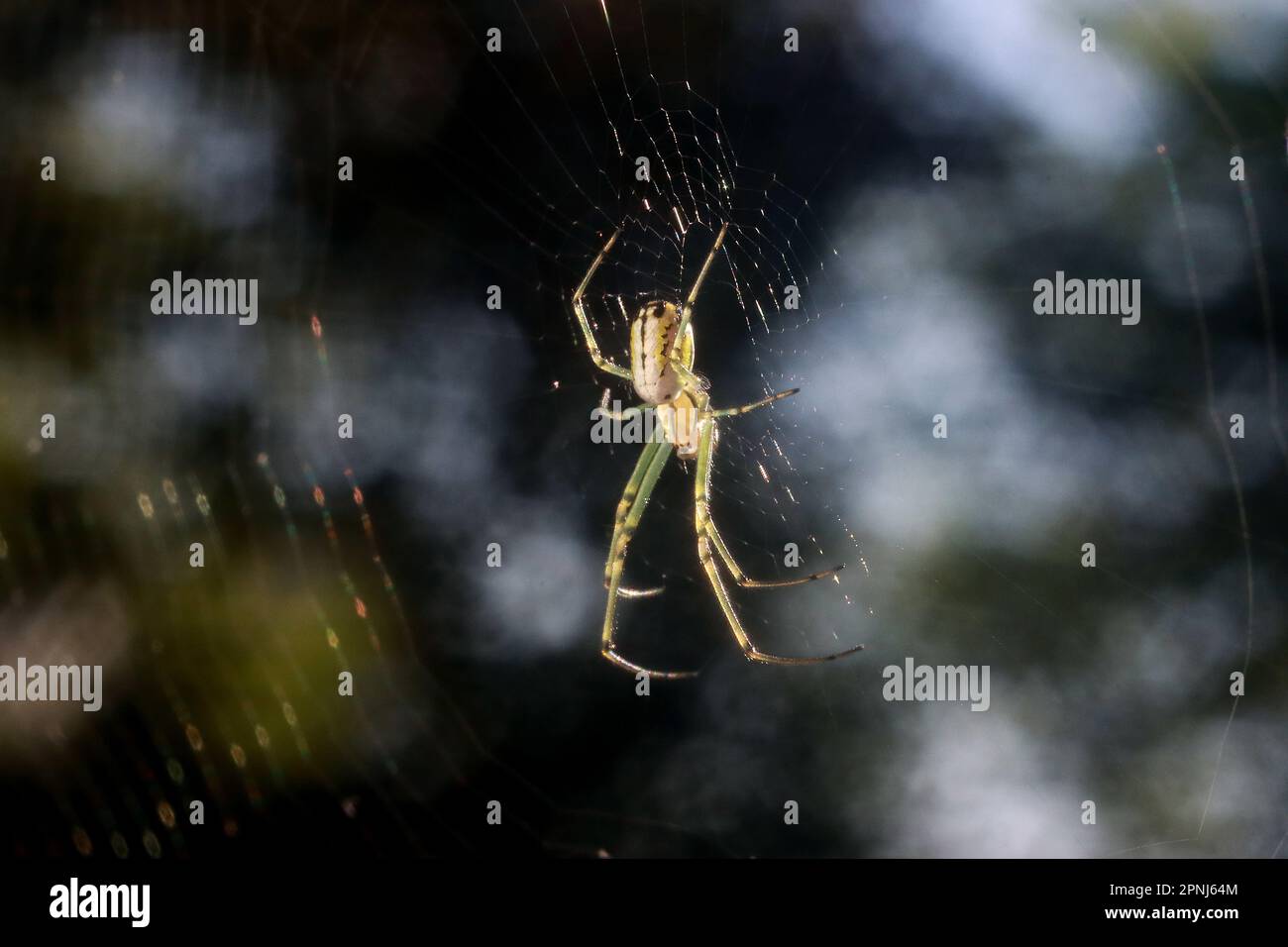 Cary, North Carolina, USA. 19th Apr, 2023. An orchard orbweaver, one of the most common spiders in the eastern United States. They are occasionally mistaken for black widow spiders because of the reddish-orange spots. (Credit Image: © Bob Karp/ZUMA Press Wire) EDITORIAL USAGE ONLY! Not for Commercial USAGE! Stock Photohttps://www.alamy.com/image-license-details/?v=1https://www.alamy.com/cary-north-carolina-usa-19th-apr-2023-an-orchard-orbweaver-one-of-the-most-common-spiders-in-the-eastern-united-states-they-are-occasionally-mistaken-for-black-widow-spiders-because-of-the-reddish-orange-spots-credit-image-bob-karpzuma-press-wire-editorial-usage-only!-not-for-commercial-usage!-image546829156.html
Cary, North Carolina, USA. 19th Apr, 2023. An orchard orbweaver, one of the most common spiders in the eastern United States. They are occasionally mistaken for black widow spiders because of the reddish-orange spots. (Credit Image: © Bob Karp/ZUMA Press Wire) EDITORIAL USAGE ONLY! Not for Commercial USAGE! Stock Photohttps://www.alamy.com/image-license-details/?v=1https://www.alamy.com/cary-north-carolina-usa-19th-apr-2023-an-orchard-orbweaver-one-of-the-most-common-spiders-in-the-eastern-united-states-they-are-occasionally-mistaken-for-black-widow-spiders-because-of-the-reddish-orange-spots-credit-image-bob-karpzuma-press-wire-editorial-usage-only!-not-for-commercial-usage!-image546829156.htmlRM2PNJ64M–Cary, North Carolina, USA. 19th Apr, 2023. An orchard orbweaver, one of the most common spiders in the eastern United States. They are occasionally mistaken for black widow spiders because of the reddish-orange spots. (Credit Image: © Bob Karp/ZUMA Press Wire) EDITORIAL USAGE ONLY! Not for Commercial USAGE!
 One Argiope bruennichi (wasp spider)sitting on a dry reddish plant Stock Photohttps://www.alamy.com/image-license-details/?v=1https://www.alamy.com/one-argiope-bruennichi-wasp-spidersitting-on-a-dry-reddish-plant-image645132962.html
One Argiope bruennichi (wasp spider)sitting on a dry reddish plant Stock Photohttps://www.alamy.com/image-license-details/?v=1https://www.alamy.com/one-argiope-bruennichi-wasp-spidersitting-on-a-dry-reddish-plant-image645132962.htmlRM2SDG9JX–One Argiope bruennichi (wasp spider)sitting on a dry reddish plant
 Die Arachniden, Nürnberg, In der C. H. Zeh'schen Buchhandlung, 1831-1848, arachnida, The illustration showcases three distinct species of spiders, each labeled with a corresponding figure number. The first spider is depicted with a notable reddish hue and elongated legs, while the second features a unique patterned body that includes shades of brown and cream. The third spider displays a more subtle coloration, marked with intricate detailing that highlights its distinctive characteristics. Below the main illustration, the genus ''Argyopes'' is noted, along with specific figure references for Stock Photohttps://www.alamy.com/image-license-details/?v=1https://www.alamy.com/die-arachniden-nrnberg-in-der-c-h-zehschen-buchhandlung-1831-1848-arachnida-the-illustration-showcases-three-distinct-species-of-spiders-each-labeled-with-a-corresponding-figure-number-the-first-spider-is-depicted-with-a-notable-reddish-hue-and-elongated-legs-while-the-second-features-a-unique-patterned-body-that-includes-shades-of-brown-and-cream-the-third-spider-displays-a-more-subtle-coloration-marked-with-intricate-detailing-that-highlights-its-distinctive-characteristics-below-the-main-illustration-the-genus-argyopes-is-noted-along-with-specific-figure-references-for-image636085792.html
Die Arachniden, Nürnberg, In der C. H. Zeh'schen Buchhandlung, 1831-1848, arachnida, The illustration showcases three distinct species of spiders, each labeled with a corresponding figure number. The first spider is depicted with a notable reddish hue and elongated legs, while the second features a unique patterned body that includes shades of brown and cream. The third spider displays a more subtle coloration, marked with intricate detailing that highlights its distinctive characteristics. Below the main illustration, the genus ''Argyopes'' is noted, along with specific figure references for Stock Photohttps://www.alamy.com/image-license-details/?v=1https://www.alamy.com/die-arachniden-nrnberg-in-der-c-h-zehschen-buchhandlung-1831-1848-arachnida-the-illustration-showcases-three-distinct-species-of-spiders-each-labeled-with-a-corresponding-figure-number-the-first-spider-is-depicted-with-a-notable-reddish-hue-and-elongated-legs-while-the-second-features-a-unique-patterned-body-that-includes-shades-of-brown-and-cream-the-third-spider-displays-a-more-subtle-coloration-marked-with-intricate-detailing-that-highlights-its-distinctive-characteristics-below-the-main-illustration-the-genus-argyopes-is-noted-along-with-specific-figure-references-for-image636085792.htmlRM2YXT5WM–Die Arachniden, Nürnberg, In der C. H. Zeh'schen Buchhandlung, 1831-1848, arachnida, The illustration showcases three distinct species of spiders, each labeled with a corresponding figure number. The first spider is depicted with a notable reddish hue and elongated legs, while the second features a unique patterned body that includes shades of brown and cream. The third spider displays a more subtle coloration, marked with intricate detailing that highlights its distinctive characteristics. Below the main illustration, the genus ''Argyopes'' is noted, along with specific figure references for
 REDDISH PARACHUTE TARANTULA, Poecilotheria rufilata, RARE, Peppara Wildlife Sanctuary, Kerala Stock Photohttps://www.alamy.com/image-license-details/?v=1https://www.alamy.com/stock-photo-reddish-parachute-tarantula-poecilotheriarufilata-rare-peppara-wildlife-71437890.html
REDDISH PARACHUTE TARANTULA, Poecilotheria rufilata, RARE, Peppara Wildlife Sanctuary, Kerala Stock Photohttps://www.alamy.com/image-license-details/?v=1https://www.alamy.com/stock-photo-reddish-parachute-tarantula-poecilotheriarufilata-rare-peppara-wildlife-71437890.htmlRFE467N6–REDDISH PARACHUTE TARANTULA, Poecilotheria rufilata, RARE, Peppara Wildlife Sanctuary, Kerala
 . Britain's birds and their nests . its nest on theunder-side of a branch, but slightly different situationsare sometimes used. The typical situation and the almostspherical shape are well seen in the accompanying plate.The materials used are moss, wool, spiders webs, lichens,and others of a similar nature, while feathers are usedfor the lining. The five to eight or more eggs are laidearly in April, as a rule. They are huffish white, withsmall reddish-brown specks. THE WILLOW=WREN (Phylloscopus trochilus).Plate 126. Taken all in all, the Willow - Wren is perhaps thecommonest and most familiar Stock Photohttps://www.alamy.com/image-license-details/?v=1https://www.alamy.com/britains-birds-and-their-nests-its-nest-on-theunder-side-of-a-branch-but-slightly-different-situationsare-sometimes-used-the-typical-situation-and-the-almostspherical-shape-are-well-seen-in-the-accompanying-platethe-materials-used-are-moss-wool-spiders-webs-lichensand-others-of-a-similar-nature-while-feathers-are-usedfor-the-lining-the-five-to-eight-or-more-eggs-are-laidearly-in-april-as-a-rule-they-are-huffish-white-withsmall-reddish-brown-specks-the-willow=wren-phylloscopus-trochilusplate-126-taken-all-in-all-the-willow-wren-is-perhaps-thecommonest-and-most-familiar-image374682859.html
. Britain's birds and their nests . its nest on theunder-side of a branch, but slightly different situationsare sometimes used. The typical situation and the almostspherical shape are well seen in the accompanying plate.The materials used are moss, wool, spiders webs, lichens,and others of a similar nature, while feathers are usedfor the lining. The five to eight or more eggs are laidearly in April, as a rule. They are huffish white, withsmall reddish-brown specks. THE WILLOW=WREN (Phylloscopus trochilus).Plate 126. Taken all in all, the Willow - Wren is perhaps thecommonest and most familiar Stock Photohttps://www.alamy.com/image-license-details/?v=1https://www.alamy.com/britains-birds-and-their-nests-its-nest-on-theunder-side-of-a-branch-but-slightly-different-situationsare-sometimes-used-the-typical-situation-and-the-almostspherical-shape-are-well-seen-in-the-accompanying-platethe-materials-used-are-moss-wool-spiders-webs-lichensand-others-of-a-similar-nature-while-feathers-are-usedfor-the-lining-the-five-to-eight-or-more-eggs-are-laidearly-in-april-as-a-rule-they-are-huffish-white-withsmall-reddish-brown-specks-the-willow=wren-phylloscopus-trochilusplate-126-taken-all-in-all-the-willow-wren-is-perhaps-thecommonest-and-most-familiar-image374682859.htmlRM2CNG7PK–. Britain's birds and their nests . its nest on theunder-side of a branch, but slightly different situationsare sometimes used. The typical situation and the almostspherical shape are well seen in the accompanying plate.The materials used are moss, wool, spiders webs, lichens,and others of a similar nature, while feathers are usedfor the lining. The five to eight or more eggs are laidearly in April, as a rule. They are huffish white, withsmall reddish-brown specks. THE WILLOW=WREN (Phylloscopus trochilus).Plate 126. Taken all in all, the Willow - Wren is perhaps thecommonest and most familiar
 Cary, North Carolina, USA. 19th Apr, 2023. An orchard orbweaver, one of the most common spiders in the eastern United States. They are occasionally mistaken for black widow spiders because of the reddish-orange spots. (Credit Image: © Bob Karp/ZUMA Press Wire) EDITORIAL USAGE ONLY! Not for Commercial USAGE! Stock Photohttps://www.alamy.com/image-license-details/?v=1https://www.alamy.com/cary-north-carolina-usa-19th-apr-2023-an-orchard-orbweaver-one-of-the-most-common-spiders-in-the-eastern-united-states-they-are-occasionally-mistaken-for-black-widow-spiders-because-of-the-reddish-orange-spots-credit-image-bob-karpzuma-press-wire-editorial-usage-only!-not-for-commercial-usage!-image546829096.html
Cary, North Carolina, USA. 19th Apr, 2023. An orchard orbweaver, one of the most common spiders in the eastern United States. They are occasionally mistaken for black widow spiders because of the reddish-orange spots. (Credit Image: © Bob Karp/ZUMA Press Wire) EDITORIAL USAGE ONLY! Not for Commercial USAGE! Stock Photohttps://www.alamy.com/image-license-details/?v=1https://www.alamy.com/cary-north-carolina-usa-19th-apr-2023-an-orchard-orbweaver-one-of-the-most-common-spiders-in-the-eastern-united-states-they-are-occasionally-mistaken-for-black-widow-spiders-because-of-the-reddish-orange-spots-credit-image-bob-karpzuma-press-wire-editorial-usage-only!-not-for-commercial-usage!-image546829096.htmlRM2PNJ62G–Cary, North Carolina, USA. 19th Apr, 2023. An orchard orbweaver, one of the most common spiders in the eastern United States. They are occasionally mistaken for black widow spiders because of the reddish-orange spots. (Credit Image: © Bob Karp/ZUMA Press Wire) EDITORIAL USAGE ONLY! Not for Commercial USAGE!
 One Argiope bruennichi (wasp spider)sitting on a dry reddish plant Stock Photohttps://www.alamy.com/image-license-details/?v=1https://www.alamy.com/one-argiope-bruennichi-wasp-spidersitting-on-a-dry-reddish-plant-image645128799.html
One Argiope bruennichi (wasp spider)sitting on a dry reddish plant Stock Photohttps://www.alamy.com/image-license-details/?v=1https://www.alamy.com/one-argiope-bruennichi-wasp-spidersitting-on-a-dry-reddish-plant-image645128799.htmlRM2SDG4A7–One Argiope bruennichi (wasp spider)sitting on a dry reddish plant
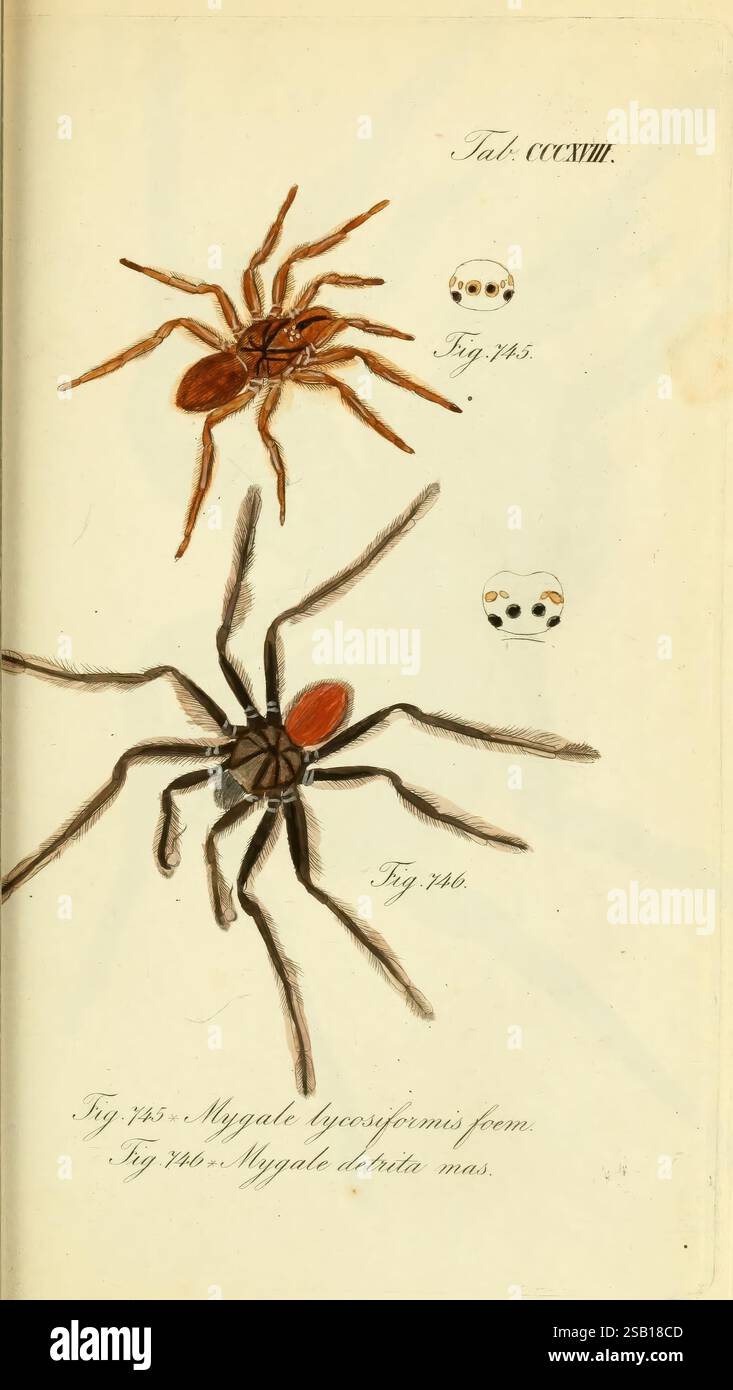 Die Arachniden, Nürnberg, In der C. H. Zeh'schen Buchhandlung, 1831-1848, arachnida, This illustration features two distinct species of spiders, showcasing their detailed anatomical features. The upper spider is labeled as Fig. 743, presenting a slender body with elongated legs and a reddish-brown coloration, complemented by prominent eyes. Below it, Fig. 740 depicts a larger, more robust spider with a broader body and strikingly marked appendages, emphasizing its distinctive patterns. Both illustrations include scientific nomenclature, enhancing their educational value for entomology enthusia Stock Photohttps://www.alamy.com/image-license-details/?v=1https://www.alamy.com/die-arachniden-nrnberg-in-der-c-h-zehschen-buchhandlung-1831-1848-arachnida-this-illustration-features-two-distinct-species-of-spiders-showcasing-their-detailed-anatomical-features-the-upper-spider-is-labeled-as-fig-743-presenting-a-slender-body-with-elongated-legs-and-a-reddish-brown-coloration-complemented-by-prominent-eyes-below-it-fig-740-depicts-a-larger-more-robust-spider-with-a-broader-body-and-strikingly-marked-appendages-emphasizing-its-distinctive-patterns-both-illustrations-include-scientific-nomenclature-enhancing-their-educational-value-for-entomology-enthusia-image643573405.html
Die Arachniden, Nürnberg, In der C. H. Zeh'schen Buchhandlung, 1831-1848, arachnida, This illustration features two distinct species of spiders, showcasing their detailed anatomical features. The upper spider is labeled as Fig. 743, presenting a slender body with elongated legs and a reddish-brown coloration, complemented by prominent eyes. Below it, Fig. 740 depicts a larger, more robust spider with a broader body and strikingly marked appendages, emphasizing its distinctive patterns. Both illustrations include scientific nomenclature, enhancing their educational value for entomology enthusia Stock Photohttps://www.alamy.com/image-license-details/?v=1https://www.alamy.com/die-arachniden-nrnberg-in-der-c-h-zehschen-buchhandlung-1831-1848-arachnida-this-illustration-features-two-distinct-species-of-spiders-showcasing-their-detailed-anatomical-features-the-upper-spider-is-labeled-as-fig-743-presenting-a-slender-body-with-elongated-legs-and-a-reddish-brown-coloration-complemented-by-prominent-eyes-below-it-fig-740-depicts-a-larger-more-robust-spider-with-a-broader-body-and-strikingly-marked-appendages-emphasizing-its-distinctive-patterns-both-illustrations-include-scientific-nomenclature-enhancing-their-educational-value-for-entomology-enthusia-image643573405.htmlRM2SB18CD–Die Arachniden, Nürnberg, In der C. H. Zeh'schen Buchhandlung, 1831-1848, arachnida, This illustration features two distinct species of spiders, showcasing their detailed anatomical features. The upper spider is labeled as Fig. 743, presenting a slender body with elongated legs and a reddish-brown coloration, complemented by prominent eyes. Below it, Fig. 740 depicts a larger, more robust spider with a broader body and strikingly marked appendages, emphasizing its distinctive patterns. Both illustrations include scientific nomenclature, enhancing their educational value for entomology enthusia
 REDDISH PARACHUTE TARANTULA, Poecilotheria rufilata, RARE, Peppara Wildlife Sanctuary, Kerala Stock Photohttps://www.alamy.com/image-license-details/?v=1https://www.alamy.com/stock-photo-reddish-parachute-tarantula-poecilotheriarufilata-rare-peppara-wildlife-71437992.html
REDDISH PARACHUTE TARANTULA, Poecilotheria rufilata, RARE, Peppara Wildlife Sanctuary, Kerala Stock Photohttps://www.alamy.com/image-license-details/?v=1https://www.alamy.com/stock-photo-reddish-parachute-tarantula-poecilotheriarufilata-rare-peppara-wildlife-71437992.htmlRFE467TT–REDDISH PARACHUTE TARANTULA, Poecilotheria rufilata, RARE, Peppara Wildlife Sanctuary, Kerala
 . Nests and eggs of birds found breeding in Australia and Tasmania . which have been built near dwellings have been lined with fowls feathers. Someare more neatly made than others, and are thickly coated with spiders webs and egg-bags,others have a reddish-hue from their being formed chiefly of stringy-bark, while occasionallythey are ornamented with soft pieces of white paper-like bark of a Melaleuca. Green moss,although it is sometimes used, does not enter so largely into the construction of the nests ofthis species as it does in those of Acanthisa nana. One now before me has several pieces Stock Photohttps://www.alamy.com/image-license-details/?v=1https://www.alamy.com/nests-and-eggs-of-birds-found-breeding-in-australia-and-tasmania-which-have-been-built-near-dwellings-have-been-lined-with-fowls-feathers-someare-more-neatly-made-than-others-and-are-thickly-coated-with-spiders-webs-and-egg-bagsothers-have-a-reddish-hue-from-their-being-formed-chiefly-of-stringy-bark-while-occasionallythey-are-ornamented-with-soft-pieces-of-white-paper-like-bark-of-a-melaleuca-green-mossalthough-it-is-sometimes-used-does-not-enter-so-largely-into-the-construction-of-the-nests-ofthis-species-as-it-does-in-those-of-acanthisa-nana-one-now-before-me-has-several-pieces-image375352264.html
. Nests and eggs of birds found breeding in Australia and Tasmania . which have been built near dwellings have been lined with fowls feathers. Someare more neatly made than others, and are thickly coated with spiders webs and egg-bags,others have a reddish-hue from their being formed chiefly of stringy-bark, while occasionallythey are ornamented with soft pieces of white paper-like bark of a Melaleuca. Green moss,although it is sometimes used, does not enter so largely into the construction of the nests ofthis species as it does in those of Acanthisa nana. One now before me has several pieces Stock Photohttps://www.alamy.com/image-license-details/?v=1https://www.alamy.com/nests-and-eggs-of-birds-found-breeding-in-australia-and-tasmania-which-have-been-built-near-dwellings-have-been-lined-with-fowls-feathers-someare-more-neatly-made-than-others-and-are-thickly-coated-with-spiders-webs-and-egg-bagsothers-have-a-reddish-hue-from-their-being-formed-chiefly-of-stringy-bark-while-occasionallythey-are-ornamented-with-soft-pieces-of-white-paper-like-bark-of-a-melaleuca-green-mossalthough-it-is-sometimes-used-does-not-enter-so-largely-into-the-construction-of-the-nests-ofthis-species-as-it-does-in-those-of-acanthisa-nana-one-now-before-me-has-several-pieces-image375352264.htmlRM2CPJNJ0–. Nests and eggs of birds found breeding in Australia and Tasmania . which have been built near dwellings have been lined with fowls feathers. Someare more neatly made than others, and are thickly coated with spiders webs and egg-bags,others have a reddish-hue from their being formed chiefly of stringy-bark, while occasionallythey are ornamented with soft pieces of white paper-like bark of a Melaleuca. Green moss,although it is sometimes used, does not enter so largely into the construction of the nests ofthis species as it does in those of Acanthisa nana. One now before me has several pieces
 Cary, North Carolina, USA. 19th Apr, 2023. An orchard orbweaver, one of the most common spiders in the eastern United States. They are occasionally mistaken for black widow spiders because of the reddish-orange spots. (Credit Image: © Bob Karp/ZUMA Press Wire) EDITORIAL USAGE ONLY! Not for Commercial USAGE! Stock Photohttps://www.alamy.com/image-license-details/?v=1https://www.alamy.com/cary-north-carolina-usa-19th-apr-2023-an-orchard-orbweaver-one-of-the-most-common-spiders-in-the-eastern-united-states-they-are-occasionally-mistaken-for-black-widow-spiders-because-of-the-reddish-orange-spots-credit-image-bob-karpzuma-press-wire-editorial-usage-only!-not-for-commercial-usage!-image546829111.html
Cary, North Carolina, USA. 19th Apr, 2023. An orchard orbweaver, one of the most common spiders in the eastern United States. They are occasionally mistaken for black widow spiders because of the reddish-orange spots. (Credit Image: © Bob Karp/ZUMA Press Wire) EDITORIAL USAGE ONLY! Not for Commercial USAGE! Stock Photohttps://www.alamy.com/image-license-details/?v=1https://www.alamy.com/cary-north-carolina-usa-19th-apr-2023-an-orchard-orbweaver-one-of-the-most-common-spiders-in-the-eastern-united-states-they-are-occasionally-mistaken-for-black-widow-spiders-because-of-the-reddish-orange-spots-credit-image-bob-karpzuma-press-wire-editorial-usage-only!-not-for-commercial-usage!-image546829111.htmlRM2PNJ633–Cary, North Carolina, USA. 19th Apr, 2023. An orchard orbweaver, one of the most common spiders in the eastern United States. They are occasionally mistaken for black widow spiders because of the reddish-orange spots. (Credit Image: © Bob Karp/ZUMA Press Wire) EDITORIAL USAGE ONLY! Not for Commercial USAGE!
 One Argiope bruennichi (wasp spider)sitting on a dry reddish plant Stock Photohttps://www.alamy.com/image-license-details/?v=1https://www.alamy.com/one-argiope-bruennichi-wasp-spidersitting-on-a-dry-reddish-plant-image645142552.html
One Argiope bruennichi (wasp spider)sitting on a dry reddish plant Stock Photohttps://www.alamy.com/image-license-details/?v=1https://www.alamy.com/one-argiope-bruennichi-wasp-spidersitting-on-a-dry-reddish-plant-image645142552.htmlRM2SDGNWC–One Argiope bruennichi (wasp spider)sitting on a dry reddish plant
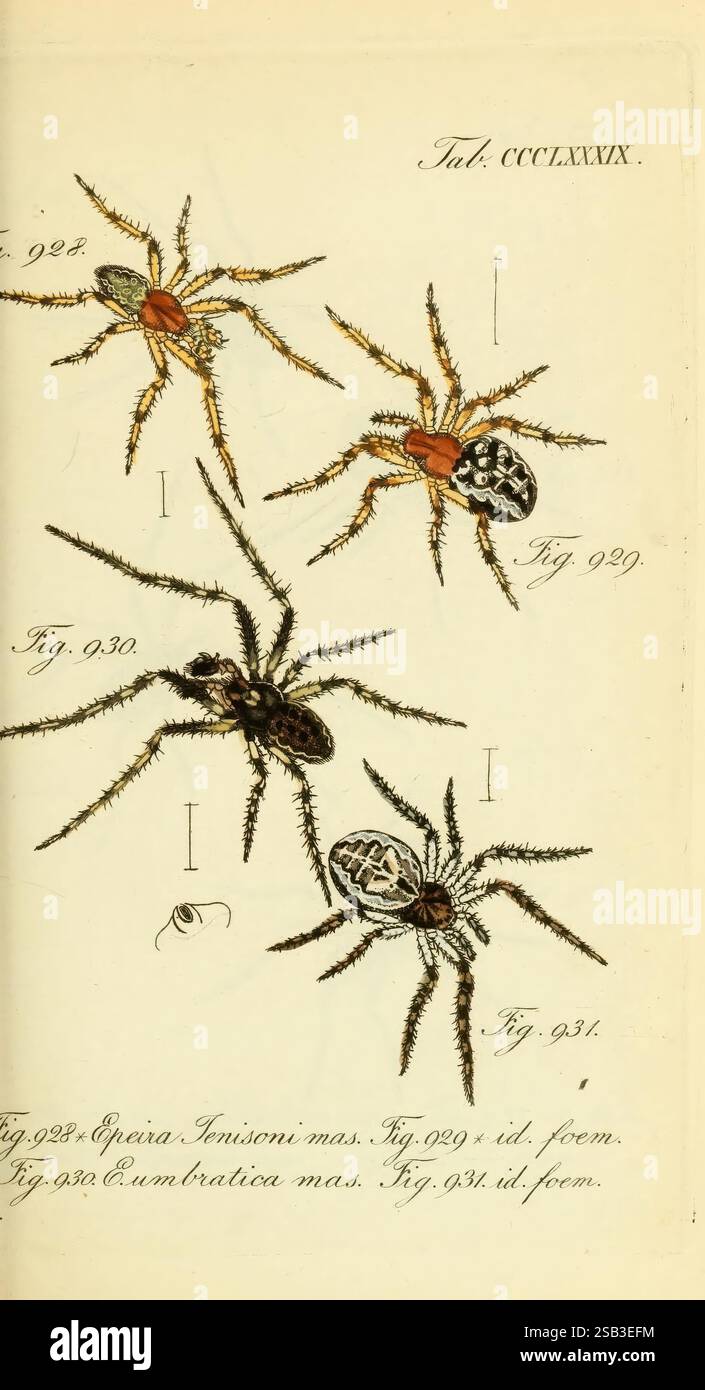 Die Arachniden, Nürnberg, In der C. H. Zeh'schen Buchhandlung, 1831-1848, arachnid, Arachnida, The image showcases a detailed illustration of four different species of spiders, each labeled with a unique figure number for identification. The spiders are depicted with intricate attention to their anatomical features, including distinct patterns on their abdomens and varying colorations. The top-left spider is characterized by a reddish-brown hue, while the others display a mix of dark and light patterns, showcasing the diversity within the spider family. Each figure is accompanied by a descript Stock Photohttps://www.alamy.com/image-license-details/?v=1https://www.alamy.com/die-arachniden-nrnberg-in-der-c-h-zehschen-buchhandlung-1831-1848-arachnid-arachnida-the-image-showcases-a-detailed-illustration-of-four-different-species-of-spiders-each-labeled-with-a-unique-figure-number-for-identification-the-spiders-are-depicted-with-intricate-attention-to-their-anatomical-features-including-distinct-patterns-on-their-abdomens-and-varying-colorations-the-top-left-spider-is-characterized-by-a-reddish-brown-hue-while-the-others-display-a-mix-of-dark-and-light-patterns-showcasing-the-diversity-within-the-spider-family-each-figure-is-accompanied-by-a-descript-image643622104.html
Die Arachniden, Nürnberg, In der C. H. Zeh'schen Buchhandlung, 1831-1848, arachnid, Arachnida, The image showcases a detailed illustration of four different species of spiders, each labeled with a unique figure number for identification. The spiders are depicted with intricate attention to their anatomical features, including distinct patterns on their abdomens and varying colorations. The top-left spider is characterized by a reddish-brown hue, while the others display a mix of dark and light patterns, showcasing the diversity within the spider family. Each figure is accompanied by a descript Stock Photohttps://www.alamy.com/image-license-details/?v=1https://www.alamy.com/die-arachniden-nrnberg-in-der-c-h-zehschen-buchhandlung-1831-1848-arachnid-arachnida-the-image-showcases-a-detailed-illustration-of-four-different-species-of-spiders-each-labeled-with-a-unique-figure-number-for-identification-the-spiders-are-depicted-with-intricate-attention-to-their-anatomical-features-including-distinct-patterns-on-their-abdomens-and-varying-colorations-the-top-left-spider-is-characterized-by-a-reddish-brown-hue-while-the-others-display-a-mix-of-dark-and-light-patterns-showcasing-the-diversity-within-the-spider-family-each-figure-is-accompanied-by-a-descript-image643622104.htmlRM2SB3EFM–Die Arachniden, Nürnberg, In der C. H. Zeh'schen Buchhandlung, 1831-1848, arachnid, Arachnida, The image showcases a detailed illustration of four different species of spiders, each labeled with a unique figure number for identification. The spiders are depicted with intricate attention to their anatomical features, including distinct patterns on their abdomens and varying colorations. The top-left spider is characterized by a reddish-brown hue, while the others display a mix of dark and light patterns, showcasing the diversity within the spider family. Each figure is accompanied by a descript
 REDDISH PARACHUTE TARANTULA, Poecilotheria rufilata, RARE, Peppara Wildlife Sanctuary, Kerala Stock Photohttps://www.alamy.com/image-license-details/?v=1https://www.alamy.com/stock-photo-reddish-parachute-tarantula-poecilotheriarufilata-rare-peppara-wildlife-71437935.html
REDDISH PARACHUTE TARANTULA, Poecilotheria rufilata, RARE, Peppara Wildlife Sanctuary, Kerala Stock Photohttps://www.alamy.com/image-license-details/?v=1https://www.alamy.com/stock-photo-reddish-parachute-tarantula-poecilotheriarufilata-rare-peppara-wildlife-71437935.htmlRFE467PR–REDDISH PARACHUTE TARANTULA, Poecilotheria rufilata, RARE, Peppara Wildlife Sanctuary, Kerala
 . Annals of the South African Museum = Annale van die Suid-Afrikaanse Museum. Natural history. The Harvest-spiders (Opiliones) of South Africa. 445 3 tubercles. Colour of body reddish brown; all the spines and tubercles of the dorsum and appendages a lighter reddish yellow.. Please note that these images are extracted from scanned page images that may have been digitally enhanced for readability - coloration and appearance of these illustrations may not perfectly resemble the original work.. South African Museum. Cape Town : The Museum Stock Photohttps://www.alamy.com/image-license-details/?v=1https://www.alamy.com/annals-of-the-south-african-museum-=-annale-van-die-suid-afrikaanse-museum-natural-history-the-harvest-spiders-opiliones-of-south-africa-445-3-tubercles-colour-of-body-reddish-brown-all-the-spines-and-tubercles-of-the-dorsum-and-appendages-a-lighter-reddish-yellow-please-note-that-these-images-are-extracted-from-scanned-page-images-that-may-have-been-digitally-enhanced-for-readability-coloration-and-appearance-of-these-illustrations-may-not-perfectly-resemble-the-original-work-south-african-museum-cape-town-the-museum-image236460974.html
. Annals of the South African Museum = Annale van die Suid-Afrikaanse Museum. Natural history. The Harvest-spiders (Opiliones) of South Africa. 445 3 tubercles. Colour of body reddish brown; all the spines and tubercles of the dorsum and appendages a lighter reddish yellow.. Please note that these images are extracted from scanned page images that may have been digitally enhanced for readability - coloration and appearance of these illustrations may not perfectly resemble the original work.. South African Museum. Cape Town : The Museum Stock Photohttps://www.alamy.com/image-license-details/?v=1https://www.alamy.com/annals-of-the-south-african-museum-=-annale-van-die-suid-afrikaanse-museum-natural-history-the-harvest-spiders-opiliones-of-south-africa-445-3-tubercles-colour-of-body-reddish-brown-all-the-spines-and-tubercles-of-the-dorsum-and-appendages-a-lighter-reddish-yellow-please-note-that-these-images-are-extracted-from-scanned-page-images-that-may-have-been-digitally-enhanced-for-readability-coloration-and-appearance-of-these-illustrations-may-not-perfectly-resemble-the-original-work-south-african-museum-cape-town-the-museum-image236460974.htmlRMRMKMAP–. Annals of the South African Museum = Annale van die Suid-Afrikaanse Museum. Natural history. The Harvest-spiders (Opiliones) of South Africa. 445 3 tubercles. Colour of body reddish brown; all the spines and tubercles of the dorsum and appendages a lighter reddish yellow.. Please note that these images are extracted from scanned page images that may have been digitally enhanced for readability - coloration and appearance of these illustrations may not perfectly resemble the original work.. South African Museum. Cape Town : The Museum
 Cary, North Carolina, USA. 19th Apr, 2023. An orchard orbweaver, one of the most common spiders in the eastern United States. They are occasionally mistaken for black widow spiders because of the reddish-orange spots. (Credit Image: © Bob Karp/ZUMA Press Wire) EDITORIAL USAGE ONLY! Not for Commercial USAGE! Stock Photohttps://www.alamy.com/image-license-details/?v=1https://www.alamy.com/cary-north-carolina-usa-19th-apr-2023-an-orchard-orbweaver-one-of-the-most-common-spiders-in-the-eastern-united-states-they-are-occasionally-mistaken-for-black-widow-spiders-because-of-the-reddish-orange-spots-credit-image-bob-karpzuma-press-wire-editorial-usage-only!-not-for-commercial-usage!-image546828415.html
Cary, North Carolina, USA. 19th Apr, 2023. An orchard orbweaver, one of the most common spiders in the eastern United States. They are occasionally mistaken for black widow spiders because of the reddish-orange spots. (Credit Image: © Bob Karp/ZUMA Press Wire) EDITORIAL USAGE ONLY! Not for Commercial USAGE! Stock Photohttps://www.alamy.com/image-license-details/?v=1https://www.alamy.com/cary-north-carolina-usa-19th-apr-2023-an-orchard-orbweaver-one-of-the-most-common-spiders-in-the-eastern-united-states-they-are-occasionally-mistaken-for-black-widow-spiders-because-of-the-reddish-orange-spots-credit-image-bob-karpzuma-press-wire-editorial-usage-only!-not-for-commercial-usage!-image546828415.htmlRM2PNJ567–Cary, North Carolina, USA. 19th Apr, 2023. An orchard orbweaver, one of the most common spiders in the eastern United States. They are occasionally mistaken for black widow spiders because of the reddish-orange spots. (Credit Image: © Bob Karp/ZUMA Press Wire) EDITORIAL USAGE ONLY! Not for Commercial USAGE!
 Die Arachniden, Nürnberg, In der C. H. Zeh'schen Buchhandlung, 1831-1848, arthropoda, arachnida, arthropod, The illustration features two distinct species of spiders, both depicted in a detailed and anatomical style. The top spider showcases elongated legs with a prominent black body, while the bottom spider is characterized by a reddish-brown hue, also with long, slender legs. Each specimen is labeled with a reference number, indicating a scientific categorization. The intricate lines and careful shading highlight the unique physical features of these arachnids, emphasizing their delicate str Stock Photohttps://www.alamy.com/image-license-details/?v=1https://www.alamy.com/die-arachniden-nrnberg-in-der-c-h-zehschen-buchhandlung-1831-1848-arthropoda-arachnida-arthropod-the-illustration-features-two-distinct-species-of-spiders-both-depicted-in-a-detailed-and-anatomical-style-the-top-spider-showcases-elongated-legs-with-a-prominent-black-body-while-the-bottom-spider-is-characterized-by-a-reddish-brown-hue-also-with-long-slender-legs-each-specimen-is-labeled-with-a-reference-number-indicating-a-scientific-categorization-the-intricate-lines-and-careful-shading-highlight-the-unique-physical-features-of-these-arachnids-emphasizing-their-delicate-str-image636060267.html
Die Arachniden, Nürnberg, In der C. H. Zeh'schen Buchhandlung, 1831-1848, arthropoda, arachnida, arthropod, The illustration features two distinct species of spiders, both depicted in a detailed and anatomical style. The top spider showcases elongated legs with a prominent black body, while the bottom spider is characterized by a reddish-brown hue, also with long, slender legs. Each specimen is labeled with a reference number, indicating a scientific categorization. The intricate lines and careful shading highlight the unique physical features of these arachnids, emphasizing their delicate str Stock Photohttps://www.alamy.com/image-license-details/?v=1https://www.alamy.com/die-arachniden-nrnberg-in-der-c-h-zehschen-buchhandlung-1831-1848-arthropoda-arachnida-arthropod-the-illustration-features-two-distinct-species-of-spiders-both-depicted-in-a-detailed-and-anatomical-style-the-top-spider-showcases-elongated-legs-with-a-prominent-black-body-while-the-bottom-spider-is-characterized-by-a-reddish-brown-hue-also-with-long-slender-legs-each-specimen-is-labeled-with-a-reference-number-indicating-a-scientific-categorization-the-intricate-lines-and-careful-shading-highlight-the-unique-physical-features-of-these-arachnids-emphasizing-their-delicate-str-image636060267.htmlRM2YXR1A3–Die Arachniden, Nürnberg, In der C. H. Zeh'schen Buchhandlung, 1831-1848, arthropoda, arachnida, arthropod, The illustration features two distinct species of spiders, both depicted in a detailed and anatomical style. The top spider showcases elongated legs with a prominent black body, while the bottom spider is characterized by a reddish-brown hue, also with long, slender legs. Each specimen is labeled with a reference number, indicating a scientific categorization. The intricate lines and careful shading highlight the unique physical features of these arachnids, emphasizing their delicate str
 REDDISH PARACHUTE TARANTULA, Poecilotheria rufilata, RARE, Peppara Wildlife Sanctuary, Kerala Stock Photohttps://www.alamy.com/image-license-details/?v=1https://www.alamy.com/stock-photo-reddish-parachute-tarantula-poecilotheriarufilata-rare-peppara-wildlife-71437973.html
REDDISH PARACHUTE TARANTULA, Poecilotheria rufilata, RARE, Peppara Wildlife Sanctuary, Kerala Stock Photohttps://www.alamy.com/image-license-details/?v=1https://www.alamy.com/stock-photo-reddish-parachute-tarantula-poecilotheriarufilata-rare-peppara-wildlife-71437973.htmlRFE467T5–REDDISH PARACHUTE TARANTULA, Poecilotheria rufilata, RARE, Peppara Wildlife Sanctuary, Kerala
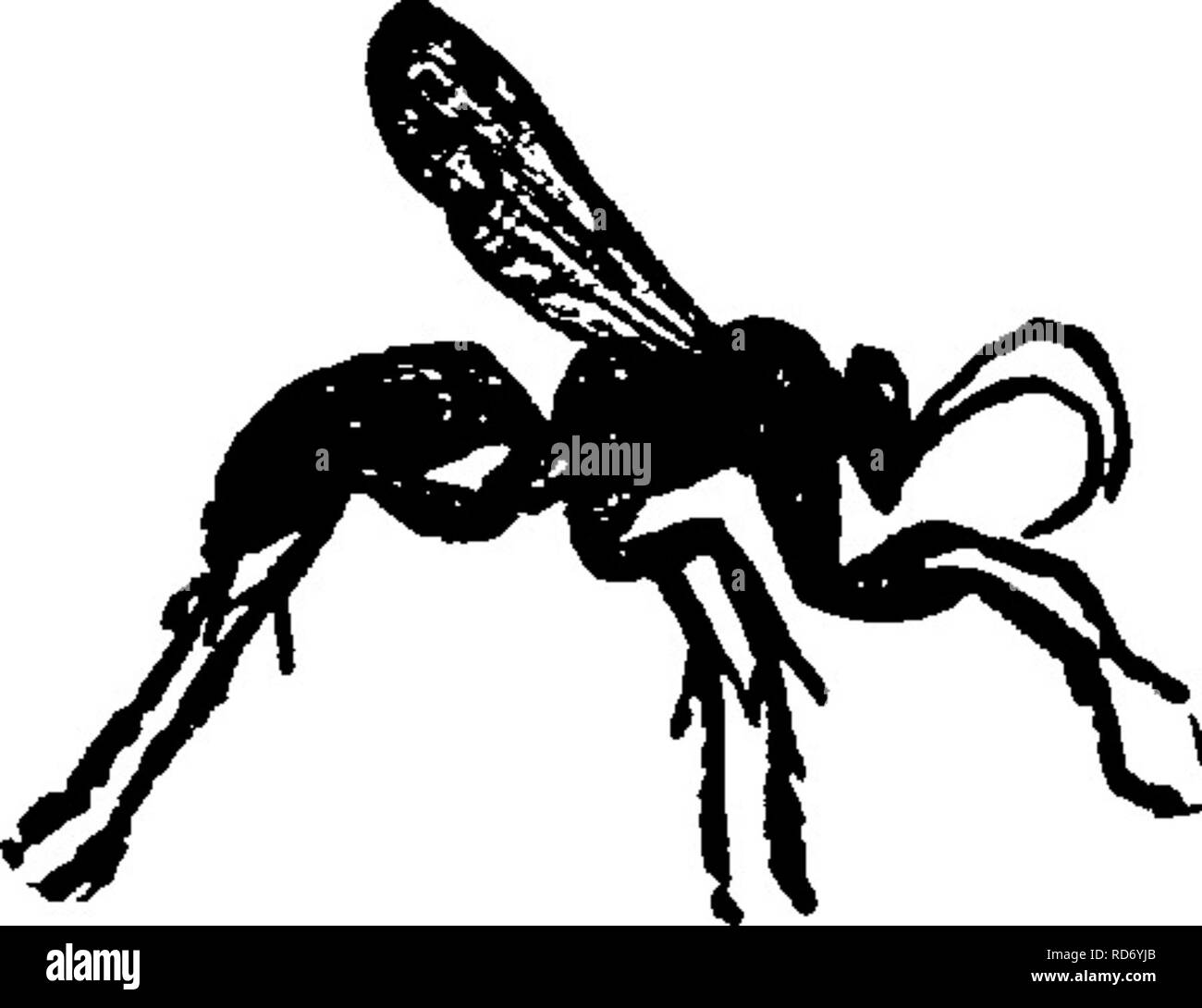 . A manual for the study of insects. Insects. 650 THE STUD V OF INSECTS. Family POMPILID^ (Pom-piri-dae). The Spider-wasps. The spider-wasps are so called because they provision their nests with spiders. They are slender in form, with long^ legs (Fig. 771), and are usually black with dusky reddish or black wings; sometimes they are variegated with red or orange. The . peduncle is short, so that the abdomen is very closely united to the thorax. Many of the YiG. jjx.— Fofnpilus, . .. . species are of medium size, but some are very large. In fact, the largest of all known Hymenoptera belong to th Stock Photohttps://www.alamy.com/image-license-details/?v=1https://www.alamy.com/a-manual-for-the-study-of-insects-insects-650-the-stud-v-of-insects-family-pompilid-pom-piri-dae-the-spider-wasps-the-spider-wasps-are-so-called-because-they-provision-their-nests-with-spiders-they-are-slender-in-form-with-long-legs-fig-771-and-are-usually-black-with-dusky-reddish-or-black-wings-sometimes-they-are-variegated-with-red-or-orange-the-peduncle-is-short-so-that-the-abdomen-is-very-closely-united-to-the-thorax-many-of-the-yig-jjx-fofnpilus-species-are-of-medium-size-but-some-are-very-large-in-fact-the-largest-of-all-known-hymenoptera-belong-to-th-image231878707.html
. A manual for the study of insects. Insects. 650 THE STUD V OF INSECTS. Family POMPILID^ (Pom-piri-dae). The Spider-wasps. The spider-wasps are so called because they provision their nests with spiders. They are slender in form, with long^ legs (Fig. 771), and are usually black with dusky reddish or black wings; sometimes they are variegated with red or orange. The . peduncle is short, so that the abdomen is very closely united to the thorax. Many of the YiG. jjx.— Fofnpilus, . .. . species are of medium size, but some are very large. In fact, the largest of all known Hymenoptera belong to th Stock Photohttps://www.alamy.com/image-license-details/?v=1https://www.alamy.com/a-manual-for-the-study-of-insects-insects-650-the-stud-v-of-insects-family-pompilid-pom-piri-dae-the-spider-wasps-the-spider-wasps-are-so-called-because-they-provision-their-nests-with-spiders-they-are-slender-in-form-with-long-legs-fig-771-and-are-usually-black-with-dusky-reddish-or-black-wings-sometimes-they-are-variegated-with-red-or-orange-the-peduncle-is-short-so-that-the-abdomen-is-very-closely-united-to-the-thorax-many-of-the-yig-jjx-fofnpilus-species-are-of-medium-size-but-some-are-very-large-in-fact-the-largest-of-all-known-hymenoptera-belong-to-th-image231878707.htmlRMRD6YJB–. A manual for the study of insects. Insects. 650 THE STUD V OF INSECTS. Family POMPILID^ (Pom-piri-dae). The Spider-wasps. The spider-wasps are so called because they provision their nests with spiders. They are slender in form, with long^ legs (Fig. 771), and are usually black with dusky reddish or black wings; sometimes they are variegated with red or orange. The . peduncle is short, so that the abdomen is very closely united to the thorax. Many of the YiG. jjx.— Fofnpilus, . .. . species are of medium size, but some are very large. In fact, the largest of all known Hymenoptera belong to th
 Cary, North Carolina, USA. 19th Apr, 2023. An orchard orbweaver, one of the most common spiders in the eastern United States. They are occasionally mistaken for black widow spiders because of the reddish-orange spots. (Credit Image: © Bob Karp/ZUMA Press Wire) EDITORIAL USAGE ONLY! Not for Commercial USAGE! Stock Photohttps://www.alamy.com/image-license-details/?v=1https://www.alamy.com/cary-north-carolina-usa-19th-apr-2023-an-orchard-orbweaver-one-of-the-most-common-spiders-in-the-eastern-united-states-they-are-occasionally-mistaken-for-black-widow-spiders-because-of-the-reddish-orange-spots-credit-image-bob-karpzuma-press-wire-editorial-usage-only!-not-for-commercial-usage!-image546828399.html
Cary, North Carolina, USA. 19th Apr, 2023. An orchard orbweaver, one of the most common spiders in the eastern United States. They are occasionally mistaken for black widow spiders because of the reddish-orange spots. (Credit Image: © Bob Karp/ZUMA Press Wire) EDITORIAL USAGE ONLY! Not for Commercial USAGE! Stock Photohttps://www.alamy.com/image-license-details/?v=1https://www.alamy.com/cary-north-carolina-usa-19th-apr-2023-an-orchard-orbweaver-one-of-the-most-common-spiders-in-the-eastern-united-states-they-are-occasionally-mistaken-for-black-widow-spiders-because-of-the-reddish-orange-spots-credit-image-bob-karpzuma-press-wire-editorial-usage-only!-not-for-commercial-usage!-image546828399.htmlRM2PNJ55K–Cary, North Carolina, USA. 19th Apr, 2023. An orchard orbweaver, one of the most common spiders in the eastern United States. They are occasionally mistaken for black widow spiders because of the reddish-orange spots. (Credit Image: © Bob Karp/ZUMA Press Wire) EDITORIAL USAGE ONLY! Not for Commercial USAGE!
 Die Arachniden, Nürnberg, In der C. H. Zeh'schen Buchhandlung, 1831-1848, arachnid, arachnida, The illustration features a collection of spiders, each labeled with a specific figure number. The top section presents two spiders: one with a distinctive yellow and black coloration and the other more understated in hue. The lower part includes two additional specimens: one displaying a reddish hue with distinct markings, and the other showcasing a more neutral brown coloration. Each spider is intricately detailed, emphasizing their unique physical characteristics, including leg structures and body Stock Photohttps://www.alamy.com/image-license-details/?v=1https://www.alamy.com/die-arachniden-nrnberg-in-der-c-h-zehschen-buchhandlung-1831-1848-arachnid-arachnida-the-illustration-features-a-collection-of-spiders-each-labeled-with-a-specific-figure-number-the-top-section-presents-two-spiders-one-with-a-distinctive-yellow-and-black-coloration-and-the-other-more-understated-in-hue-the-lower-part-includes-two-additional-specimens-one-displaying-a-reddish-hue-with-distinct-markings-and-the-other-showcasing-a-more-neutral-brown-coloration-each-spider-is-intricately-detailed-emphasizing-their-unique-physical-characteristics-including-leg-structures-and-body-image643575327.html
Die Arachniden, Nürnberg, In der C. H. Zeh'schen Buchhandlung, 1831-1848, arachnid, arachnida, The illustration features a collection of spiders, each labeled with a specific figure number. The top section presents two spiders: one with a distinctive yellow and black coloration and the other more understated in hue. The lower part includes two additional specimens: one displaying a reddish hue with distinct markings, and the other showcasing a more neutral brown coloration. Each spider is intricately detailed, emphasizing their unique physical characteristics, including leg structures and body Stock Photohttps://www.alamy.com/image-license-details/?v=1https://www.alamy.com/die-arachniden-nrnberg-in-der-c-h-zehschen-buchhandlung-1831-1848-arachnid-arachnida-the-illustration-features-a-collection-of-spiders-each-labeled-with-a-specific-figure-number-the-top-section-presents-two-spiders-one-with-a-distinctive-yellow-and-black-coloration-and-the-other-more-understated-in-hue-the-lower-part-includes-two-additional-specimens-one-displaying-a-reddish-hue-with-distinct-markings-and-the-other-showcasing-a-more-neutral-brown-coloration-each-spider-is-intricately-detailed-emphasizing-their-unique-physical-characteristics-including-leg-structures-and-body-image643575327.htmlRM2SB1AW3–Die Arachniden, Nürnberg, In der C. H. Zeh'schen Buchhandlung, 1831-1848, arachnid, arachnida, The illustration features a collection of spiders, each labeled with a specific figure number. The top section presents two spiders: one with a distinctive yellow and black coloration and the other more understated in hue. The lower part includes two additional specimens: one displaying a reddish hue with distinct markings, and the other showcasing a more neutral brown coloration. Each spider is intricately detailed, emphasizing their unique physical characteristics, including leg structures and body
 REDDISH PARACHUTE TARANTULA, Poecilotheria rufilata, RARE, Peppara Wildlife Sanctuary, Kerala Stock Photohttps://www.alamy.com/image-license-details/?v=1https://www.alamy.com/stock-photo-reddish-parachute-tarantula-poecilotheriarufilata-rare-peppara-wildlife-71437927.html
REDDISH PARACHUTE TARANTULA, Poecilotheria rufilata, RARE, Peppara Wildlife Sanctuary, Kerala Stock Photohttps://www.alamy.com/image-license-details/?v=1https://www.alamy.com/stock-photo-reddish-parachute-tarantula-poecilotheriarufilata-rare-peppara-wildlife-71437927.htmlRFE467PF–REDDISH PARACHUTE TARANTULA, Poecilotheria rufilata, RARE, Peppara Wildlife Sanctuary, Kerala
 . The common spiders of the United States. Spiders -- United States. THE CINIFLONID^;, OR CRIBELLATA 209 sides (fig. 475). The legs are light orange, darker than those of the female. The abdomen is dark reddish brown, some- times over the whole back, but usually with a yellow irregular middle spot smaller than that of the female. The ends of the male palpi are dark colored and as large as the spider's head (fig. 475). The hairs are very fine and light colored and do not modify the color as much as they do in the brown species. The length of volupis is not over an eighth of an inch. The abdomen Stock Photohttps://www.alamy.com/image-license-details/?v=1https://www.alamy.com/the-common-spiders-of-the-united-states-spiders-united-states-the-ciniflonid-or-cribellata-209-sides-fig-475-the-legs-are-light-orange-darker-than-those-of-the-female-the-abdomen-is-dark-reddish-brown-some-times-over-the-whole-back-but-usually-with-a-yellow-irregular-middle-spot-smaller-than-that-of-the-female-the-ends-of-the-male-palpi-are-dark-colored-and-as-large-as-the-spiders-head-fig-475-the-hairs-are-very-fine-and-light-colored-and-do-not-modify-the-color-as-much-as-they-do-in-the-brown-species-the-length-of-volupis-is-not-over-an-eighth-of-an-inch-the-abdomen-image232681188.html
. The common spiders of the United States. Spiders -- United States. THE CINIFLONID^;, OR CRIBELLATA 209 sides (fig. 475). The legs are light orange, darker than those of the female. The abdomen is dark reddish brown, some- times over the whole back, but usually with a yellow irregular middle spot smaller than that of the female. The ends of the male palpi are dark colored and as large as the spider's head (fig. 475). The hairs are very fine and light colored and do not modify the color as much as they do in the brown species. The length of volupis is not over an eighth of an inch. The abdomen Stock Photohttps://www.alamy.com/image-license-details/?v=1https://www.alamy.com/the-common-spiders-of-the-united-states-spiders-united-states-the-ciniflonid-or-cribellata-209-sides-fig-475-the-legs-are-light-orange-darker-than-those-of-the-female-the-abdomen-is-dark-reddish-brown-some-times-over-the-whole-back-but-usually-with-a-yellow-irregular-middle-spot-smaller-than-that-of-the-female-the-ends-of-the-male-palpi-are-dark-colored-and-as-large-as-the-spiders-head-fig-475-the-hairs-are-very-fine-and-light-colored-and-do-not-modify-the-color-as-much-as-they-do-in-the-brown-species-the-length-of-volupis-is-not-over-an-eighth-of-an-inch-the-abdomen-image232681188.htmlRMREFF6C–. The common spiders of the United States. Spiders -- United States. THE CINIFLONID^;, OR CRIBELLATA 209 sides (fig. 475). The legs are light orange, darker than those of the female. The abdomen is dark reddish brown, some- times over the whole back, but usually with a yellow irregular middle spot smaller than that of the female. The ends of the male palpi are dark colored and as large as the spider's head (fig. 475). The hairs are very fine and light colored and do not modify the color as much as they do in the brown species. The length of volupis is not over an eighth of an inch. The abdomen
 Cary, North Carolina, USA. 19th Apr, 2023. An orchard orbweaver, one of the most common spiders in the eastern United States. They are occasionally mistaken for black widow spiders because of the reddish-orange spots. (Credit Image: © Bob Karp/ZUMA Press Wire) EDITORIAL USAGE ONLY! Not for Commercial USAGE! Stock Photohttps://www.alamy.com/image-license-details/?v=1https://www.alamy.com/cary-north-carolina-usa-19th-apr-2023-an-orchard-orbweaver-one-of-the-most-common-spiders-in-the-eastern-united-states-they-are-occasionally-mistaken-for-black-widow-spiders-because-of-the-reddish-orange-spots-credit-image-bob-karpzuma-press-wire-editorial-usage-only!-not-for-commercial-usage!-image546828410.html
Cary, North Carolina, USA. 19th Apr, 2023. An orchard orbweaver, one of the most common spiders in the eastern United States. They are occasionally mistaken for black widow spiders because of the reddish-orange spots. (Credit Image: © Bob Karp/ZUMA Press Wire) EDITORIAL USAGE ONLY! Not for Commercial USAGE! Stock Photohttps://www.alamy.com/image-license-details/?v=1https://www.alamy.com/cary-north-carolina-usa-19th-apr-2023-an-orchard-orbweaver-one-of-the-most-common-spiders-in-the-eastern-united-states-they-are-occasionally-mistaken-for-black-widow-spiders-because-of-the-reddish-orange-spots-credit-image-bob-karpzuma-press-wire-editorial-usage-only!-not-for-commercial-usage!-image546828410.htmlRM2PNJ562–Cary, North Carolina, USA. 19th Apr, 2023. An orchard orbweaver, one of the most common spiders in the eastern United States. They are occasionally mistaken for black widow spiders because of the reddish-orange spots. (Credit Image: © Bob Karp/ZUMA Press Wire) EDITORIAL USAGE ONLY! Not for Commercial USAGE!
 Die, Arachniden, Nürnberg, In der C. H. Zeh'schen Buchhandlung,1831-1848, arachnid, Arachnida., The illustration features two distinct species of spiders, meticulously rendered to highlight their unique physical characteristics. The top spider exhibits elongated legs and a prominent, reddish-brown cephalothorax, with striking details on its body that suggest a nimble and agile nature. Below, the second spider showcases a more robust form, adorned with intricate patterns in shades of brown and tan, evoking a sense of camouflage against natural terrains. Both spiders are presented with labeled f Stock Photohttps://www.alamy.com/image-license-details/?v=1https://www.alamy.com/die-arachniden-nrnberg-in-der-c-h-zehschen-buchhandlung1831-1848-arachnid-arachnida-the-illustration-features-two-distinct-species-of-spiders-meticulously-rendered-to-highlight-their-unique-physical-characteristics-the-top-spider-exhibits-elongated-legs-and-a-prominent-reddish-brown-cephalothorax-with-striking-details-on-its-body-that-suggest-a-nimble-and-agile-nature-below-the-second-spider-showcases-a-more-robust-form-adorned-with-intricate-patterns-in-shades-of-brown-and-tan-evoking-a-sense-of-camouflage-against-natural-terrains-both-spiders-are-presented-with-labeled-f-image643608505.html
Die, Arachniden, Nürnberg, In der C. H. Zeh'schen Buchhandlung,1831-1848, arachnid, Arachnida., The illustration features two distinct species of spiders, meticulously rendered to highlight their unique physical characteristics. The top spider exhibits elongated legs and a prominent, reddish-brown cephalothorax, with striking details on its body that suggest a nimble and agile nature. Below, the second spider showcases a more robust form, adorned with intricate patterns in shades of brown and tan, evoking a sense of camouflage against natural terrains. Both spiders are presented with labeled f Stock Photohttps://www.alamy.com/image-license-details/?v=1https://www.alamy.com/die-arachniden-nrnberg-in-der-c-h-zehschen-buchhandlung1831-1848-arachnid-arachnida-the-illustration-features-two-distinct-species-of-spiders-meticulously-rendered-to-highlight-their-unique-physical-characteristics-the-top-spider-exhibits-elongated-legs-and-a-prominent-reddish-brown-cephalothorax-with-striking-details-on-its-body-that-suggest-a-nimble-and-agile-nature-below-the-second-spider-showcases-a-more-robust-form-adorned-with-intricate-patterns-in-shades-of-brown-and-tan-evoking-a-sense-of-camouflage-against-natural-terrains-both-spiders-are-presented-with-labeled-f-image643608505.htmlRM2SB2W61–Die, Arachniden, Nürnberg, In der C. H. Zeh'schen Buchhandlung,1831-1848, arachnid, Arachnida., The illustration features two distinct species of spiders, meticulously rendered to highlight their unique physical characteristics. The top spider exhibits elongated legs and a prominent, reddish-brown cephalothorax, with striking details on its body that suggest a nimble and agile nature. Below, the second spider showcases a more robust form, adorned with intricate patterns in shades of brown and tan, evoking a sense of camouflage against natural terrains. Both spiders are presented with labeled f
 REDDISH PARACHUTE TARANTULA, Poecilotheria rufilata, RARE, Peppara Wildlife Sanctuary, Kerala Stock Photohttps://www.alamy.com/image-license-details/?v=1https://www.alamy.com/stock-photo-reddish-parachute-tarantula-poecilotheriarufilata-rare-peppara-wildlife-71437961.html
REDDISH PARACHUTE TARANTULA, Poecilotheria rufilata, RARE, Peppara Wildlife Sanctuary, Kerala Stock Photohttps://www.alamy.com/image-license-details/?v=1https://www.alamy.com/stock-photo-reddish-parachute-tarantula-poecilotheriarufilata-rare-peppara-wildlife-71437961.htmlRFE467RN–REDDISH PARACHUTE TARANTULA, Poecilotheria rufilata, RARE, Peppara Wildlife Sanctuary, Kerala
 GIANT WOOD SPIDER male genus Nephila. Male is smaller upto 10mm and reddish brown. Female grows to 2 - 4 inches Stock Photohttps://www.alamy.com/image-license-details/?v=1https://www.alamy.com/stock-photo-giant-wood-spider-male-genus-nephila-male-is-smaller-upto-10mm-and-38306456.html
GIANT WOOD SPIDER male genus Nephila. Male is smaller upto 10mm and reddish brown. Female grows to 2 - 4 inches Stock Photohttps://www.alamy.com/image-license-details/?v=1https://www.alamy.com/stock-photo-giant-wood-spider-male-genus-nephila-male-is-smaller-upto-10mm-and-38306456.htmlRFC6907M–GIANT WOOD SPIDER male genus Nephila. Male is smaller upto 10mm and reddish brown. Female grows to 2 - 4 inches
 Velvet ground dwelling spider, Palpimanus gibbulus, Satara, Maharashtra, India Stock Photohttps://www.alamy.com/image-license-details/?v=1https://www.alamy.com/velvet-ground-dwelling-spider-palpimanus-gibbulus-satara-maharashtra-india-image398479158.html
Velvet ground dwelling spider, Palpimanus gibbulus, Satara, Maharashtra, India Stock Photohttps://www.alamy.com/image-license-details/?v=1https://www.alamy.com/velvet-ground-dwelling-spider-palpimanus-gibbulus-satara-maharashtra-india-image398479158.htmlRF2E4886E–Velvet ground dwelling spider, Palpimanus gibbulus, Satara, Maharashtra, India
 . The biology of spiders. Spiders; Insects. 26o THE BIOLOGY OF SPIDERS Alternatives in Development—Dimorphism The normal development of the individual spider is a repetition of that of its parents and is similar to that of its brothers, but there are a few species in which alternative types may arise. One instance of this is the female of a spider already mentioned (p. 159), Misumena vatia, which sometimes has reddish streaks on its abdomen and sometimes has not. A much commoner British spider, which is to be found almost everywhere in summer months, is one of the Theri- diidae, Phyllonethis l Stock Photohttps://www.alamy.com/image-license-details/?v=1https://www.alamy.com/the-biology-of-spiders-spiders-insects-26o-the-biology-of-spiders-alternatives-in-developmentdimorphism-the-normal-development-of-the-individual-spider-is-a-repetition-of-that-of-its-parents-and-is-similar-to-that-of-its-brothers-but-there-are-a-few-species-in-which-alternative-types-may-arise-one-instance-of-this-is-the-female-of-a-spider-already-mentioned-p-159-misumena-vatia-which-sometimes-has-reddish-streaks-on-its-abdomen-and-sometimes-has-not-a-much-commoner-british-spider-which-is-to-be-found-almost-everywhere-in-summer-months-is-one-of-the-theri-diidae-phyllonethis-l-image234603850.html
. The biology of spiders. Spiders; Insects. 26o THE BIOLOGY OF SPIDERS Alternatives in Development—Dimorphism The normal development of the individual spider is a repetition of that of its parents and is similar to that of its brothers, but there are a few species in which alternative types may arise. One instance of this is the female of a spider already mentioned (p. 159), Misumena vatia, which sometimes has reddish streaks on its abdomen and sometimes has not. A much commoner British spider, which is to be found almost everywhere in summer months, is one of the Theri- diidae, Phyllonethis l Stock Photohttps://www.alamy.com/image-license-details/?v=1https://www.alamy.com/the-biology-of-spiders-spiders-insects-26o-the-biology-of-spiders-alternatives-in-developmentdimorphism-the-normal-development-of-the-individual-spider-is-a-repetition-of-that-of-its-parents-and-is-similar-to-that-of-its-brothers-but-there-are-a-few-species-in-which-alternative-types-may-arise-one-instance-of-this-is-the-female-of-a-spider-already-mentioned-p-159-misumena-vatia-which-sometimes-has-reddish-streaks-on-its-abdomen-and-sometimes-has-not-a-much-commoner-british-spider-which-is-to-be-found-almost-everywhere-in-summer-months-is-one-of-the-theri-diidae-phyllonethis-l-image234603850.htmlRMRHK3GX–. The biology of spiders. Spiders; Insects. 26o THE BIOLOGY OF SPIDERS Alternatives in Development—Dimorphism The normal development of the individual spider is a repetition of that of its parents and is similar to that of its brothers, but there are a few species in which alternative types may arise. One instance of this is the female of a spider already mentioned (p. 159), Misumena vatia, which sometimes has reddish streaks on its abdomen and sometimes has not. A much commoner British spider, which is to be found almost everywhere in summer months, is one of the Theri- diidae, Phyllonethis l
 Cary, North Carolina, USA. 19th Apr, 2023. An orchard orbweaver, one of the most common spiders in the eastern United States. They are occasionally mistaken for black widow spiders because of the reddish-orange spots. (Credit Image: © Bob Karp/ZUMA Press Wire) EDITORIAL USAGE ONLY! Not for Commercial USAGE! Stock Photohttps://www.alamy.com/image-license-details/?v=1https://www.alamy.com/cary-north-carolina-usa-19th-apr-2023-an-orchard-orbweaver-one-of-the-most-common-spiders-in-the-eastern-united-states-they-are-occasionally-mistaken-for-black-widow-spiders-because-of-the-reddish-orange-spots-credit-image-bob-karpzuma-press-wire-editorial-usage-only!-not-for-commercial-usage!-image546829163.html
Cary, North Carolina, USA. 19th Apr, 2023. An orchard orbweaver, one of the most common spiders in the eastern United States. They are occasionally mistaken for black widow spiders because of the reddish-orange spots. (Credit Image: © Bob Karp/ZUMA Press Wire) EDITORIAL USAGE ONLY! Not for Commercial USAGE! Stock Photohttps://www.alamy.com/image-license-details/?v=1https://www.alamy.com/cary-north-carolina-usa-19th-apr-2023-an-orchard-orbweaver-one-of-the-most-common-spiders-in-the-eastern-united-states-they-are-occasionally-mistaken-for-black-widow-spiders-because-of-the-reddish-orange-spots-credit-image-bob-karpzuma-press-wire-editorial-usage-only!-not-for-commercial-usage!-image546829163.htmlRM2PNJ64Y–Cary, North Carolina, USA. 19th Apr, 2023. An orchard orbweaver, one of the most common spiders in the eastern United States. They are occasionally mistaken for black widow spiders because of the reddish-orange spots. (Credit Image: © Bob Karp/ZUMA Press Wire) EDITORIAL USAGE ONLY! Not for Commercial USAGE!
 Die Arachniden, Nürnberg, In der C. H. Zeh'schen Buchhandlung, 1831-1848 Arachnid, Arachnida, The illustration features a detailed study of various spider species, showcasing their distinct anatomical features and coloration. Four different spiders are depicted, each labeled with a figure number for reference. The first spider, shown in the top position, exhibits a velvety brown body with bold reddish markings. The second example below it features a lighter body with a noticeable pattern, while the third spider displays a unique coloration that contrasts with the others. The last spider at the Stock Photohttps://www.alamy.com/image-license-details/?v=1https://www.alamy.com/die-arachniden-nrnberg-in-der-c-h-zehschen-buchhandlung-1831-1848-arachnid-arachnida-the-illustration-features-a-detailed-study-of-various-spider-species-showcasing-their-distinct-anatomical-features-and-coloration-four-different-spiders-are-depicted-each-labeled-with-a-figure-number-for-reference-the-first-spider-shown-in-the-top-position-exhibits-a-velvety-brown-body-with-bold-reddish-markings-the-second-example-below-it-features-a-lighter-body-with-a-noticeable-pattern-while-the-third-spider-displays-a-unique-coloration-that-contrasts-with-the-others-the-last-spider-at-the-image643615222.html
Die Arachniden, Nürnberg, In der C. H. Zeh'schen Buchhandlung, 1831-1848 Arachnid, Arachnida, The illustration features a detailed study of various spider species, showcasing their distinct anatomical features and coloration. Four different spiders are depicted, each labeled with a figure number for reference. The first spider, shown in the top position, exhibits a velvety brown body with bold reddish markings. The second example below it features a lighter body with a noticeable pattern, while the third spider displays a unique coloration that contrasts with the others. The last spider at the Stock Photohttps://www.alamy.com/image-license-details/?v=1https://www.alamy.com/die-arachniden-nrnberg-in-der-c-h-zehschen-buchhandlung-1831-1848-arachnid-arachnida-the-illustration-features-a-detailed-study-of-various-spider-species-showcasing-their-distinct-anatomical-features-and-coloration-four-different-spiders-are-depicted-each-labeled-with-a-figure-number-for-reference-the-first-spider-shown-in-the-top-position-exhibits-a-velvety-brown-body-with-bold-reddish-markings-the-second-example-below-it-features-a-lighter-body-with-a-noticeable-pattern-while-the-third-spider-displays-a-unique-coloration-that-contrasts-with-the-others-the-last-spider-at-the-image643615222.htmlRM2SB35NX–Die Arachniden, Nürnberg, In der C. H. Zeh'schen Buchhandlung, 1831-1848 Arachnid, Arachnida, The illustration features a detailed study of various spider species, showcasing their distinct anatomical features and coloration. Four different spiders are depicted, each labeled with a figure number for reference. The first spider, shown in the top position, exhibits a velvety brown body with bold reddish markings. The second example below it features a lighter body with a noticeable pattern, while the third spider displays a unique coloration that contrasts with the others. The last spider at the
 . The common spiders of the United States. Spiders. THE CINIFLONID^, OR CRIBELLATA 209 sides (fig. 475). The legs are light orange, darker than those of the female. The abdomen is dark reddish brown, some- times over the whole back, but usually with a yellow irregular middle spot smaller than that of the female. The ends of the male palpi are dark colored and as large as the spider's head (fig. 475). The hairs are very fine and light colored and do not modify the color as much as they do in the brown species. The length of volupis is not over an eighth of an inch. The abdomen is oval and not a Stock Photohttps://www.alamy.com/image-license-details/?v=1https://www.alamy.com/the-common-spiders-of-the-united-states-spiders-the-ciniflonid-or-cribellata-209-sides-fig-475-the-legs-are-light-orange-darker-than-those-of-the-female-the-abdomen-is-dark-reddish-brown-some-times-over-the-whole-back-but-usually-with-a-yellow-irregular-middle-spot-smaller-than-that-of-the-female-the-ends-of-the-male-palpi-are-dark-colored-and-as-large-as-the-spiders-head-fig-475-the-hairs-are-very-fine-and-light-colored-and-do-not-modify-the-color-as-much-as-they-do-in-the-brown-species-the-length-of-volupis-is-not-over-an-eighth-of-an-inch-the-abdomen-is-oval-and-not-a-image232683315.html
. The common spiders of the United States. Spiders. THE CINIFLONID^, OR CRIBELLATA 209 sides (fig. 475). The legs are light orange, darker than those of the female. The abdomen is dark reddish brown, some- times over the whole back, but usually with a yellow irregular middle spot smaller than that of the female. The ends of the male palpi are dark colored and as large as the spider's head (fig. 475). The hairs are very fine and light colored and do not modify the color as much as they do in the brown species. The length of volupis is not over an eighth of an inch. The abdomen is oval and not a Stock Photohttps://www.alamy.com/image-license-details/?v=1https://www.alamy.com/the-common-spiders-of-the-united-states-spiders-the-ciniflonid-or-cribellata-209-sides-fig-475-the-legs-are-light-orange-darker-than-those-of-the-female-the-abdomen-is-dark-reddish-brown-some-times-over-the-whole-back-but-usually-with-a-yellow-irregular-middle-spot-smaller-than-that-of-the-female-the-ends-of-the-male-palpi-are-dark-colored-and-as-large-as-the-spiders-head-fig-475-the-hairs-are-very-fine-and-light-colored-and-do-not-modify-the-color-as-much-as-they-do-in-the-brown-species-the-length-of-volupis-is-not-over-an-eighth-of-an-inch-the-abdomen-is-oval-and-not-a-image232683315.htmlRMREFHXB–. The common spiders of the United States. Spiders. THE CINIFLONID^, OR CRIBELLATA 209 sides (fig. 475). The legs are light orange, darker than those of the female. The abdomen is dark reddish brown, some- times over the whole back, but usually with a yellow irregular middle spot smaller than that of the female. The ends of the male palpi are dark colored and as large as the spider's head (fig. 475). The hairs are very fine and light colored and do not modify the color as much as they do in the brown species. The length of volupis is not over an eighth of an inch. The abdomen is oval and not a
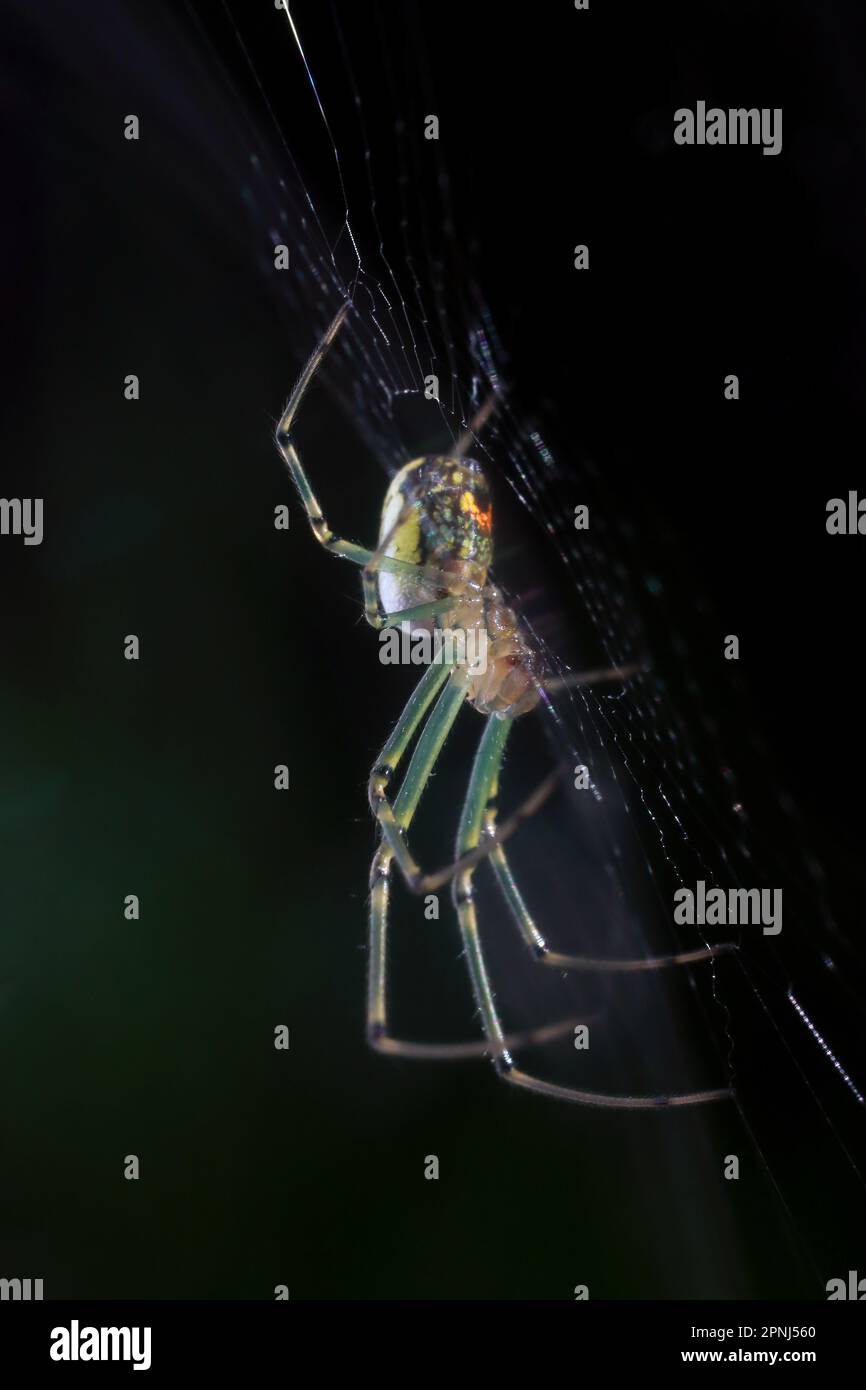 Cary, North Carolina, USA. 19th Apr, 2023. An orchard orbweaver, one of the most common spiders in the eastern United States. They are occasionally mistaken for black widow spiders because of the reddish-orange spots. (Credit Image: © Bob Karp/ZUMA Press Wire) EDITORIAL USAGE ONLY! Not for Commercial USAGE! Stock Photohttps://www.alamy.com/image-license-details/?v=1https://www.alamy.com/cary-north-carolina-usa-19th-apr-2023-an-orchard-orbweaver-one-of-the-most-common-spiders-in-the-eastern-united-states-they-are-occasionally-mistaken-for-black-widow-spiders-because-of-the-reddish-orange-spots-credit-image-bob-karpzuma-press-wire-editorial-usage-only!-not-for-commercial-usage!-image546828408.html
Cary, North Carolina, USA. 19th Apr, 2023. An orchard orbweaver, one of the most common spiders in the eastern United States. They are occasionally mistaken for black widow spiders because of the reddish-orange spots. (Credit Image: © Bob Karp/ZUMA Press Wire) EDITORIAL USAGE ONLY! Not for Commercial USAGE! Stock Photohttps://www.alamy.com/image-license-details/?v=1https://www.alamy.com/cary-north-carolina-usa-19th-apr-2023-an-orchard-orbweaver-one-of-the-most-common-spiders-in-the-eastern-united-states-they-are-occasionally-mistaken-for-black-widow-spiders-because-of-the-reddish-orange-spots-credit-image-bob-karpzuma-press-wire-editorial-usage-only!-not-for-commercial-usage!-image546828408.htmlRM2PNJ560–Cary, North Carolina, USA. 19th Apr, 2023. An orchard orbweaver, one of the most common spiders in the eastern United States. They are occasionally mistaken for black widow spiders because of the reddish-orange spots. (Credit Image: © Bob Karp/ZUMA Press Wire) EDITORIAL USAGE ONLY! Not for Commercial USAGE!
 Die, Arachniden, Nürnberg, In der, C. H, Zeh'schen, Buchhandlung, 1831-1848, arachnid, arachnida,, A detailed illustration showcasing three distinct species of spiders from the genus Rhacophorus. The top specimen, labeled Fig. 4800, features a prominent reddish-brown body with reddish-orange accents and visible hairy legs, emphasizing its robust appearance. The middle example, Fig. 4801, is characterized by its striking black and white coloration, showcasing contrasting patterns on its abdomen and limbs, suggesting camouflage and potential warning coloration. The bottom specimen, Fig. 4802, di Stock Photohttps://www.alamy.com/image-license-details/?v=1https://www.alamy.com/die-arachniden-nrnberg-in-der-c-h-zehschen-buchhandlung-1831-1848-arachnid-arachnida-a-detailed-illustration-showcasing-three-distinct-species-of-spiders-from-the-genus-rhacophorus-the-top-specimen-labeled-fig-4800-features-a-prominent-reddish-brown-body-with-reddish-orange-accents-and-visible-hairy-legs-emphasizing-its-robust-appearance-the-middle-example-fig-4801-is-characterized-by-its-striking-black-and-white-coloration-showcasing-contrasting-patterns-on-its-abdomen-and-limbs-suggesting-camouflage-and-potential-warning-coloration-the-bottom-specimen-fig-4802-di-image643570436.html
Die, Arachniden, Nürnberg, In der, C. H, Zeh'schen, Buchhandlung, 1831-1848, arachnid, arachnida,, A detailed illustration showcasing three distinct species of spiders from the genus Rhacophorus. The top specimen, labeled Fig. 4800, features a prominent reddish-brown body with reddish-orange accents and visible hairy legs, emphasizing its robust appearance. The middle example, Fig. 4801, is characterized by its striking black and white coloration, showcasing contrasting patterns on its abdomen and limbs, suggesting camouflage and potential warning coloration. The bottom specimen, Fig. 4802, di Stock Photohttps://www.alamy.com/image-license-details/?v=1https://www.alamy.com/die-arachniden-nrnberg-in-der-c-h-zehschen-buchhandlung-1831-1848-arachnid-arachnida-a-detailed-illustration-showcasing-three-distinct-species-of-spiders-from-the-genus-rhacophorus-the-top-specimen-labeled-fig-4800-features-a-prominent-reddish-brown-body-with-reddish-orange-accents-and-visible-hairy-legs-emphasizing-its-robust-appearance-the-middle-example-fig-4801-is-characterized-by-its-striking-black-and-white-coloration-showcasing-contrasting-patterns-on-its-abdomen-and-limbs-suggesting-camouflage-and-potential-warning-coloration-the-bottom-specimen-fig-4802-di-image643570436.htmlRM2SB14JC–Die, Arachniden, Nürnberg, In der, C. H, Zeh'schen, Buchhandlung, 1831-1848, arachnid, arachnida,, A detailed illustration showcasing three distinct species of spiders from the genus Rhacophorus. The top specimen, labeled Fig. 4800, features a prominent reddish-brown body with reddish-orange accents and visible hairy legs, emphasizing its robust appearance. The middle example, Fig. 4801, is characterized by its striking black and white coloration, showcasing contrasting patterns on its abdomen and limbs, suggesting camouflage and potential warning coloration. The bottom specimen, Fig. 4802, di
 . Bulletin. Agriculture -- Ontario. 36 pound in 6 gallons of water, may be used instead of Black Leaf 40, but should not be combined with lime-sulphur. It is almost useless to spray after the leaves have become curled because it is then impossible to hit all or nearly all the aphids. Eed Spiders {Teiranyclius himaculatus).—Red Spiders are mites that feed on the under surface of the leaves of numerous plants. They have sucking mouth parts and cause currant leaves to become brownish or reddish-yellow in color and therefore unhealthy in appearance. Such leaves in dry weather, when the plants need Stock Photohttps://www.alamy.com/image-license-details/?v=1https://www.alamy.com/bulletin-agriculture-ontario-36-pound-in-6-gallons-of-water-may-be-used-instead-of-black-leaf-40-but-should-not-be-combined-with-lime-sulphur-it-is-almost-useless-to-spray-after-the-leaves-have-become-curled-because-it-is-then-impossible-to-hit-all-or-nearly-all-the-aphids-eed-spiders-teiranyclius-himaculatusred-spiders-are-mites-that-feed-on-the-under-surface-of-the-leaves-of-numerous-plants-they-have-sucking-mouth-parts-and-cause-currant-leaves-to-become-brownish-or-reddish-yellow-in-color-and-therefore-unhealthy-in-appearance-such-leaves-in-dry-weather-when-the-plants-need-image234207453.html
. Bulletin. Agriculture -- Ontario. 36 pound in 6 gallons of water, may be used instead of Black Leaf 40, but should not be combined with lime-sulphur. It is almost useless to spray after the leaves have become curled because it is then impossible to hit all or nearly all the aphids. Eed Spiders {Teiranyclius himaculatus).—Red Spiders are mites that feed on the under surface of the leaves of numerous plants. They have sucking mouth parts and cause currant leaves to become brownish or reddish-yellow in color and therefore unhealthy in appearance. Such leaves in dry weather, when the plants need Stock Photohttps://www.alamy.com/image-license-details/?v=1https://www.alamy.com/bulletin-agriculture-ontario-36-pound-in-6-gallons-of-water-may-be-used-instead-of-black-leaf-40-but-should-not-be-combined-with-lime-sulphur-it-is-almost-useless-to-spray-after-the-leaves-have-become-curled-because-it-is-then-impossible-to-hit-all-or-nearly-all-the-aphids-eed-spiders-teiranyclius-himaculatusred-spiders-are-mites-that-feed-on-the-under-surface-of-the-leaves-of-numerous-plants-they-have-sucking-mouth-parts-and-cause-currant-leaves-to-become-brownish-or-reddish-yellow-in-color-and-therefore-unhealthy-in-appearance-such-leaves-in-dry-weather-when-the-plants-need-image234207453.htmlRMRH11YW–. Bulletin. Agriculture -- Ontario. 36 pound in 6 gallons of water, may be used instead of Black Leaf 40, but should not be combined with lime-sulphur. It is almost useless to spray after the leaves have become curled because it is then impossible to hit all or nearly all the aphids. Eed Spiders {Teiranyclius himaculatus).—Red Spiders are mites that feed on the under surface of the leaves of numerous plants. They have sucking mouth parts and cause currant leaves to become brownish or reddish-yellow in color and therefore unhealthy in appearance. Such leaves in dry weather, when the plants need
 Cary, North Carolina, USA. 19th Apr, 2023. An orchard orbweaver, one of the most common spiders in the eastern United States. They are occasionally mistaken for black widow spiders because of the reddish-orange spots. (Credit Image: © Bob Karp/ZUMA Press Wire) EDITORIAL USAGE ONLY! Not for Commercial USAGE! Stock Photohttps://www.alamy.com/image-license-details/?v=1https://www.alamy.com/cary-north-carolina-usa-19th-apr-2023-an-orchard-orbweaver-one-of-the-most-common-spiders-in-the-eastern-united-states-they-are-occasionally-mistaken-for-black-widow-spiders-because-of-the-reddish-orange-spots-credit-image-bob-karpzuma-press-wire-editorial-usage-only!-not-for-commercial-usage!-image546833087.html
Cary, North Carolina, USA. 19th Apr, 2023. An orchard orbweaver, one of the most common spiders in the eastern United States. They are occasionally mistaken for black widow spiders because of the reddish-orange spots. (Credit Image: © Bob Karp/ZUMA Press Wire) EDITORIAL USAGE ONLY! Not for Commercial USAGE! Stock Photohttps://www.alamy.com/image-license-details/?v=1https://www.alamy.com/cary-north-carolina-usa-19th-apr-2023-an-orchard-orbweaver-one-of-the-most-common-spiders-in-the-eastern-united-states-they-are-occasionally-mistaken-for-black-widow-spiders-because-of-the-reddish-orange-spots-credit-image-bob-karpzuma-press-wire-editorial-usage-only!-not-for-commercial-usage!-image546833087.htmlRM2PNJB53–Cary, North Carolina, USA. 19th Apr, 2023. An orchard orbweaver, one of the most common spiders in the eastern United States. They are occasionally mistaken for black widow spiders because of the reddish-orange spots. (Credit Image: © Bob Karp/ZUMA Press Wire) EDITORIAL USAGE ONLY! Not for Commercial USAGE!
 Die, Arachniden, Nürnberg, In, der, C. H. Zeh'schen, Buchhandlung, 1831-1848, arachnid, Arachnida, The illustration features several spider species displayed in a scientific style. There are four distinct spiders, with their characteristics meticulously detailed. On the left, a reddish-brown spider is depicted, showcasing a robust body and prominent legs. To its right, another spider is illustrated with a lighter hue and a distinct body shape, emphasizing its unique markings. Below them, a larger spider with elongated legs is presented, featuring intricate patterns on its abdomen. Finally, a d Stock Photohttps://www.alamy.com/image-license-details/?v=1https://www.alamy.com/die-arachniden-nrnberg-in-der-c-h-zehschen-buchhandlung-1831-1848-arachnid-arachnida-the-illustration-features-several-spider-species-displayed-in-a-scientific-style-there-are-four-distinct-spiders-with-their-characteristics-meticulously-detailed-on-the-left-a-reddish-brown-spider-is-depicted-showcasing-a-robust-body-and-prominent-legs-to-its-right-another-spider-is-illustrated-with-a-lighter-hue-and-a-distinct-body-shape-emphasizing-its-unique-markings-below-them-a-larger-spider-with-elongated-legs-is-presented-featuring-intricate-patterns-on-its-abdomen-finally-a-d-image643596738.html
Die, Arachniden, Nürnberg, In, der, C. H. Zeh'schen, Buchhandlung, 1831-1848, arachnid, Arachnida, The illustration features several spider species displayed in a scientific style. There are four distinct spiders, with their characteristics meticulously detailed. On the left, a reddish-brown spider is depicted, showcasing a robust body and prominent legs. To its right, another spider is illustrated with a lighter hue and a distinct body shape, emphasizing its unique markings. Below them, a larger spider with elongated legs is presented, featuring intricate patterns on its abdomen. Finally, a d Stock Photohttps://www.alamy.com/image-license-details/?v=1https://www.alamy.com/die-arachniden-nrnberg-in-der-c-h-zehschen-buchhandlung-1831-1848-arachnid-arachnida-the-illustration-features-several-spider-species-displayed-in-a-scientific-style-there-are-four-distinct-spiders-with-their-characteristics-meticulously-detailed-on-the-left-a-reddish-brown-spider-is-depicted-showcasing-a-robust-body-and-prominent-legs-to-its-right-another-spider-is-illustrated-with-a-lighter-hue-and-a-distinct-body-shape-emphasizing-its-unique-markings-below-them-a-larger-spider-with-elongated-legs-is-presented-featuring-intricate-patterns-on-its-abdomen-finally-a-d-image643596738.htmlRM2SB2A5P–Die, Arachniden, Nürnberg, In, der, C. H. Zeh'schen, Buchhandlung, 1831-1848, arachnid, Arachnida, The illustration features several spider species displayed in a scientific style. There are four distinct spiders, with their characteristics meticulously detailed. On the left, a reddish-brown spider is depicted, showcasing a robust body and prominent legs. To its right, another spider is illustrated with a lighter hue and a distinct body shape, emphasizing its unique markings. Below them, a larger spider with elongated legs is presented, featuring intricate patterns on its abdomen. Finally, a d
 . The culture and diseases of the sweet pea. 132 DISEASES OF THE SWEET PEA. FIG. 21. THE RED SPIDER, ENLARGED. (aFTER BANKS.) tack both leaves and stems, the method of attack and the resulting injury somewhat resembling that of mites. However, the spots caused by red spiders are reddish in- stead of a pale white. Life History. The adult female is usu- ally brick red in color and the male is red- dish amber. Frequently, however, the color of the red spider changes according to locality and food plants. The female lays. Please note that these images are extracted from scanned page images that ma Stock Photohttps://www.alamy.com/image-license-details/?v=1https://www.alamy.com/the-culture-and-diseases-of-the-sweet-pea-132-diseases-of-the-sweet-pea-fig-21-the-red-spider-enlarged-after-banks-tack-both-leaves-and-stems-the-method-of-attack-and-the-resulting-injury-somewhat-resembling-that-of-mites-however-the-spots-caused-by-red-spiders-are-reddish-in-stead-of-a-pale-white-life-history-the-adult-female-is-usu-ally-brick-red-in-color-and-the-male-is-red-dish-amber-frequently-however-the-color-of-the-red-spider-changes-according-to-locality-and-food-plants-the-female-lays-please-note-that-these-images-are-extracted-from-scanned-page-images-that-ma-image231875482.html
. The culture and diseases of the sweet pea. 132 DISEASES OF THE SWEET PEA. FIG. 21. THE RED SPIDER, ENLARGED. (aFTER BANKS.) tack both leaves and stems, the method of attack and the resulting injury somewhat resembling that of mites. However, the spots caused by red spiders are reddish in- stead of a pale white. Life History. The adult female is usu- ally brick red in color and the male is red- dish amber. Frequently, however, the color of the red spider changes according to locality and food plants. The female lays. Please note that these images are extracted from scanned page images that ma Stock Photohttps://www.alamy.com/image-license-details/?v=1https://www.alamy.com/the-culture-and-diseases-of-the-sweet-pea-132-diseases-of-the-sweet-pea-fig-21-the-red-spider-enlarged-after-banks-tack-both-leaves-and-stems-the-method-of-attack-and-the-resulting-injury-somewhat-resembling-that-of-mites-however-the-spots-caused-by-red-spiders-are-reddish-in-stead-of-a-pale-white-life-history-the-adult-female-is-usu-ally-brick-red-in-color-and-the-male-is-red-dish-amber-frequently-however-the-color-of-the-red-spider-changes-according-to-locality-and-food-plants-the-female-lays-please-note-that-these-images-are-extracted-from-scanned-page-images-that-ma-image231875482.htmlRMRD6RF6–. The culture and diseases of the sweet pea. 132 DISEASES OF THE SWEET PEA. FIG. 21. THE RED SPIDER, ENLARGED. (aFTER BANKS.) tack both leaves and stems, the method of attack and the resulting injury somewhat resembling that of mites. However, the spots caused by red spiders are reddish in- stead of a pale white. Life History. The adult female is usu- ally brick red in color and the male is red- dish amber. Frequently, however, the color of the red spider changes according to locality and food plants. The female lays. Please note that these images are extracted from scanned page images that ma
 Monographia Aranearum = Monographie der Spinnen, Nurnberg, Lechner, [182, museums victoria, spiders, spider, arachnids, arachnida, Eresus cinnaberinus, Eresus kollari, Eresus annulatus, ladybird spider, Eresus sandaliatus, Franz von Paula Schrank, Eresus, niger, sandaliatus, annulatus, Araneae, Eresus niger, taxonomy: family = Eresidae, A scientific illustration depicting two species of spiders belonging to the genus Eresus. On the left, specimen A features distinct coloration, showcasing a reddish-brown body with prominent black markings, while specimen B on the right displays a different pat Stock Photohttps://www.alamy.com/image-license-details/?v=1https://www.alamy.com/monographia-aranearum-=-monographie-der-spinnen-nurnberg-lechner-182-museums-victoria-spiders-spider-arachnids-arachnida-eresus-cinnaberinus-eresus-kollari-eresus-annulatus-ladybird-spider-eresus-sandaliatus-franz-von-paula-schrank-eresus-niger-sandaliatus-annulatus-araneae-eresus-niger-taxonomy-family-=-eresidae-a-scientific-illustration-depicting-two-species-of-spiders-belonging-to-the-genus-eresus-on-the-left-specimen-a-features-distinct-coloration-showcasing-a-reddish-brown-body-with-prominent-black-markings-while-specimen-b-on-the-right-displays-a-different-pat-image636107606.html
Monographia Aranearum = Monographie der Spinnen, Nurnberg, Lechner, [182, museums victoria, spiders, spider, arachnids, arachnida, Eresus cinnaberinus, Eresus kollari, Eresus annulatus, ladybird spider, Eresus sandaliatus, Franz von Paula Schrank, Eresus, niger, sandaliatus, annulatus, Araneae, Eresus niger, taxonomy: family = Eresidae, A scientific illustration depicting two species of spiders belonging to the genus Eresus. On the left, specimen A features distinct coloration, showcasing a reddish-brown body with prominent black markings, while specimen B on the right displays a different pat Stock Photohttps://www.alamy.com/image-license-details/?v=1https://www.alamy.com/monographia-aranearum-=-monographie-der-spinnen-nurnberg-lechner-182-museums-victoria-spiders-spider-arachnids-arachnida-eresus-cinnaberinus-eresus-kollari-eresus-annulatus-ladybird-spider-eresus-sandaliatus-franz-von-paula-schrank-eresus-niger-sandaliatus-annulatus-araneae-eresus-niger-taxonomy-family-=-eresidae-a-scientific-illustration-depicting-two-species-of-spiders-belonging-to-the-genus-eresus-on-the-left-specimen-a-features-distinct-coloration-showcasing-a-reddish-brown-body-with-prominent-black-markings-while-specimen-b-on-the-right-displays-a-different-pat-image636107606.htmlRM2YXW5MP–Monographia Aranearum = Monographie der Spinnen, Nurnberg, Lechner, [182, museums victoria, spiders, spider, arachnids, arachnida, Eresus cinnaberinus, Eresus kollari, Eresus annulatus, ladybird spider, Eresus sandaliatus, Franz von Paula Schrank, Eresus, niger, sandaliatus, annulatus, Araneae, Eresus niger, taxonomy: family = Eresidae, A scientific illustration depicting two species of spiders belonging to the genus Eresus. On the left, specimen A features distinct coloration, showcasing a reddish-brown body with prominent black markings, while specimen B on the right displays a different pat
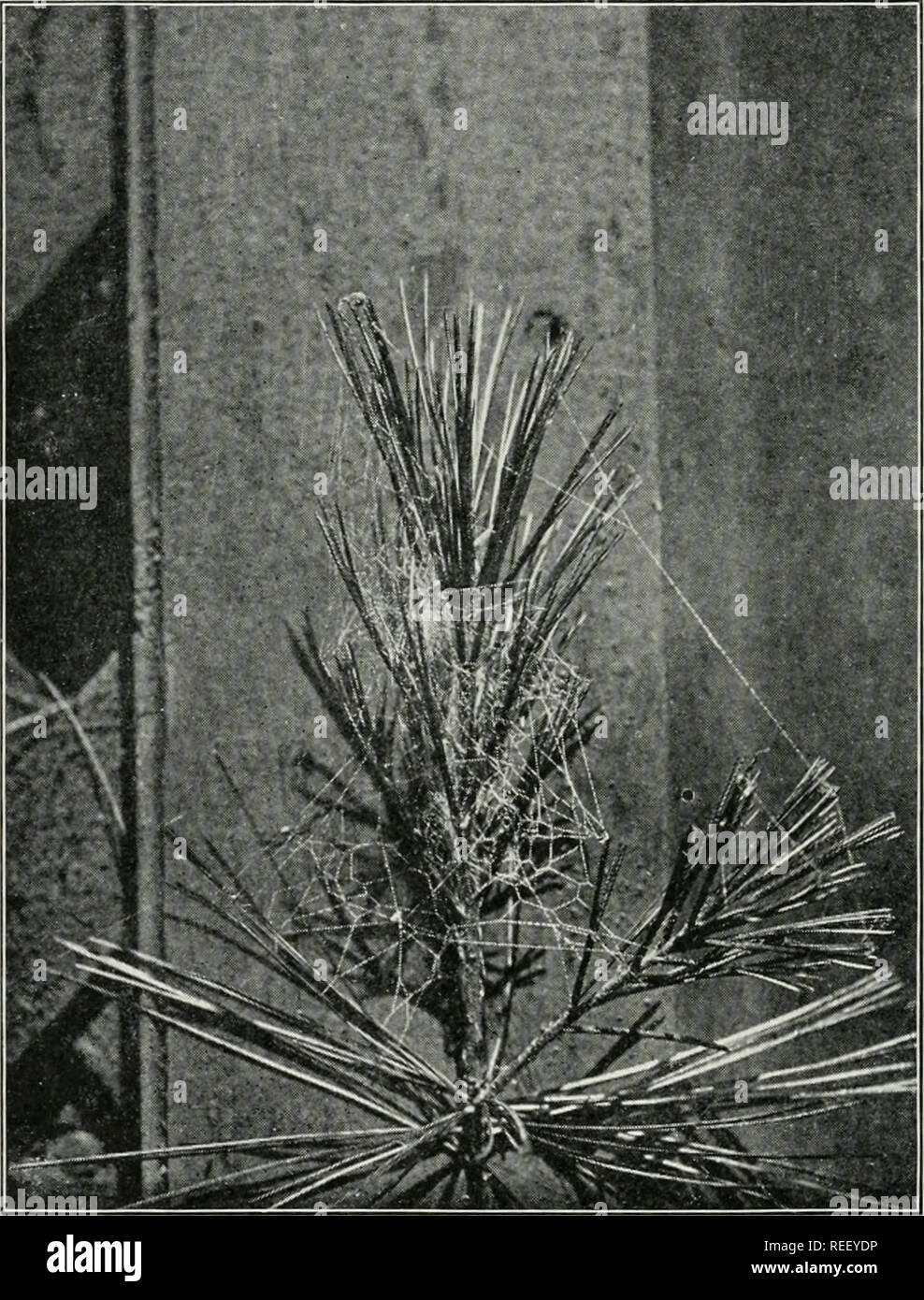 . The common spiders of the United States. Spiders. 114 THE COMMON SPIDERS Theridium differens. — Female about one-eighth of an inch long, and the male smaller. The abdomen is round, and the middle stripe often very brightly colored, with white or yellow at the edges and red in the middle (fig. 264). The rest of the. Fig. 263. Web of Theridium differens in the top of a young pine tree. Half the real size. abdomen is reddish brown, darkest next to the white edge of the stripe. There are no distinct marks on the under side. In males the stripe on the abdomen is obscure, and the whole abdomen dar Stock Photohttps://www.alamy.com/image-license-details/?v=1https://www.alamy.com/the-common-spiders-of-the-united-states-spiders-114-the-common-spiders-theridium-differens-female-about-one-eighth-of-an-inch-long-and-the-male-smaller-the-abdomen-is-round-and-the-middle-stripe-often-very-brightly-colored-with-white-or-yellow-at-the-edges-and-red-in-the-middle-fig-264-the-rest-of-the-fig-263-web-of-theridium-differens-in-the-top-of-a-young-pine-tree-half-the-real-size-abdomen-is-reddish-brown-darkest-next-to-the-white-edge-of-the-stripe-there-are-no-distinct-marks-on-the-under-side-in-males-the-stripe-on-the-abdomen-is-obscure-and-the-whole-abdomen-dar-image232668850.html
. The common spiders of the United States. Spiders. 114 THE COMMON SPIDERS Theridium differens. — Female about one-eighth of an inch long, and the male smaller. The abdomen is round, and the middle stripe often very brightly colored, with white or yellow at the edges and red in the middle (fig. 264). The rest of the. Fig. 263. Web of Theridium differens in the top of a young pine tree. Half the real size. abdomen is reddish brown, darkest next to the white edge of the stripe. There are no distinct marks on the under side. In males the stripe on the abdomen is obscure, and the whole abdomen dar Stock Photohttps://www.alamy.com/image-license-details/?v=1https://www.alamy.com/the-common-spiders-of-the-united-states-spiders-114-the-common-spiders-theridium-differens-female-about-one-eighth-of-an-inch-long-and-the-male-smaller-the-abdomen-is-round-and-the-middle-stripe-often-very-brightly-colored-with-white-or-yellow-at-the-edges-and-red-in-the-middle-fig-264-the-rest-of-the-fig-263-web-of-theridium-differens-in-the-top-of-a-young-pine-tree-half-the-real-size-abdomen-is-reddish-brown-darkest-next-to-the-white-edge-of-the-stripe-there-are-no-distinct-marks-on-the-under-side-in-males-the-stripe-on-the-abdomen-is-obscure-and-the-whole-abdomen-dar-image232668850.htmlRMREEYDP–. The common spiders of the United States. Spiders. 114 THE COMMON SPIDERS Theridium differens. — Female about one-eighth of an inch long, and the male smaller. The abdomen is round, and the middle stripe often very brightly colored, with white or yellow at the edges and red in the middle (fig. 264). The rest of the. Fig. 263. Web of Theridium differens in the top of a young pine tree. Half the real size. abdomen is reddish brown, darkest next to the white edge of the stripe. There are no distinct marks on the under side. In males the stripe on the abdomen is obscure, and the whole abdomen dar
 Die Arachniden, Nürnberg, In der C. H. Zeh'schen Buchhandlung, 1831-1848, arachnid, Arachnida, Two distinct spider species are illustrated, showcasing their unique features. The upper spider, labeled Fig. 192, exhibits a robust body with a mix of dark and lighter hues, elongated legs adorned with prominent spines. Its eyes are arranged in a pattern typical of hunting spiders, suggesting agility in capturing prey. The lower spider, labeled Fig. 191 and named Epeira savanna, features a more rounded body with vibrant orange and reddish tones, contrasting with its dark markings. This species has s Stock Photohttps://www.alamy.com/image-license-details/?v=1https://www.alamy.com/die-arachniden-nrnberg-in-der-c-h-zehschen-buchhandlung-1831-1848-arachnid-arachnida-two-distinct-spider-species-are-illustrated-showcasing-their-unique-features-the-upper-spider-labeled-fig-192-exhibits-a-robust-body-with-a-mix-of-dark-and-lighter-hues-elongated-legs-adorned-with-prominent-spines-its-eyes-are-arranged-in-a-pattern-typical-of-hunting-spiders-suggesting-agility-in-capturing-prey-the-lower-spider-labeled-fig-191-and-named-epeira-savanna-features-a-more-rounded-body-with-vibrant-orange-and-reddish-tones-contrasting-with-its-dark-markings-this-species-has-s-image643611505.html
Die Arachniden, Nürnberg, In der C. H. Zeh'schen Buchhandlung, 1831-1848, arachnid, Arachnida, Two distinct spider species are illustrated, showcasing their unique features. The upper spider, labeled Fig. 192, exhibits a robust body with a mix of dark and lighter hues, elongated legs adorned with prominent spines. Its eyes are arranged in a pattern typical of hunting spiders, suggesting agility in capturing prey. The lower spider, labeled Fig. 191 and named Epeira savanna, features a more rounded body with vibrant orange and reddish tones, contrasting with its dark markings. This species has s Stock Photohttps://www.alamy.com/image-license-details/?v=1https://www.alamy.com/die-arachniden-nrnberg-in-der-c-h-zehschen-buchhandlung-1831-1848-arachnid-arachnida-two-distinct-spider-species-are-illustrated-showcasing-their-unique-features-the-upper-spider-labeled-fig-192-exhibits-a-robust-body-with-a-mix-of-dark-and-lighter-hues-elongated-legs-adorned-with-prominent-spines-its-eyes-are-arranged-in-a-pattern-typical-of-hunting-spiders-suggesting-agility-in-capturing-prey-the-lower-spider-labeled-fig-191-and-named-epeira-savanna-features-a-more-rounded-body-with-vibrant-orange-and-reddish-tones-contrasting-with-its-dark-markings-this-species-has-s-image643611505.htmlRM2SB3115–Die Arachniden, Nürnberg, In der C. H. Zeh'schen Buchhandlung, 1831-1848, arachnid, Arachnida, Two distinct spider species are illustrated, showcasing their unique features. The upper spider, labeled Fig. 192, exhibits a robust body with a mix of dark and lighter hues, elongated legs adorned with prominent spines. Its eyes are arranged in a pattern typical of hunting spiders, suggesting agility in capturing prey. The lower spider, labeled Fig. 191 and named Epeira savanna, features a more rounded body with vibrant orange and reddish tones, contrasting with its dark markings. This species has s
 . The common spiders of the United States. Spiders -- United States. 114 THE COMMON SPIDERS Theridium differens. — Female about one-eighth of an inch long, and the male smaller. The abdomen is round, and the middle stripe often very brightly colored, with white or yellow at the edges and red in the middle (fig. 264). The rest of the. Fig. 263. Web of Theridium differens in the top of a young pine tree. Half the real size. abdomen is reddish brown, darkest next to the white edge of the stripe. There are no distinct marks on the under side. In males the stripe on the abdomen is obscure, and the Stock Photohttps://www.alamy.com/image-license-details/?v=1https://www.alamy.com/the-common-spiders-of-the-united-states-spiders-united-states-114-the-common-spiders-theridium-differens-female-about-one-eighth-of-an-inch-long-and-the-male-smaller-the-abdomen-is-round-and-the-middle-stripe-often-very-brightly-colored-with-white-or-yellow-at-the-edges-and-red-in-the-middle-fig-264-the-rest-of-the-fig-263-web-of-theridium-differens-in-the-top-of-a-young-pine-tree-half-the-real-size-abdomen-is-reddish-brown-darkest-next-to-the-white-edge-of-the-stripe-there-are-no-distinct-marks-on-the-under-side-in-males-the-stripe-on-the-abdomen-is-obscure-and-the-image232683413.html
. The common spiders of the United States. Spiders -- United States. 114 THE COMMON SPIDERS Theridium differens. — Female about one-eighth of an inch long, and the male smaller. The abdomen is round, and the middle stripe often very brightly colored, with white or yellow at the edges and red in the middle (fig. 264). The rest of the. Fig. 263. Web of Theridium differens in the top of a young pine tree. Half the real size. abdomen is reddish brown, darkest next to the white edge of the stripe. There are no distinct marks on the under side. In males the stripe on the abdomen is obscure, and the Stock Photohttps://www.alamy.com/image-license-details/?v=1https://www.alamy.com/the-common-spiders-of-the-united-states-spiders-united-states-114-the-common-spiders-theridium-differens-female-about-one-eighth-of-an-inch-long-and-the-male-smaller-the-abdomen-is-round-and-the-middle-stripe-often-very-brightly-colored-with-white-or-yellow-at-the-edges-and-red-in-the-middle-fig-264-the-rest-of-the-fig-263-web-of-theridium-differens-in-the-top-of-a-young-pine-tree-half-the-real-size-abdomen-is-reddish-brown-darkest-next-to-the-white-edge-of-the-stripe-there-are-no-distinct-marks-on-the-under-side-in-males-the-stripe-on-the-abdomen-is-obscure-and-the-image232683413.htmlRMREFJ1W–. The common spiders of the United States. Spiders -- United States. 114 THE COMMON SPIDERS Theridium differens. — Female about one-eighth of an inch long, and the male smaller. The abdomen is round, and the middle stripe often very brightly colored, with white or yellow at the edges and red in the middle (fig. 264). The rest of the. Fig. 263. Web of Theridium differens in the top of a young pine tree. Half the real size. abdomen is reddish brown, darkest next to the white edge of the stripe. There are no distinct marks on the under side. In males the stripe on the abdomen is obscure, and the
 Die Arachniden, Nürnberg, In der C. H. Zeh'schen Buchhandlung, 1831-1848, arachnida, Bahia Scarlet Tarantula, Brazil, Lasiodora klugi, Mygale klugii, A detailed illustration of a spider showcasing its distinctive features, including long, hairy legs and a robust body. The spider has a prominent reddish-brown cephalothorax and a dark, broad abdomen adorned with intricate markings. Fine, delicate hairs cover its appendages, enhancing its texture. The image captures the spider's striking anatomy, with a subtle hint of segmentation visible on its legs. In the top corner, a small circular element h Stock Photohttps://www.alamy.com/image-license-details/?v=1https://www.alamy.com/die-arachniden-nrnberg-in-der-c-h-zehschen-buchhandlung-1831-1848-arachnida-bahia-scarlet-tarantula-brazil-lasiodora-klugi-mygale-klugii-a-detailed-illustration-of-a-spider-showcasing-its-distinctive-features-including-long-hairy-legs-and-a-robust-body-the-spider-has-a-prominent-reddish-brown-cephalothorax-and-a-dark-broad-abdomen-adorned-with-intricate-markings-fine-delicate-hairs-cover-its-appendages-enhancing-its-texture-the-image-captures-the-spiders-striking-anatomy-with-a-subtle-hint-of-segmentation-visible-on-its-legs-in-the-top-corner-a-small-circular-element-h-image643634196.html
Die Arachniden, Nürnberg, In der C. H. Zeh'schen Buchhandlung, 1831-1848, arachnida, Bahia Scarlet Tarantula, Brazil, Lasiodora klugi, Mygale klugii, A detailed illustration of a spider showcasing its distinctive features, including long, hairy legs and a robust body. The spider has a prominent reddish-brown cephalothorax and a dark, broad abdomen adorned with intricate markings. Fine, delicate hairs cover its appendages, enhancing its texture. The image captures the spider's striking anatomy, with a subtle hint of segmentation visible on its legs. In the top corner, a small circular element h Stock Photohttps://www.alamy.com/image-license-details/?v=1https://www.alamy.com/die-arachniden-nrnberg-in-der-c-h-zehschen-buchhandlung-1831-1848-arachnida-bahia-scarlet-tarantula-brazil-lasiodora-klugi-mygale-klugii-a-detailed-illustration-of-a-spider-showcasing-its-distinctive-features-including-long-hairy-legs-and-a-robust-body-the-spider-has-a-prominent-reddish-brown-cephalothorax-and-a-dark-broad-abdomen-adorned-with-intricate-markings-fine-delicate-hairs-cover-its-appendages-enhancing-its-texture-the-image-captures-the-spiders-striking-anatomy-with-a-subtle-hint-of-segmentation-visible-on-its-legs-in-the-top-corner-a-small-circular-element-h-image643634196.htmlRM2SB41YG–Die Arachniden, Nürnberg, In der C. H. Zeh'schen Buchhandlung, 1831-1848, arachnida, Bahia Scarlet Tarantula, Brazil, Lasiodora klugi, Mygale klugii, A detailed illustration of a spider showcasing its distinctive features, including long, hairy legs and a robust body. The spider has a prominent reddish-brown cephalothorax and a dark, broad abdomen adorned with intricate markings. Fine, delicate hairs cover its appendages, enhancing its texture. The image captures the spider's striking anatomy, with a subtle hint of segmentation visible on its legs. In the top corner, a small circular element h